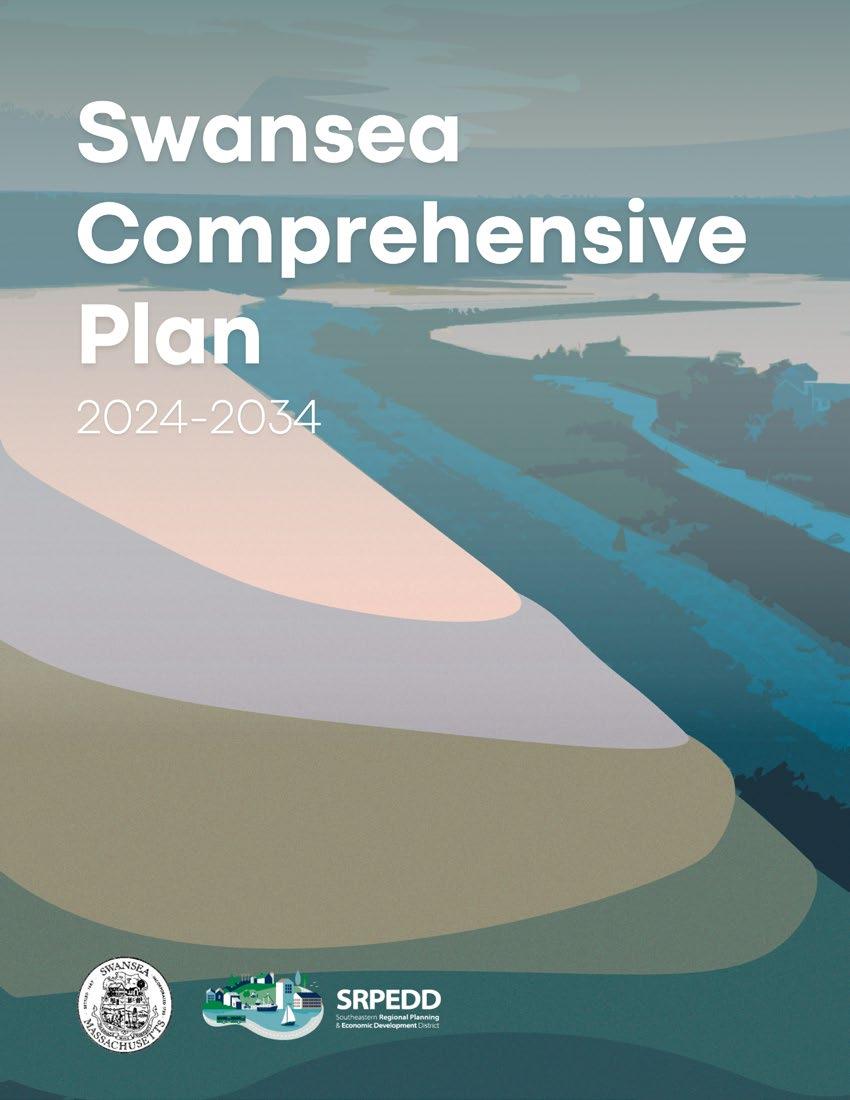

Federal Disclaimer, Title VI and Nondiscrimination Notice of Rights of Beneficiaries
The Southeastern Massachusetts Metropolitan Planning Organization (SMMPO) through the Southeastern Regional Planning and Economic Development District (SRPEDD) operates its programs, services, and activities in compliance with federal nondiscrimination laws including Title VI of the Civil Rights Act of 1964 (Title VI), the Civil Rights Restoration Act of 1987, and related statutes and regulations. Title VI prohibits discrimination in federally assisted programs and requires that no person in the United States of America shall, on the grounds of race, color, or national origin (including limited English proficiency), be excluded from participation in, be denied the benefits of, or be otherwise subjected to discrimination under any program or activity receiving federal assistance. Related federal nondiscrimination laws administrated by the Federal Highway Administration, the Federal Transit Administration, or both prohibit discrimination on the basis of age, sex, and disability. These protected categories are contemplated within SRPEDD’s Title VI Programs consistent with federal interpretation and administration. Additionally, SRPEDD provides meaningful access to its programs, services, and activities to individuals with limited English proficiency, in compliance with US Department of Transportation policy and guidance on federal Executive Order 13166.
Individuals seeking additional information or wishing to file a Title VI/Nondiscrimination complaint may contact the SRPEDD Title VI/Nondiscrimination Coordinator at the contact information here. All such complaints must be received, in writing, within 180 days of the alleged discriminatory occurrence. Assistance will be provided, upon request, to individuals unable to provide the complaint form in writing.
Southeastern Massachusetts Metropolitan Planning Organization (SMMPO)
Title VI Coordinator -SRPEDD
88 Broadway, Taunton, MA 02780
Phone: 508 824-1367 or dial 711 to use MassRelay
Email: aduarte@srpedd.org
Massachusetts Public Accommodation Law (M.G.L. c 272 §§92a, 98, 98a) and Executive Order 526 section 4 also prohibit discrimination in public accommodations based on religion, creed, class, race, color, denomination, sex, sexual orientation, nationality, disability, gender identity and expression, and veteran’s status, and SRPEDD and the SMMPO assures compliance with these laws. Public Accommodation Law concerns can be brought to SRPEDD’s Title VI /Nondiscrimination Coordinator or to file a complaint alleging a violation of the state’s Public Accommodation Law, contact the Massachusetts Commission Against Discrimination within 300 days of the alleged discriminatory conduct.
The SMMPO is equally committed to implementing federal Executive Order 12898, entitled “Federal Actions to Address Environmental Justice in Minority Populations and Low-Income Populations” and Executive Order 13985 (2021) entitled “Advancing Racial Equity and Support for Underserved
Communities Through the Federal Government.”
In this capacity, the SMMPO identifies and addresses disproportionately high and adverse human health or environmental effects of its programs, policies, and activities on low-income and minority, including BIPOC, Asian or Pacific Islander populations, as well as religious minorities, LQBTQ+ persons, Limited English Proficient (LEP) persons or those who have a disability. The SMMPO carries out this responsibility by the consistent, fair, just, and impartial treatment of all individuals, and by involving underserved individuals in the transportation process and considering their transportation needs in the development and review of the SMMPO’s transportation plans, programs and projects.
English: If this information is needed in another language, please contact the MPO Title VI Coordinator at 508-824-1367 ext. 235 or at aduarte@srpedd.org
Spanish: Si necesita esta información en otro idioma, por favor contacte al coordinador de MPO del Título VI al 508-824-1367 ext. 235 o en aduarte@srpedd.org.
Portuguese: Caso estas informações sejam necessárias em outro idioma, por favor, contate o Coordenador de Título VI da MPO pelo telefone 508-824-1367, Ramal 235 ou em aduarte@ srpedd.org.
Haitian Creole: Si yon moun bezwen enfòmasyon sa a nan yon lòt lang, tanpri kontakte Koòdonatè a Title VI MPO nan 508-824-1367 ext. 235.
Simplified Chinese: 如果需要其他语言的此信息,请致电 508-824-1367 分机联系 MPO Titl e VI 协调员。 235 或发送电子邮件至 aduarte@srpedd.org 。
Simplified Chinese: 如果需要其他语言的此信息,请致电 508-824-1367 分机联系 MPO Titl e VI 协调员。 235 或发送电子邮件至 aduarte@srpedd.org 。
Traditional Chinese: 如果需要其他語言的此信息,請致電 508-824-1367 分機聯繫 MPO Tit le VI 協調員。 235 或發送電子郵件至 aduarte@srpedd.org 。
Mon Khmer Cambodian (Khmer): ប្រសិនបើព័ត៌មាននេះត្រូវការជាភាសាផ្សេង សូមទាក់ទង អ្នកសម្របសម្រួល MPO Title VI តាមរយៈលេខ 508-824-1367 ext ។ 235 ឬនៅ aduarte@ srpedd.org ។
Acknowledgments
This report was made possible with participation and technical assistance from the following:
Town of Swansea
John P. Hansen, Jr., AICP - Community Development Director
Mallory Aronstein - Town Administrator
Swansea Planning Board
Scott N. Adams, Chairman
Tim Cabral, Vice-Chair
Johnathan Carreiro, Clerk
Paul Waple, Member
Steven Bogle, Member
Swansea Select Board
Christopher R. Carreiro, Chairman
Robert C. Medeiros, Vice-Chair
Stephen H. Kitchin, Clerk
Comprehensive Plan Committee
Matthew Beane
Kelly O'Brien-Plante
Kim O'Donahue
Michele Paul
Pat Redfearn
Jeff Sutherland
Paul Treloar
Open Space and Recreation Plan Committee
Gil Almeida
Colleen Brown
Nanci Hedgcorth
Edward Hill

Southeastern Regional Planning and Economic Development District (SRPEDD)
Danica Belknap, CC-P - Environmental Planning Manager
Robert Cabral - Director of Housing and Community Development
Andrea Duarte - Transportation Outreach Coordinator
Lizeth Gonzalez - Director of Economic Development
Kevin Ham - Director of Homeland Security
Jackie Jones, AICP - Assistant Director of Transportation Planning
Maria Jones - Public Engagement and Communications Planner
Danyel Kenis - Urban Design Planner
Grant King, AICP - Deputy Director & Comprehensive Planning Manager
Taylor Perez - Assistant Director of Housing and Community Development
Chris Welch - Senior Comprehensive Planner
A special thank you to Howard Eaton and Raj Das for their generous permission to utilize their photography, which has been credited throughout this report.
Strategy 6.1-1 Ensure vulnerable populations, including older adults/senior residents, have access to air conditioning during heat events. .................................................................................
Strategy 6.1-2 Continue to explore opportunities to expand Swansea's water capacity through infrastructure improvements and new IMAs with neighboring RI communities and Somerset. 184
Strategy 6.1-3 Increase awareness of local evacuation routes, emergency shelters, and Town resources.
Goal 6.2 Increase coastal resilience through new programs and adaptation strategies.
Strategy 6.2-1 Allow compact, climate-resilient adaptations, including raised houses and vertical additions. 190
Strategy 6.2-2 Explore participation in FEMA’s Community Rating Service program to bolster flood mitigation town-wide while also reducing flood insurance premiums. ...................................... 194
Strategy 6.2-3 Evaluate the severity of coastal erosion and improve coastal buffers. 196
7.1-1 Explore the feasibility of upgrading Town-owned properties such as the Council on Aging, and the Town Annex to enable use of its facilities.
Strategy 7.1-2 Identify and implement appropriate modifications from the ADA Self-Evaluation & Transition Plan, with particular concern for seniors and individuals with disabilities at Town-owned facilities. 210
Strategy 7.1-3 Develop a non-profit to fundraise for causes that could benefit the Town, including but not limited to improvements for the Fire Station, Town Hall, or DPW Facility. ....................... 212
7.2-1 Increase the publicity and number of cultural and community events in town, including pop-ups, food trucks, seasonal lights, etc.
Strategy 7.2-2 Refine, update, and promote a monthly email / newsletter to provide updates on town initiatives, events, etc. .............................................................................................
Strategy 7.2-3 Create a Digital Equity Plan and explore funding resources to ensure internet access and digital
Strategy 8.1-1 Expand SRTA access throughout town and install new supportive infrastructure, including signage and bus shelters.
Strategy 8.1-2 Expand Town-facilitated ride services for older adults and individuals with disabilities.
Strategy 8.1-3 Establish a Traffic Safety Committee to receive traffic feedback from residents, identify safety issues in town, and suggest improvements. 234
Strategy 8.1-4 Work with MassDOT to conduct Road Safety Audits (RSAs) on state-owned roadways and intersections with a high number of crashes and safety concerns; implement items previously identified through RSAs.
Strategy 8.1-5 Continue to construct high priority “Complete Streets” improvements in Partnership with MassDOT.
Strategy 8.2-1 Pursue electric and hybrid options for town vehicle fleets and install additional electric vehicle charging stations along high-traffic routes.
Strategy 8.2-2 Consider adjustments to the South Coast Bikeway to route through Ocean Grove. 244
Strategy 8.2-3 Explore non-motorized transportation access to natural, cultural, and coastal
resources in town, including the creation of new walking, biking, and hiking trails. 246
Goal 8.3 Develop key routes to support economic development and improve quality of life.
Strategy 8.3-1 Conduct a mobility and land-use study on Route Wilbur Ave / Route 103 to explore creating a walkable, neighborhood center for Ocean Grove.

Photo 1. Old Providence Road. Kevin Ham, SRPEDD.

Introduction
Photo 2. Swansea Town Beach. Mallory Aronstein, Town of Swansea.

What is a Comprehensive Plan?
A Comprehensive Plan, also referred to as a Master Plan in Massachusetts General Law, can be many things. It is a narrative that tells the story of Swansea’s history and the experience of living in town today. It is a technical document that considers population, market, and land use changes to chart where the Town currently is and its course for tomorrow. It is a policy document that lays out a consensus vision for Swansea and articulates the strategies and actions that will help the town meet its goals. In short, it is a long-range plan that helps guide the town, that builds trust by making transparent decisions, and that bases those decisions on accurate information and public input
The State of Massachusetts requires that all cities and towns create and update a Comprehensive / Master Plan as needed. These plans frequently result in bylaw changes, participating in new state or federal programs, coordinated grant applications and infrastructure investments, updated and more efficient administration, and increased volunteerism, service, and stewardship in a community. More importantly, the Planning process is a meaningful opportunity for a city or town to come together as a community, to reassess its goals and priorities, and to set a course to achieve those goals over the next several years.
Statutory Elements
According to MGL c.41 s.81D, a Master Plan has nine required “elements.” They are:
1. The Statement of Goals and Policies sets out Swansea’s vision for the future. It presents community values, goals, and the land use objectives that will meet these goals.
2. The Land Use Element describes Swansea’s current and future land use patterns, including proposed locations for various types of activity, such as residences, businesses, and recreation, and the preferred relative intensity of development across the town’s diverse built landscapes.
3. The Housing Element creates a plan to meet the town’s housing needs, which are identified using demographic and market information.
4. The Economic Development Element identifies strategies for growing the town’s economy by building upon local strengths and bringing new and compatible opportunities to Swansea.
5. The Natural and Cultural Resources Element is an opportunity for Swansea to highlight and take stock of its natural, cultural, and historic resources.
6. The Open Space and Recreation Element describes existing open space and recreational facilities in town and aligns plans for future recreation and open space with project population needs.
7. The Services and Facilities Element identifies existing and anticipated needs for public infrastructure and services.
8. The Circulation and Transportation Element provides an inventory of existing and proposed transportation infrastructure and services across all modes including private cars, public transit, and bicycle and pedestrian routes.
9. The Implementation section provides a blueprint and schedule for making the master plan a reality.
We organize this plan so that each “element” is a single chapter. We’ve also included an additional chapter on Climate and Resilience to address climate change mitigation/adaption and sustainable development initiatives the Town of Swansea can pursue.
This Comprehensive Plan is organized by Element , where each Element has its own corresponding chapter. The appear in the following order: 1. Land Use; 2. Housing; 3. Economic Development; 4. Open Space and Recreation; 5. Natural and Cultural Resources; 6. Climate and Resilience; 7. Services and Facilities;
8. Transportation and Circulation; and 9. Implementation.
Each chapter contains a set of goals and strategies related to each element. Each goal has a number related to its chapter element (i.e., "Element"."Goal" ), and each strategy has a number that related to both the chapter element and corresponding goal (i.e., "Element"."Goal""Strategy" ). For example, the first strategy of Land Use Goal 1 will be labeled: 1.1-1.
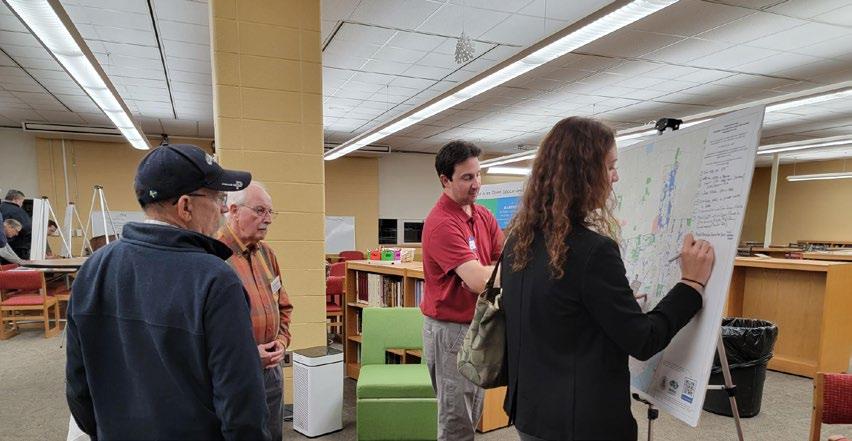
Community-Driven Planning
Input from residents is essential to ensuring a Comprehensive Plan accurately reflects the goals and priorities of the community that creates it. Participation from residents and local stakeholders is the best way to make sure that a Comprehensive Plan is authentic, actionable, and produces change that is driven by the community’s vision for their city or town.
Most of Swansea’s Master Plan public outreach process took place during the COVID-19 pandemic. As a result, this project’s public feedback was gathered through a variety of forums, including online and in-person workshops, social media, tabling events, and surveys. The Master Plan also sources feedback from the complementary Housing Production Plan’s public engagement process.
Housing Production Plan
This Comprehensive Plan’s Data Analysis and Housing Chapter shall also serve as the Town’s five-year Housing Production Plan. A Housing Production Plan (HPP), as defined by 760 CMR 56, is a document that shall contain at a minimum the following elements, covering a period of five years:
1. Comprehensive housing needs assessment;
2. Affordable housing goals; and
3. Implementation strategies.
Additional information about the data and outreach related to the Housing Production Plan will be available in the Appendix of this Comprehensive Plan.
Photo 3. Workshop attendees and Swansea Town Staff at the Transportation, Services, and Facilities Workshop. Taylor Perez, SRPEDD.

Photo 4. A workshop attendee at the Land Use, Housing, and Economic Development Workshop. Danyel Kenis, SRPEDD.
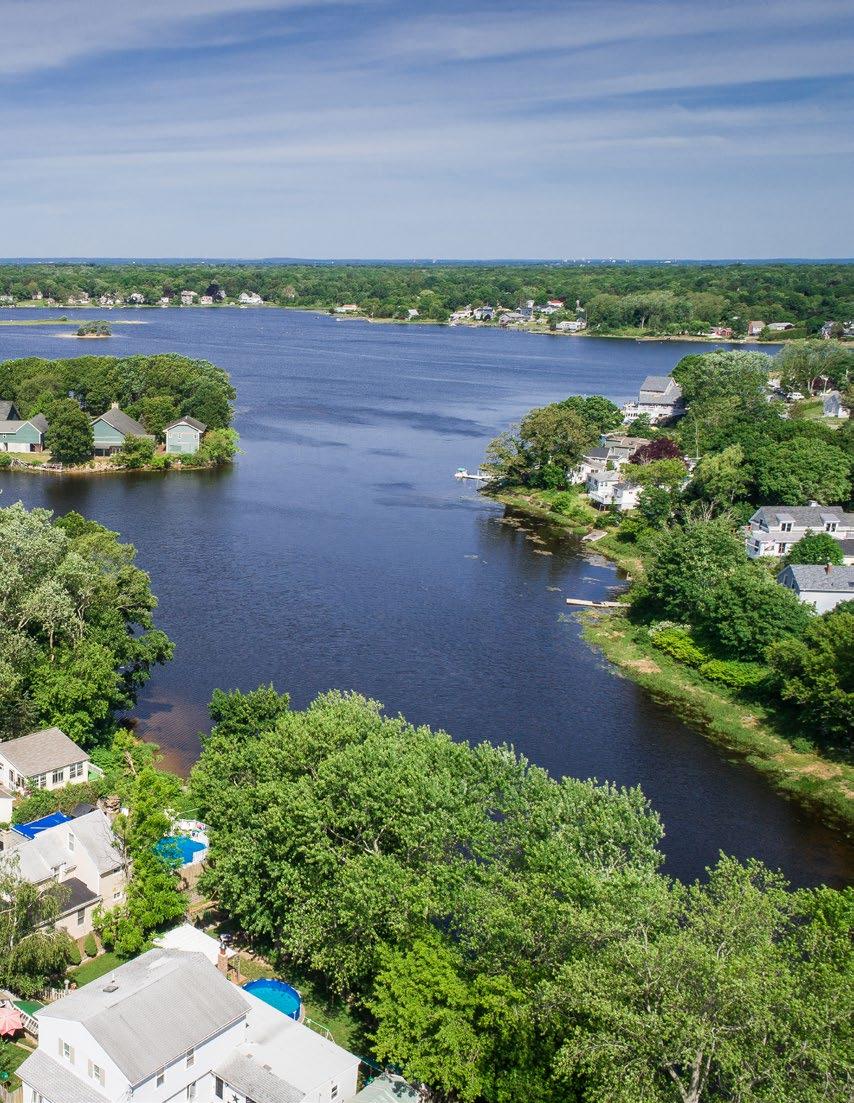
Photo 5. Ocean Grove. Kevin Ham, SRPEDD.
About Swansea
Swansea is a suburban town in westmost portion of Bristol County Massachusetts and is bordered by the Towns of Seekonk and Rehoboth to the north, the Town of Dighton to the northeast, the Town of Somerset to the southeast. The western border of Swansea is shared with the State of Rhode Island and the Towns of Warren and Barrington while the rest of Swansea’s southern coast sits atop the upper end of Mount Hope Bay. Interstate 195 and Route 6 runs through Swansea, connecting residents and business from across state lines and throughout the Southeast region of Massachusetts.
In its early days, Swansea remained a predominantly rural community centered around farming, fishing, and shipbuilding; yet its position in between larger cities like Fall River and Providence pushed the town to develop corridors to keep up with economic demands throughout the Industrial period. Suburbanization, rapid highway construction and commercial growth in the post-War period produced a substantial amount of the development and road infrastructure we see in town today. Swansea saw its largest period of growth in the 1930s and 1960s.
Today, Swansea functions as a retail hub with some densely populated residential neighborhoods, including Ocean Groove and Smoke Rise, as well as several rural residential pockets scattered across town. Route 6, 118, 103 and I-195 have spurred growth along its corridors and attracted several impactful commercial developments – the largest being the Swansea Mall, which has been the subject of ongoing redevelopment in recent years.
Swansea has seen significant population growth over the past decade and a regionwide and national shortage on housing, alongside a need to continue to grow the Town’s tax-base continues to place pressure on creating new residential and commercial development. Housing costs continue to increase as the town’s population ages and school age populations decrease while commercial and residential growth pose a potential threat to the natural environment.
The 2024 Comprehensive Plan along with the Housing Production and Open Space and Recreation Plans aim to equip Swansea with the planning tools necessary for economic prosperity while maintaining the town’s historic small-town character.
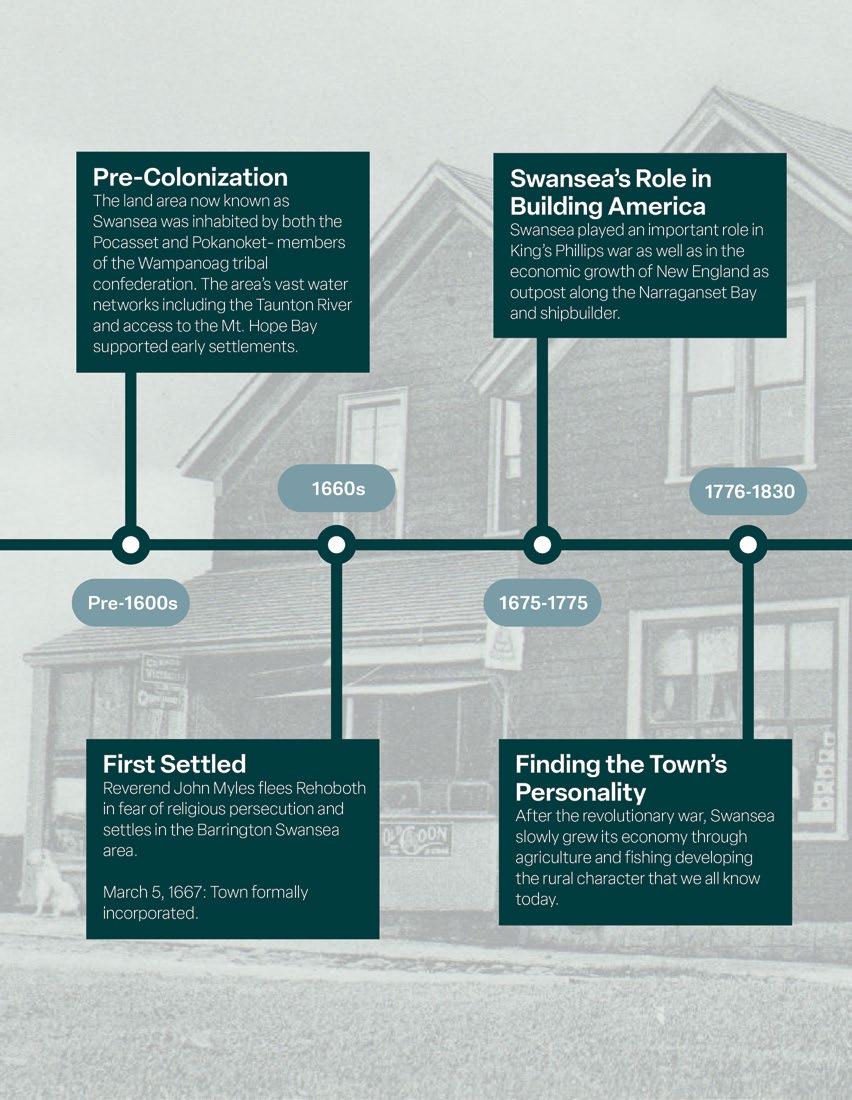
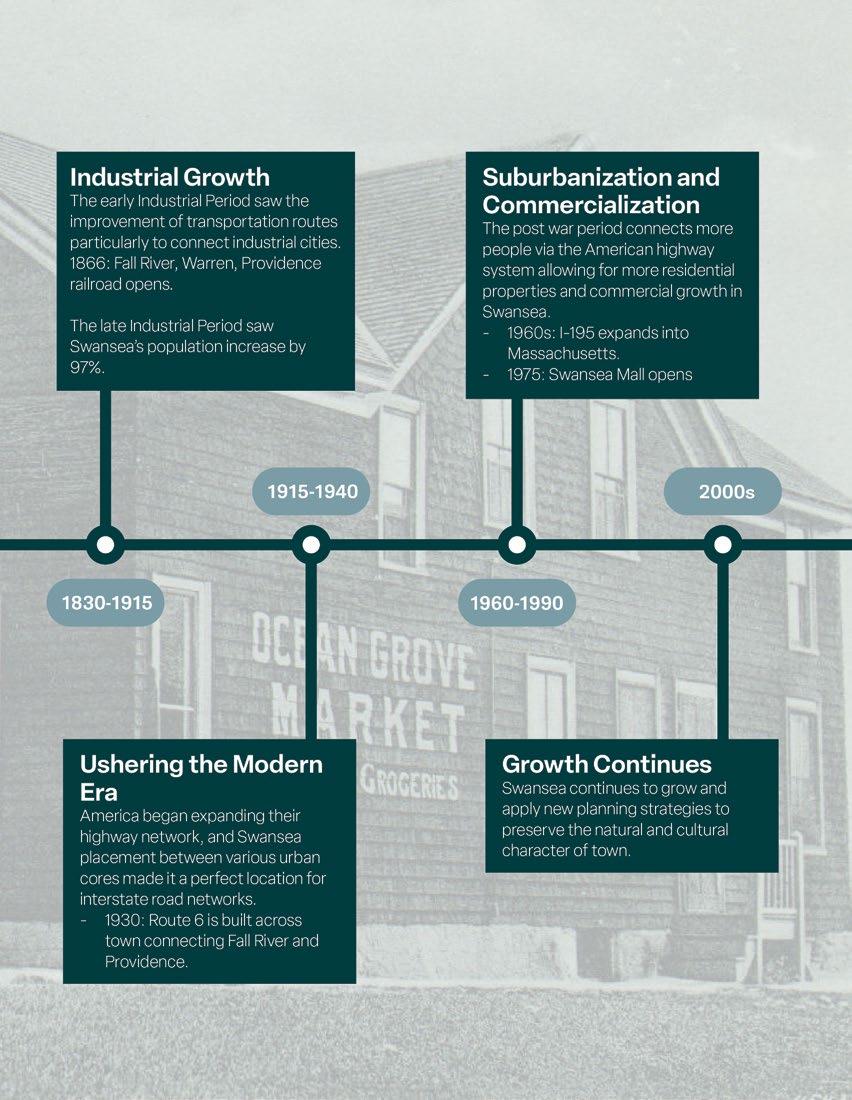
Photo 6. A historic photo of Ocean Grove Market in Swansea. Swansea Historical Society.
Swansea in Numbers
Data Sources and Definitions
In addition to direct input from the public and town decision-makers, the Comprehensive Plan relies on data from a variety of sources to help tell Swansea’s story. Below we’ve described some of the sources you’ll see referenced most often throughout the report.
American Community Survey (ACS)
The American Community Survey, or ACS, gathers data on a sample of the population through monthly surveys US Census Bureau produces on topics including housing, jobs, education, and more. The Five-Year (5-Year) ACS shows data that has been collected and aggregated over a five-year period.
The Decennial Census is a count of the entire population conducted and released every 10 years. These data sources have some overlap, but also gather information on separate topics.
Department of Housing and Urban Development (HUD)
The Department of Housing and Urban Development (HUD) maintains data on a variety of topics related to housing nationally. Here it is used to determine the Income Limits for subsidized affordable housing.
The Warren Group
The Warren Group is a real estate entity that provides data and information on real estate trends, property transactions, and mortgages.
ESRI Business Analyst
Geographic Information Systems (GIS) software provider ESRI offers an online mapping service called Business Analyst that allows users to run market analyses on specific geographies. Here, it is used to retrieve population and housing unit projections out to 2027.
Massachusetts Executive Office on Labor and Workforce Development
Massachusetts’ Executive Office on Labor and Workforce Development (EOLWD) creates and oversees workforcerelated services, such as workers’ rights protection and workers’ safety. They also manage workforce-related data related to employment, industry, and labor markets.
MassGIS
MassGIS is the Commonwealth's Bureau of Geographic Information, which has data on many topics, including environmental features, water resources, tax parcels, and infrastructure.
The Different Types of Median Income
There are two important income figures we will cite frequently throughout this plan:
• The Area Median Income (AMI), or 100% AMI. Area Median Income describes the midpoint of a specific region’s household income. It is used to determine the income eligibility requirements for State and Federal housing programs. When discussing eligibility, HUD defines Income Limits, ranging from roughly 30% (and below) to roughly 80% of an AMI as eligible for subsidized housing. The two AMI figures we will reference are:
○ 100% AMI, which is $106,000. This is the median household income for a family of four in the HUD region Swansea belongs to.
○ 80% AMI, which is $81.900. This is approximately 30% of $106,000 and is the income limit at which a family of four becomes eligible for subsidized affordable housing.
• The Town Median Income, which represents the median income of all residents in town. This data comes from the Census 5-Year ACS. In Swansea, the median income as reported on the 2021 5-Year ACS was $101,703.
Swansea's HUD Region:
HUD creates its own regional groupings, with Swansea grouped into the “Providence-Fall River RI-MA HUD Metro FMR Area.” The grouping includes the following cities and towns:
• Bristol County, MA: Attleboro, Fall River, North Attleborough, Rehoboth, Seekonk, Somerset, Swansea, Westport
• Bristol County, RI: Barrington, Bristol, Warren
• Kent County, RI: Coventry, East Greenwich, Warwick, West Greenwich
• Newport County, RI: Jamestown, Little Compton, Tiverton
• Providence County, RI: Burrillville, Central Falls, Cranston, Cumberland, East Providence, Foster, Glocester, Johnston, Lincoln, North Providence, North Smithfield, Pawtucket, Providence, Scituate, Smithfield, Woonsocket
• Washington County, RI: Charlestown, Exeter, Narragansett, North Kingstown, Richmond, South Kingstown
For more information about how HUD groups municipalities and their area definitions, see HUD’s Income Limits Documentation, FAQ Question 9
Population and Demographics
Swansea currently has a population of 17,144 as of 2020, a number which has increased by 8.1% since 2010. Like many communities in Southeastern Massachusetts and throughout the nation, Swansea’s population is aging –the median age in Town increased from 38 to 45 between 2000 and 2021.
A Note on Aging-Ready Housing
An individual’s housing needs are likely to change as they get older, due to changes in their income, mobility, household structure, etc. The Town should be prepared to assist residents who wish to “age in place” by providing new senior housing options or offering mechanisms to retrofit existing homes so that they are “aging-ready.”
According to the U.S. Census Bureau’s report on the housing needs of older adults, a home is considered “aging-ready,” if it has the following features:
• A step-free entryway
• A bedroom and full bathroom on the first floor
• At least one bathroom accessibility feature
• Additional aging-accessible elements that may be useful include:
○ Sink handles or levers instead of knobs
○ Handrails or grab bars in the bathroom
○ Built-in shower seats
• Housing features (such as thermostats, countertops, electrical outlets, etc.) that are at wheelchair accessible heights
Disability Status
As expected, older adults in Swansea have more disabilities than their younger counterparts, with about 18.3% of those aged 65-74 and 51.2% of those aged 75 or over having at least one type of disability. Hearing difficulties are the most common disability those over the age of 65 are experiencing in Swansea (13.7%), followed by ambulatory difficulties (having serious difficulty walking or climbing stairs; 11.9%) and vision difficulty (8.7%). The Town may wish to survey its older residents to determine their current living conditions and any needs for accessibility or housing modifications.

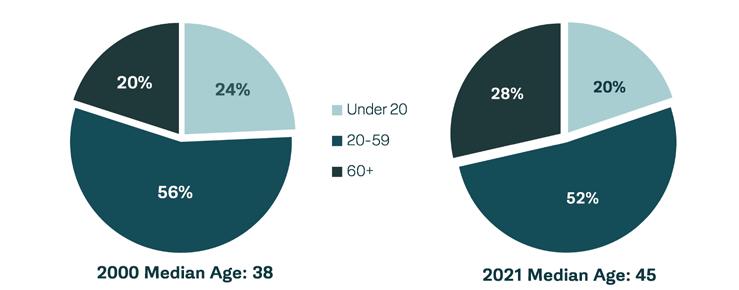
Figure 1. Population Change; ACS 5yr Estimates.
Figure 2. Age Trends; U.S. Decennial Census and ACS 5yr Estimates.
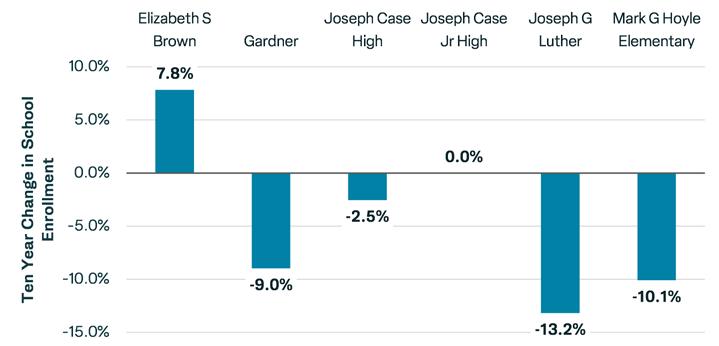
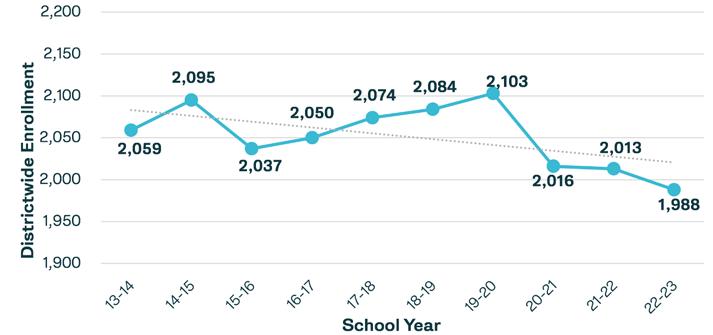
Figure 3. School Enrollment Ten Year Change by School; MassDESE.
Figure 4. School Enrollment Ten Year Change; MassDESE.

School Enrollment
The number of school age residents (those under 20 years old) has decreased, with a steady decline of approximately 13% from 2000 to 2021. School enrollment has reflected this trend and declined steadily over the past decade, with a loss of 71 students since 2013. This is notable when addressing any concerns regarding the potential impact of additional affordable housing development on the local school system. The Town may wish to explore this decrease in enrollment and its effect on the capacity for new students.
Population Projections
Swansea is predicted to decrease at a very modest rate, then begin to decrease, according to UMass Donahue Institute, which projects population and housing unit changes for 2025 and 2030. Between 2025 and 2030, growth is expected to occur at a rate -1.4%, losing 231 residents and 125 owner occupied housing units, but losing 51 rental housing units
Figure 5. Total Population and Projected Population Change; U.S. Decennial Census and UMass Donahue Institute.
Market Conditions and Affordability
There are two types of affordable housing we’ll be discussing throughout the Plan: “naturally occurring” affordable housing and subsidized affordable housing. Let’s explore each concept in more detail.
“Naturally Occurring” Affordable Housing
“Naturally occurring” affordable housing is available without subsidies and at lower price points when the right regulatory and market conditions exist for its development. In this case, the word “affordable” doesn’t mean “subsidized” - rather, it builds on the idea of not being cost-burdened, which is a term used to describe whether a household is paying 30% or more of their annual income on basic living costs, such as their mortgage or rent plus utilities. When we are discussing naturally occurring affordable housing, we are talking about homes that are affordable enough that they will not cause a young family, older couple, or household with limited/fixed income to become costburdened. Think of starter homes, homes for downsizing, and apartments for recent graduates, among other types of housing units.
In Swansea, 840 households are costburdened, and 650 households are
severely cost-burdened (paying more than 50% of their income on housing), totaling approximately 10% of all households in town.
Subsidized Affordable Housing
Subsidized affordable housing is just that — housing that is subsidized by a public agency, non-profit, or limited dividend company. Subsidized affordable housing contains deed restrictions, meaning its availability remains restricted to certain populations (e.g., 55+ housing) and/or to incomes at or below 80% of the area median income (AMI)*, which is the median income for a certain geographic region. In the case of Swansea, the area median income (FY22) for a family of four is $97,600. This means that any household of four making at or less than $77,350 (which is approximately 80% of $97,600) is qualified to apply for subsidized affordable housing. Per M.G.L. c. 40B, the Commonwealth of Massachusetts requires at least 10% of a city or town’s housing stock to be subsidized affordable housing.
As of September 2023, Swansea’s Subsidized Housing Inventory consisted of 243 units of 6,817 total year-round housing units, or 3.56% of the housing stock.
What Qualifies on the Subsidized Housing Inventory?
In order for a unit to officially contribute to a community’s Subsidized Housing Inventory count, several criteria must be met:
• It must be part of a “subsidized” development subject to a regulatory agreement where a Subsidizing Agency and monitoring agent have been identified.
• At least 25% of the units in the development must be income-restricted to households with incomes at or below 80% of the area median income, corresponding to their household size, and have rents or sale prices restricted to affordable levels.
○ Restrictions must run at least 15 years for rehabilitation, 30 years for new rental construction, and in perpetuity for new homeownership construction.
• Resident selection for the Affordable Units must comply with the requirements of a lottery or other fair and equitable procedure, including an Affirmative Fair Housing Marketing and Resident Selection Plan, approved by the Subsidizing Agency and without regard to the amount of their assets.
Table 1. FY23 HUD Income Limits for the Providence-Fall River RI-MA HUD Metro FMR Area.
Table 2. Job Change by Industry; EOLWD.
Industry and Economy
Tax Rates
Swansea’s residential tax rate of $13.05 per $1,000 is slightly lower than nearby towns, such as Somerset and Seekonk. Its commercial tax rate is significantly higher than the residential rate, at $21.21 per $1,000. However, most tax-producing properties in town are residential (80%), which minimizes the opportunity to realize the potential of increased commercial tax revenues.
Employment
Swansea’s primary employment industries primarily include the services and information sectors, with the construction industry also maintaining a significant portion of the town’s workforce. Retail trade, Swansea’s highest employment category accounted for 1,483 of the town’s 5,406 average monthly employees in 2022. Additional prominent industries include healthcare (1,007 employees); leisure and hospitality (648 employees); Construction (407 jobs); and Finance, Insurance, and Real Estate (403 employees). The largest employers in town are Walmart Supercenter (250-499 employees), Cardi’s Furniture, Country Gardens, Meadowridge Inc., Target, and Venus De Milo (100-249).
Income Trends
Swansea an affluent community when it comes to income, with a median household income of $101,703 as of 2021, 13% higher than the state median income and 28% higher than Bristol County’s median income. Of all the households in town, 1 in 2 (50.70%) make $100,000 or more annually. The Town should ensure effort is made to adequately address the housing needs of lower- and moderate-income residents in town, as these issues can often go overlooked in more affluent communities.
Figure 6. Income Trends; ACS 5yr Estimates.

Land Use and Housing Stock
Land Use Characteristics
Most of the Swansea’s land is dedicated to lower-density, single family housing, which comprises roughly 36% of the town’s land area. Multi-family residential, conversely, comprises roughly 3% of Swansea’s land. The areas along Route 6 and Route 118 are home to most of the town’s largest format commercial development, with smaller format commercial development occurring along Route 103 / Wilbur Avenue – overall, commercial development accounts for 7.5% of Swansea’s land area. There are significant areas of open space and critical habitat along Hortonville Road and Locust Street with additional open space near the Palmer River at the Swansea Country Club, as well as the properties to the southeast comprising nearly a third of the town’s land.
Housing Stock Characteristics
Much of Swansea’s existing housing stock predates 2000. A majority of housing units are detached single-family homes and units with 2-3 bedrooms. Older homes may necessitate more rehabilitation and repairs than newer homes, which, depending on the renovation, can be costly and temporarily displace residents. As a result, Swansea should work to ensure there are programs to help residents, particularly low/ moderate income households and older adults, live safely in their homes, either through accessibility- or safety-related renovations and repairs. The Town may also wish to incentivize the production of studio and 1-bedroom homes to accommodate individuals living alone and those who may not otherwise be able to afford and/or need a 2-3 bedroom home.
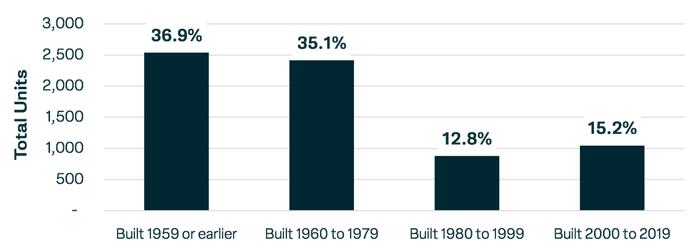
Figure 7. Housing Units Year Built; ACS 2021 5yr Estimates.

Photo 7. Aerial shot overlooking a residential subdivision and forest in Swansea. Kevin Ham, SRPEDD.

This map shows potential new growth in Swansea, or "all technically possible" growth in town. This doesn't mean all of the growth shown will occur. Instead, it shows what is possible under the current zoning if each parcel was fully built out and/or subdivided.
Map 1. Technically Feasible Growth; Swansea Land Use Model.
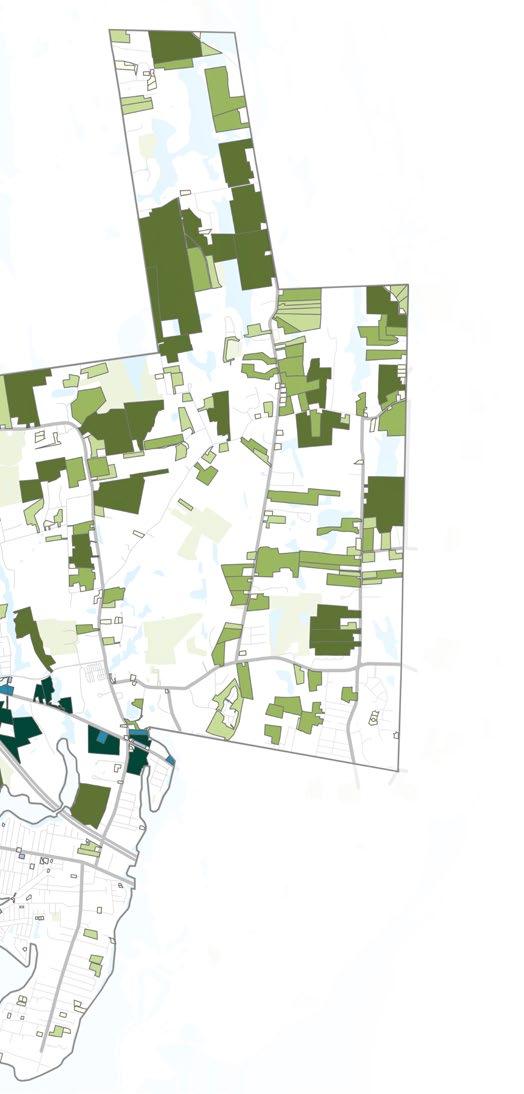
Land Use Modeling
As part of Swansea’s Comprehensive Plan, SRPEDD conducted a ‘build out analysis’ to model future land use. This analysis considered the town’s current zoning, its capacity for growth (all growth that is technically possible in town), and its demand for growth. Using this information, SRPEDD modeled 3 potential scenarios for Swansea: low growth, medium growth, and high growth. These scenarios provided some valuable background and context for the Comprehensive Plan. Growth, over the next 20 years ranged from 69 to 707 single family homes in Swansea with roughly 11 jobs added during this time.
While the projections in this model describe the potential growth that could occur, one of the primary roles urban planning can play is to guide growth and change. For example, folks in town made it clear they would like to see additional development along Routes 6, 118, and 103 – changing the zoning in these areas and creating business or ‘main street’ corridors could focus some of the projected development in these areas, while other goals and strategies in this plan identify ways to preserve open space in other areas of town.
Open Space and Natural Resources
Swansea is home to a wealth of open spaces that provide areas for sports, hiking, wildlife viewing, passive recreation, and fishing. These spaces include ballfields, hiking trails, the Town Beach, working farms, protected former farmlands, as well as sensitive and critical estuarine, coastal, and wetland systems.
Many of town’s coastal and more heavily forested areas serve as essential habitat for several rare, threatened, and endangered species. As of 2020, over 1,000 acres of the town enjoy permanent environmental protections that restrict development; another 965 acres of land are subject to Chapter 61, which provides temporary protections and the “right of first refusal” to the community for the purchase this land if the owner decides to terminate the protections on these properties. Recognizing the importance of these ecological systems for the entire region, Town, regional nonprofits, and community groups have had success identifying and targeting for acquisition, many important open spaces and natural resources for preservation.

Map 2. Key Habitat and Landscape Areas; MassGIS.
This map shows BioMap3, a tool created by The Nature Conservancy, and Priority Habitats of Rare Species, which shows the geographic boundaries of habitats of species listed in the Natural Heritage & Endangered Species Program's database within the last 25 years.

Data Takeaways
Based on an initial review of Swansea’s existing conditions, we can see several important trends and takeaways:
• Swansea’s population is aging, and school enrollment declined slightly over the last 10 years;
• Swansea’s population over the last 10 years has not seen as much growth as Bristol County and Massachusetts, and its population is projected to slightly decline over the next 7 years;
• Swansea has a high median income compared to the County and the State;
• Swansea’s home sales have started to decline over the 3 years and home sale prices continue to rise, like in the County and State;
• Swansea's tax base is largely dependent on residential uses, which may limit the Town's ability to leverage its commercial tax;
• Swansea has an abundance of key natural resources, habitats, and open spaces.


Photo 8. Sunrise in Ocean Grove. Howard Eaton.
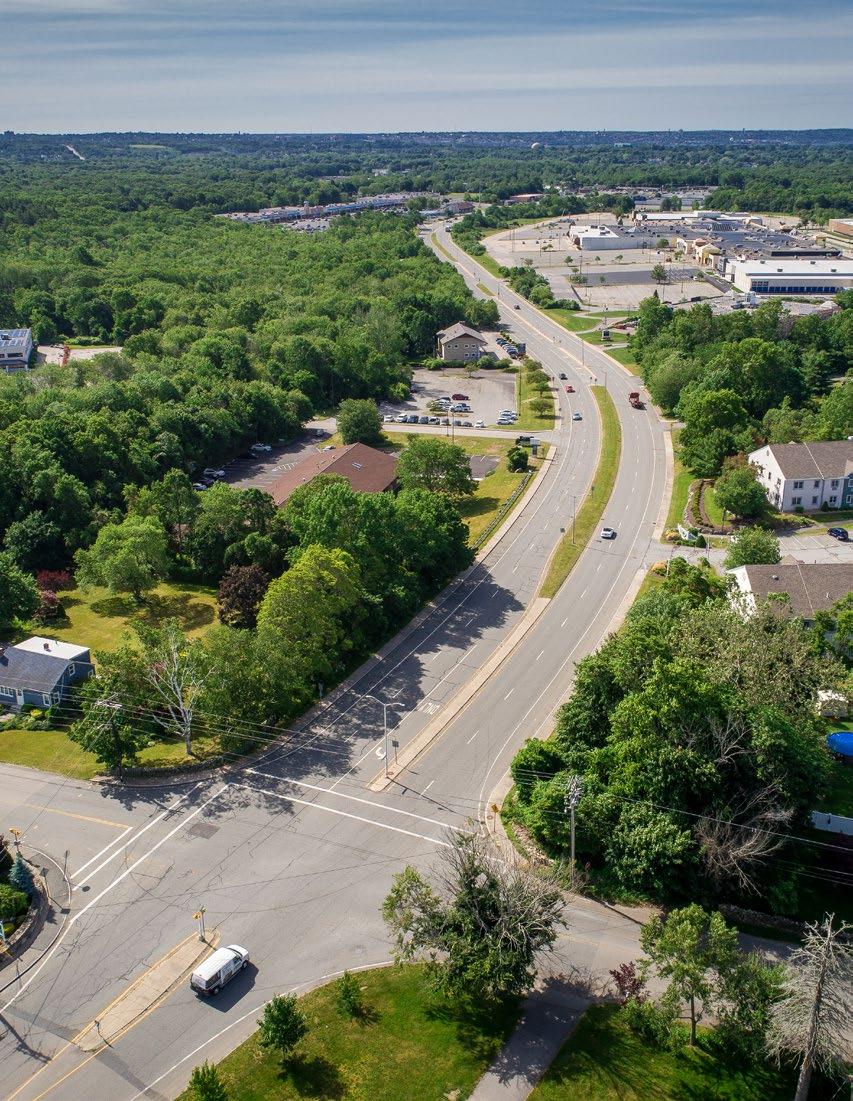
Element 1: Land Use
Photo 9. Route 118 looking south. Kevin Ham, SRPEDD.

In Summary: Land Use
From Swansea’s ballfields to the Town Beach to its residential neighborhoods, there are many features that provide folks a deep connection to living here. Primarily a residential town with large amounts of open space; it also maintains business corridors along Routes 6, 118, and 103; and industrial zoning south of Route 118. While most of Swansea’s zoning traditionally allows only large-lot residential dwellings, recent overlay districts such as the Swansea Mall Redevelopment Overlay District (2019) and the Swansea Marijuana Overlay District (2023) encourage business development in targeted, business-friendly locations, and in the case of the Swansea Mall District, an opportunity for denser housing development.
Despite many aspects that make the town great, public feedback highlighted potential areas for improvement. During the Comprehensive Plan’s feedback sessions, participants expressed a desire to see change and development along Route 6, Route 118, and the incorporation of local business in some of the more densely developed areas in Swansea. Additionally, the Comprehensive Plan’s feedback also highlights a desire to see certain aspects of Swansea’s land use pattern preserved: its ecologically sensitive natural spaces, the coastline, and its ongoing tradition of farming. This land use chapter attempts to utilize all the feedback from the Comprehensive planning process to balance these considerations.
Map 3. Potential Zoning Changes by Focus Area.
Goal 1.1 Review zoning by-laws to improve clarity and focus development in key areas in town.
This first goal looks at areas for development along Route 6, Route 118, Ocean Grove, and Main Street, amongst others. Residents in town expressed a desire to see some level of growth in all these areas. However, each of these locations is unique – what will work on Route 6 will be different than the type of development that would be successful in Ocean Grove. To see each of these locations develop in alignment with local desires, the Town will need to provide clarity and appropriate detail to its zoning code. By making some important modifications, Swansea will be in a strong position to focus its development to meet the needs of current and future residents.
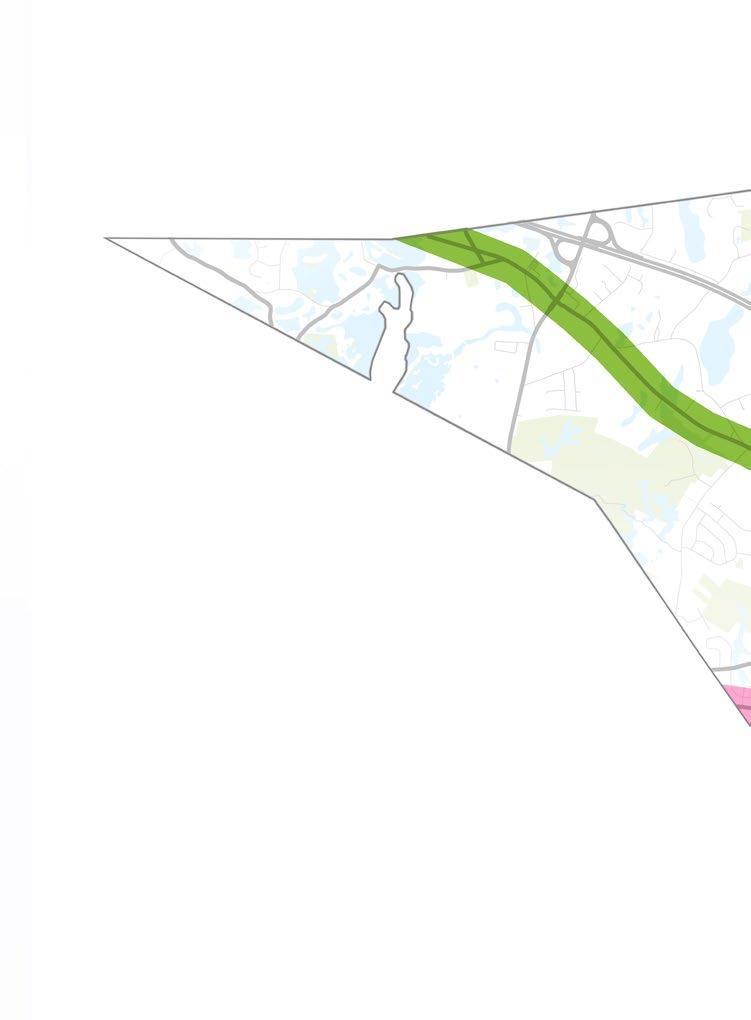
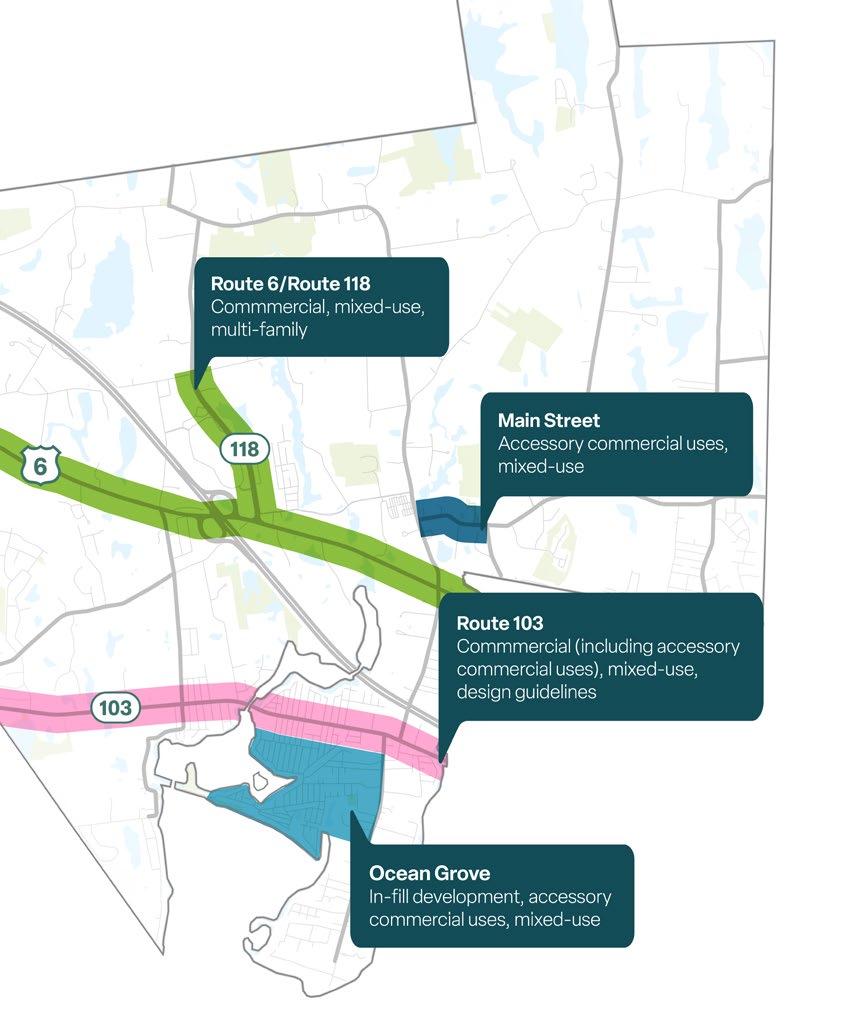
Strategy 1.1-1 Create path for the rectification of split-zoned lots and rezoning of lots with nonconforming uses.
Performance Measures
Priority: High
Year 1: Town identifies instances of split-zoned properties in Swansea.
Year 2: Town leadership identifies remedies for split-zoned properties and proposes appropriate amendments to the zoning by-law.
Year 2-3: Town passes necessary amendments to the zoning by-law.
Complementary Goals and Strategies
1.1-3 Explore zoning changes to allow mixed-use, commercial development, and accessory commercial use, by-right, in key neighborhood centers such as Ocean Grove, Main Street, and portions of Route 6.
3.2-1 Identify constraints that are limiting the development of small businesses and inventory locations in town where they may thrive while connecting these businesses to funding sources.
3.3-3 Update and publicize Swansea's user-friendly Development and Permitting Guide to facilitate business development.
Responsible Party
Planning Board, Town Planner, and Zoning Board of Appeals
Split-zoned lots, as well as lots with nonconforming uses present two related, but common situations where property owners must navigate subtle, and sometimes unclear language in a Town’s zoning code:
• In an instance of a Split-lot zoning, a single parcel may find itself located across two different zoning districts. For example, a portion of a parcel may be in a commercially zoned area and another portion in a residentially zoned location. This presents a complex and confusing process for most property owners, or it could generate possible avenues for savvy developers who are looking to use a property in a way that conflicts with a location’s current land-use context.
• Similarly, non-conforming uses typically exist in instances where a property’s current use was allowed at the time it began operation, but the zoning code has since been changed, and no longer allows
that use in the case of new construction or because of significant alterations. While the zoning code may be legally straightforward in these instances, it may seem at odds with the land-use pattern in a certain location or community, leading to confusion for a current or prospective property owner.
Swansea is similar to many communities across the Commonwealth that have instances of both split-zone and nonconforming uses. In both cases, the Town could examine where its current zoning conflicts with local land-use patterns that already fit the intended direction for the town’s development. Doing so will also streamline the development and permitting process, making decisions about a property easier to understand for current and future property owners.
Strategy 1.1-2 Allow the sub-division of nonconforming lots in Ocean Grove to generate more developable parcels.
Performance Measures
Priority: High
Year 1: Town identifies parcels that could be affected by allowing subdivision of lots in Ocean Grove.
Year 2: Planner and associated staff identify the feasibility of and mechanisms for providing subdivisions to lots over 10,000 square feet in Ocean Grove.
Year 2-3: Draft and presentation of appropriate amendments to the zoning by-law.
Year 3: Adoption of zoning by-law amendments.
Complementary Goals and Strategies
1.1-4 Implement key zoning amendments to create new housing opportunities for first time homebuyers, older adults wishing to downsize, and those with moderate or fixed incomes.
3.2-1 Identify constraints that are limiting the development of small businesses and inventory locations in town where they may thrive while connecting these businesses to funding sources.
8.3-1 Conduct a mobility and land-use study on Route Wilbur Ave / Route 103 to explore creating a walkable, neighborhood center for Ocean Grove.
Responsible Party
Planning Board, Town Planner, and Zoning Board of Appeals
Most of Swansea, including much of the Ocean Grove neighborhood, is zoned as Rural Residential. This district restricts lot sizes to a minimum of 30,000 Square Feet (increased to 60,000 when over an aquifer). This larger lot size is inconsistent with the current average lot size in Ocean Grove, whose parcel layout of 5,000 square feet mostly pre-dates the current iteration of Swansea’s zoning code.
Due to sandy soils in this coastal neighborhood, the Town has been able to successfully navigate the current onthe-ground level of density with septic systems and provides reason to believe that the 5,000 square foot lot size would be an environmentally manageable density
to pursue in Ocean Grove, moving forward. Should Swansea expand its sewer system, it could also extend into the neighborhood, if feasible. This should be coupled with a close examination of floodzones and sea-level rise projections.
The Town should conduct a study to test the feasibility of and explore mechanisms to allow subdivisions of lots over 10,000 square feet that could successfully become two 5,000 square foot (or larger) parcels. Doing so would free up the development potential for over 85 potentially conforming lots in one of Swansea’s most desirable and historically significant neighborhoods, while encouraging walkability, smaller-scale construction, and an increased supply of housing in town.

Photo 10. Residential Neighborhoods in Swansea. Kevin Ham, SRPEDD.
Strategy 1.1-3 Explore zoning changes to allow mixed-use, commercial development, and accessory commercial use, by-right, in key neighborhood centers such as Ocean Grove, Main Street, and portions of Route 6.
Performance Measures
Priority: High
Year 1-2: Conduct detailed analyses of key areas to identify potential district locations for mixed-use commercial areas.
Year 3: Develop draft regulations and design guidelines for appropriate district(s)
Year 4: Adopt mixed-use by-law and guidelines.
Complementary Goals and Strategies
1.1-1 Create path for the rectification of split-zoned lots and rezoning of lots with non-conforming uses.
1.2-1 Explore implementing zoning mechanisms to preserve open space and natural resources in town, such as a Transfer of Development Rights By-law or an amended Open Space Residential Design By-law.
3.2-1 Identify constraints that are limiting the development of small businesses and inventory locations in town where they may thrive while connecting these businesses to funding sources.
Responsible Party Planning Board and Town Planner
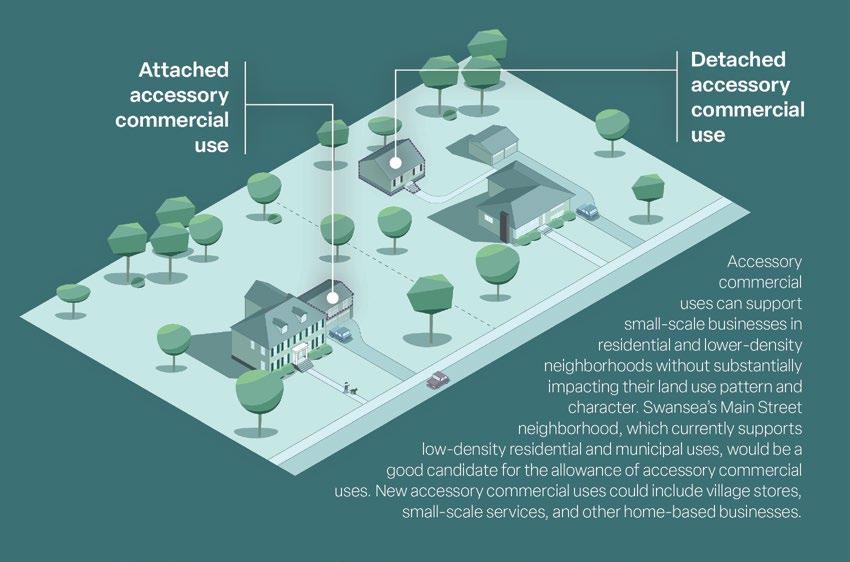
Swansea should consider implementing overlay districts with design standards to provide increased flexibility at key neighborhood centers throughout town, such as Ocean Grove, Main Street, and portions of Route 6. The Town Planner, Planning Board, and relevant stakeholders can work to ensure that the fit for each mixed-use overlay is appropriate for the area that is receiving it – for example, the size of buildings and intensity usage for a development in Main Street will want to be more modest in scale and consider a more-restrained use table
than what the former Swansea Mall site can and should accommodate.
In addition to the Town’s inventory of vacant commercial-industrial sites, the Comprehensive Plan has identified a number of development sites. For more detailed profiles on these sites, refer to Economic Development Strategy 3.1-1: Pursue additional studies and funding to implement design standards and improvements for identified economic development sites.
Strategy 1.1-4 Implement key zoning amendments to create new housing opportunities for first time homebuyers, older adults wishing to downsize, and those with moderate or fixed incomes.
Performance Measures
Priority: High
Year 1-3: Evaluate the above measures and implement alongside or as part of other Complementary Goals and Strategies in this Plan, as well as ongoing town-wide initiatives.
Complementary Goals and Strategies
Goal 2.2 Produce housing options for older adults to support aging in place and for adults with disabilities and/or chronic illnesses.
Responsible Party
Planning Board, Town Planner, and Select Board
Zoning changes are one of the main tools available for increasing affordable housing production in a Town. This plan recommends that Swansea should amend its zoning bylaw by modifying existing districts or creating new ones, with the goal of encouraging higher density development in strategic locations, reducing barriers for multi-family units, or actively pursuing development for populations without existing housing options (e.g., retirement-age residents, first-time
homebuyers, low-income residents).
There exist significant barriers to producing the volume and types of housing that could contribute to naturally occurring and subsidized affordable housing due to most of Swansea’s land area being dedicated to single-family housing with large lot requirements. To address this, Swansea has several zoning-related options it could pursue, described below.
1. Implement mixed-use zoning to be by-right along Routes 6, 118, and 103, as well as in other key areas identified by Town staff.
2. Allow accessory dwelling units (ADU’s) by-right – these currently require approval from the Special Permit Granting Authority).
3. Consider zoning changes to encourage "starter homes," tiny homes, or smaller-sized structures and lot sizes by the creation of a new residential zone with square foot lot size requirements in the range of 10,000 to 20,000 square feet – particularly in areas where the current land-use pattern is currently comprised of smaller lot sizes.
4. Consider a 40Y Starter Home District, when the Commonwealth releases future guidelines for producing this zoning.
Many of the above strategies will help shift the housing dynamic in town from the construction of large and very expensive homes towards more affordable options that will allow first time homebuyers to purchase in town and for those who have been living in Swansea, but wish to downsize, to find affordable and manageable options to age in place.
Strategy
1.1-5 Pursue zoning changes or development proposals in concert with the findings on the Route 6 Study.
Performance Measures
Priority: High
Year 1: Review findings and prioritize relevant parcels according to their development potential to identify those that are most actionable.
Year 1-2: Pursue development agreements for development-ready locations.
Year 3-4: Pursue any appropriate zoning changes.
Complementary Goals and Strategies
Goal 3.1 Explore new development opportunities along Route 6.
8.3-2 Implement findings from Route 118 and Route 6 Studies.
Responsible Party
Planning Board, Town Planner, and Zoning Board of Appeals
Swansea is currently in the process, alongside SRPEDD and FXM, of producing a detailed analysis of development opportunities along Routes 6 and 118. In addition to understanding the potential implications that sewer expansion would unlock in this area, the study explores the potential zoning changes that could contribute to the type of commercial, industrial, and residential development that the town would like to see and aligning this potential with the value of underutilized parcels along the corridor.
As the study wraps up, Swansea can utilize the data associated with particular parcels or groups of parcels as a basis for the pursuit of development – this might mean advocating for a potential zoning amendment that is
holding back development potential along Route 6, or it could mean a more direct acknowledgment, or renewed frame of thinking regarding the land value of particular parcels along the Route that may become a basis for discussion with developers looking to develop these parcels.
Following the information released as part of the study, the Town should utilize these findings as a framework for pursuing development changes, along Route 6, via partnership with a willing developer; those that may require zoning changes; or those parcels whose development potential requires the implementation of a sewer extension.
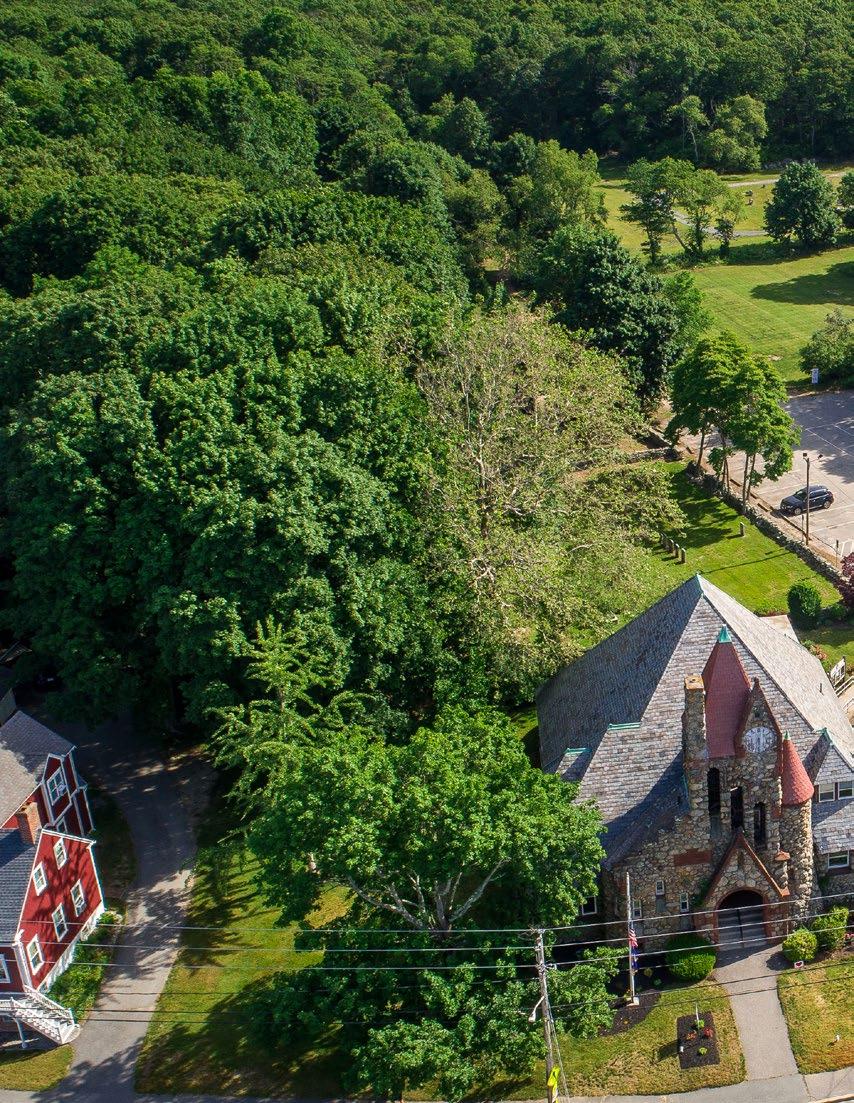
Goal 1.2 Create zoning mechanisms to preserve critical environmental and historic features.
Swansea is replete with environmental and historical features – many of which make it a unique place to live. However, like many communities throughout Southeastern Massachusetts, the town and its residents are balancing its critical features with broader regional growth and change. While Goal 1.1 focused on how to provide clear and concise zoning solutions to encourage growth in select areas, Goal 1.2 addresses how to do this in a way that preserves many of the aspects of Swansea that residents and visitors love.
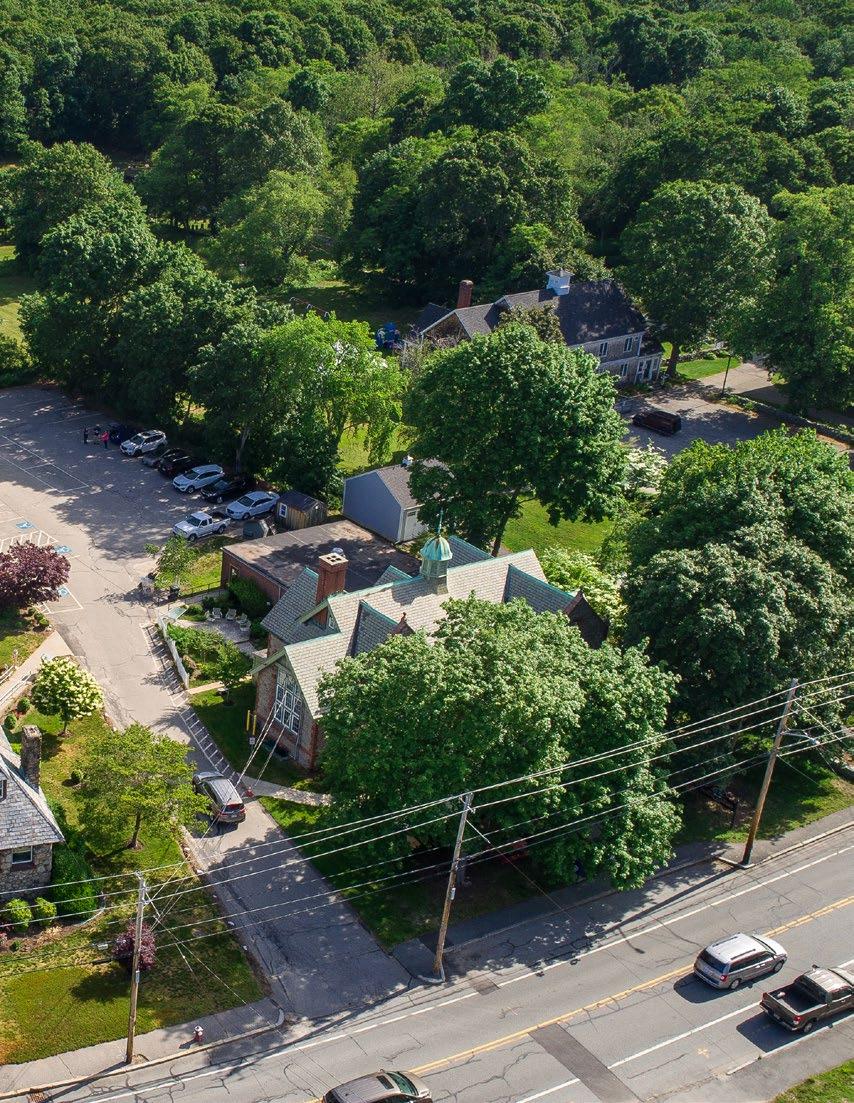
Photo 11. Swansea Town Hall and Main Street. Kevin Ham, SRPEDD.
Strategy 1.2-1 Explore implementing zoning mechanisms to preserve open space and natural resources in town, such as a Transfer of Development Rights By-law or an amended Open Space Residential Design By-law.
Performance Measures
Priority: High
Year 1: Begin an education campaign to explain the benefits of a TDR and evaluate the feasibility of the process.
Year 2: Begin public review process to establish TDR sending (preservation) and receiving (development) areas. Align this work with the town’s 2023 PDAs and PPAs.
Year 3 : Approve TDR bylaw by simple majority. Establish an intermediary “land bank” held by a conservation agency to streamline “swaps.”
Complementary Goals and Strategies
Goal 3.1 Explore new development opportunities along Route 6.
OSRP Goal 2
Responsible Party
Town Planner, Town Administrator, Redevelopment Authority
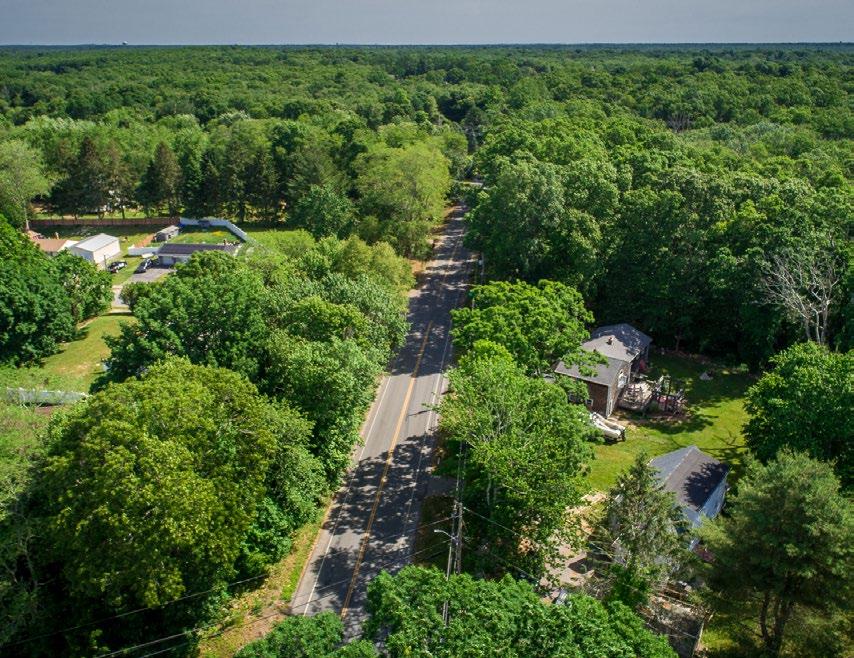
In Swansea – as is the case with most communities – residential development accounts for most of the new growth in town. This growth often takes the form of mediumto large-lot suburban homes that convert acres of natural spaces or agricultural uses into conventionally designed subdivisions of single-family homes.
During the Comprehensive Planning process, stakeholders expressed a desire to explore
zoning tools that might help Swansea better manage growth by looking beyond traditional subdivision development. Two common mechanisms are available to the town; these are the Town’s existing Open Space Residential Design (OSRD) bylaw and a potential new Transfer of Development Rights bylaw. The remainder of this Strategy will explore these two zoning tools in detail.
Photo 12. Residences in Swansea. Kevin Ham, SRPEDD.
Open Space Residential Design
Many of the main stated purposes of Swansea’s OSRD align with this Comprehensive Plan and its complementary Open Space and Recreation and Housing Production Plans:
• “to allow for greater flexibility and creativity in the design of residential developments;”
• “to encourage the permanent preservation of open space, agricultural and forestry land, plant and wildlife habitat, other natural resources including aquifers, waterbodies, wetlands, historical and archaeological resources;”
• “to encourage a less sprawling and more efficient form of development that consumes less open land and conforms to existing topography and natural features better than a conventional or grid subdivision;”
• “to encourage the provision of diverse housing opportunities and the integration of a variety of housing types;” and
• “to further the goals and policies of the local comprehensive plans and open space and recreation plans.”
Conventional
These diagrams show the differences between a conventional subdivision and an OSRD subdivision. Houses are clustered within the OSRD subdivision, preserving more open space and forest.
Despite this clear connection to many planning goals, the Town is not seeing its OSRD bylaw being applied in an optimal way. The fact that OSRD developments are more economical to construct than conventional subdivisions en courages developers to take advantage of the bylaw; however, the Swansea Town Planning Office reports that the resulting OSRD designs are not achieving the desired standard of open space protection. Swansea can consider amending the existing zoning language to further incentivize the use of OSRD in town, and to communicate the desired design standards more clearly for developers. These potential amendments include:
• Reduce and/or eliminate the eligibility requirements that parcels contain a minimum 10 acres and 5 lots to allow more flexibility to apply OSRD on smaller infill and redevelopment parcels
• Encourage more thoughtful consideration for sensitive environmental resources during the four-step required design process by specifying criteria for identifying the Primary and Secondary Conservation Areas in Step One
• To further provide “diverse housing opportunities,” as stated in the purpose of
the bylaw and consistent with Swansea’s Comprehensive and Housing Production Plan goals, enable multifamily housing, including duplex and townhouse-style housing units, in OSRD developments
• Consider enabling density bonuses as an incentive to developers and to encourage more infill development, where appropriate
• Consider reducing minimum lot size requirements, particularly in areas of Town where public sewer may become available in the future
• Enable and/or encourage innovative shared or package wastewater treatment systems, and consider reducing minimum lot size requirements accordingly
• Require specified maintenance plans for open space and stormwater management structures and establish enforcement protocols in order to ensure permanent protection of open space and address potential encroachment issues
• Re-structure and write the bylaw to make it shorter, more streamlined and easier for developers to follow, in a way that preserves the requirements set forth and more clearly articulates priorities for how open space should be selected.
Transfer of Development Rights
Transfer of Development Rights (TDR) is a zoning mechanism that uses real estate market forces to permanently protect land. The underlying concept is that a community can encourage development where it wants by allowing property-owners to trade the ability to build on their land. Under TDR, “open space is permanently protected [through a conservation restriction] for water supply, agriculture, habitat, recreation, or other purposes via the transfer of some or all of the development that would otherwise have occurred in these sensitive places to more suitable locations. [Then], other locations, such as city and town centers or vacant and underutilized properties, become more vibrant and successful as the development potential from the protected resource areas is transferred to them. In essence, development rights are ‘transferred’ from one district (the ‘sending area’) to another (the ‘receiving area’).
Communities using TDR are generally shifting development densities within the community to achieve both open space and economic goals without changing their overall development potential. Implementing a TDR program required an active development market and would require additional staffing to help process applications and creatively seek partnerships between developers and landowners. It is also important to note that, thanks to recent economic development and zoning-related legislation signed into law by Gov. Baker in 2021 (“House, No. 5250, An Act Enabling Partnerships for Growth”), the Town would only need a simple majority vote at Town Meeting to approve a TDR zoning amendment – making this strategy more attainable that in the past.
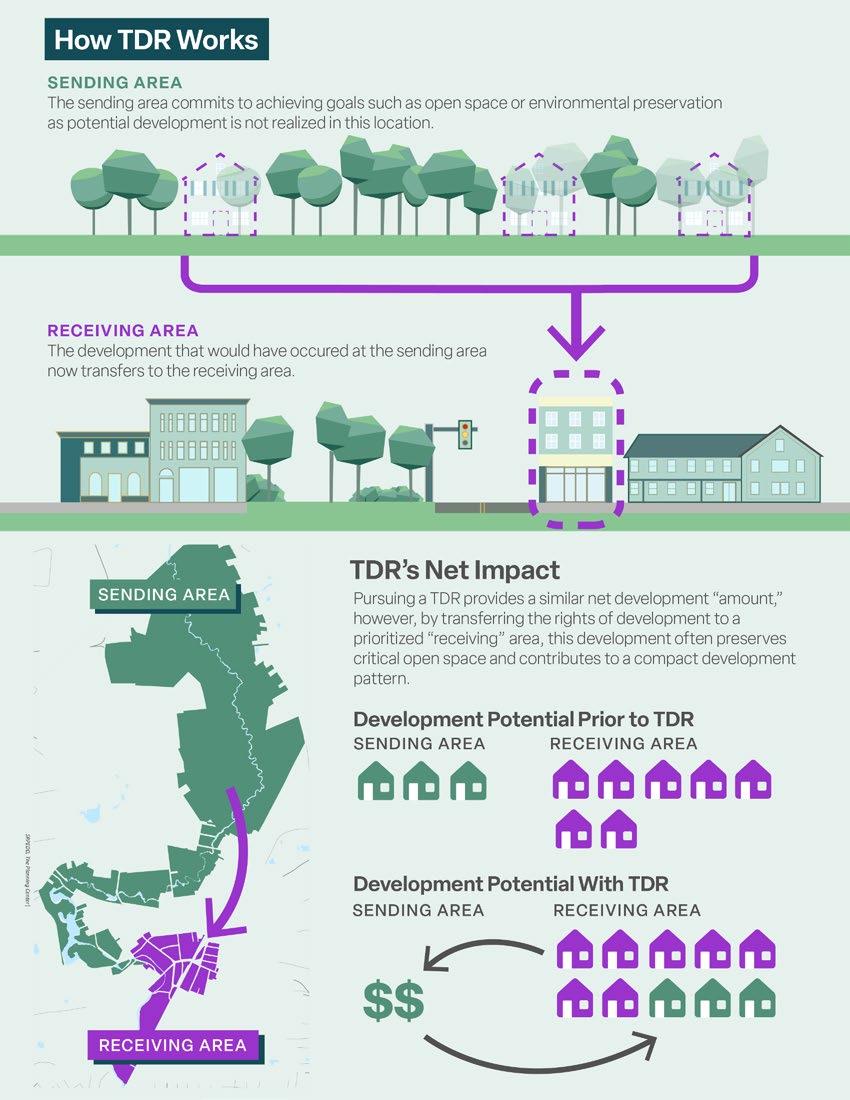
Strategy 1.2-2 Implement Design Guidelines or Standards at key locations in town, such as Route 103.
Performance Measures
Priority: High
Year 1-2: Align the development of design guidelines or standards with any zoning by-law changes / implementation of overlay zones and develop a set of visual recommendations to support the goals of each by-law change.
Complementary Goals and Strategies
1.1-1 Create path for the rectification of split-zoned lots and rezoning of lots with non-conforming uses.
Goal 3.1 Explore new development opportunities along Route 6.
3.2-1 Identify constraints that are limiting the development of small businesses and inventory locations in town where they may thrive while connecting these businesses to funding sources.
Goal 8.3 Develop key routes to support economic development and improve quality of life.
Responsible Party
Planning Board and Town Planner
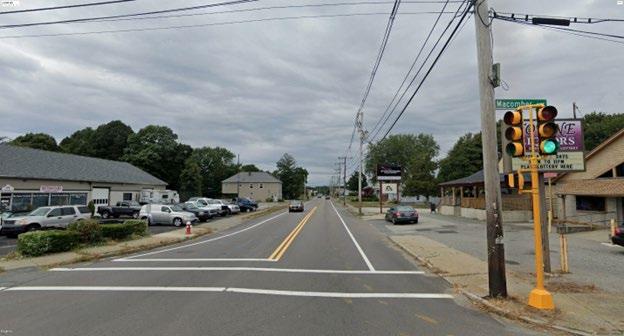
During the Comprehensive Planning process, workshop participants and survey respondents defined their vision for Route 103. Feedback for the road identified a desire for increased walkability; a mix of uses that include additional locally owned, small-format retail; places to live; and open spaces for residents and visitors to enjoy. While, from a zoning perspective, these goals may at times seem disparate, implementing design guidelines and standards can help unify these desires in a way that feels cohesive and consistent with the type of vision for Route 103 (and other roads) that participants outlined during public feedback exercises.
Design standards use images and text to describe numerous site and building characteristics, ranging from stormwater management to architecture and materials. Rather than impose strict dimensional requirements, design and performance standards balance flexibility with regulation to promote creative solutions and encourage
Route 103 (Wilbur Avenue; left) runs from the Warren, RI line, through Ocean Grove, and into Somerset. The corridor currently hosts a mix of small commercial entities and residential uses.
the best possible project outcome. These design standards should promote walkable, compact developments; for example, the building’s primary façade should front the street instead of sitting behind a parking lot. Design standards can also address the public realm, including design, style, and materials for light poles, planters, benches, and other public space infrastructure. These standards integrate concepts and branding that can help new developments feel consistent with town-wide economic development efforts and wayfinding.
Design standards typically arrive in a Town’s by-law via their inclusion in Planning Board Rules and Regulations governing Site Plan Review. The Planning Board can adopt and subsequently amend design standards at public hearings. The incorporation of design guidelines and standards will help amplify the village feeling of some of Swansea’s beloved areas and assist in their transformations to local destinations.
Photo 13. Streetview of Route 103. Google Maps.
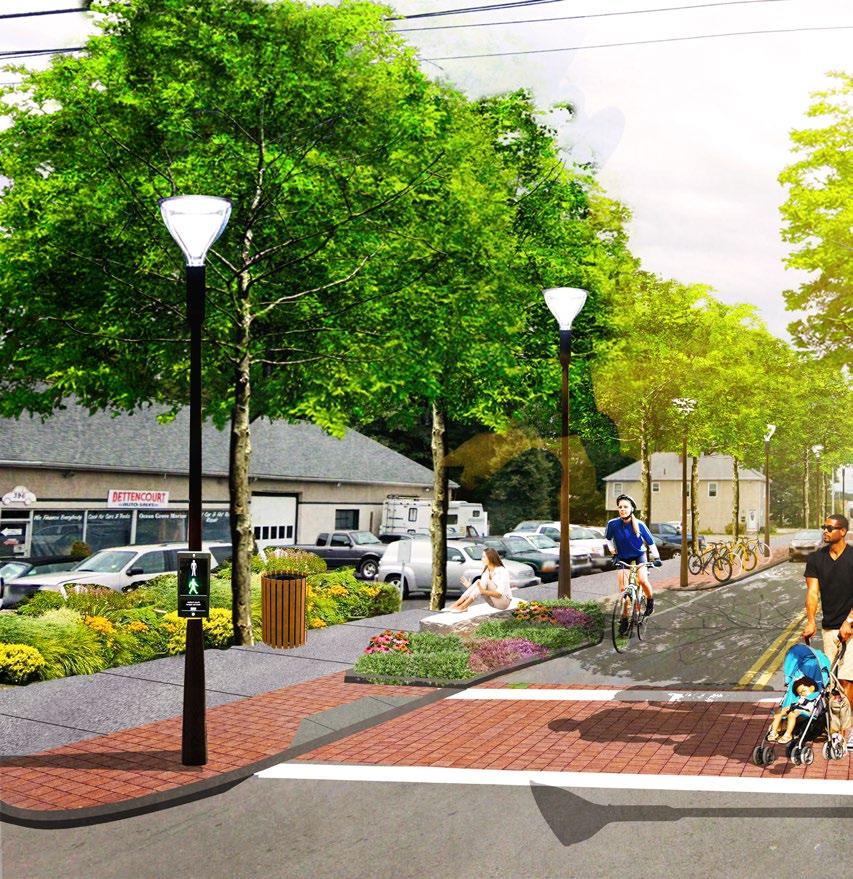
Street trees and plantings to increase shading, capture stormwater run-off, and promote a vibrant streetscape.
Marked and signalized crosswalks and sharrows to promote walkability and bikeability.
A Vision for Route 103

Lighting and banners to improve visibility for bikers and pedestrians and create a sense of place.
Outdoor dining to enliven the corridor and promote foot traffic for local businesses.
Strategy 1.2-3 Create a Demolition Delay By-law for historic properties.
Performance Measures
Priority: High
Year 1: The Town will determine if it is appropriate to pursue a demolition delay bylaw and present it to the Planning Board.
Year 2: The Town will draft and present the implications of a Demolition Delay Bylaw.
Year 2-3: The Town will carry out an educational campaign to share information about the Demolition Delay Bylaw to residents.
Year 3: The Town will present the Demolition Delay Bylaw at Fall Town Meeting by 2026.
Complementary Goals and Strategies
OSRP Objective 2C
Responsible Party
Historical Commission and Town Planner
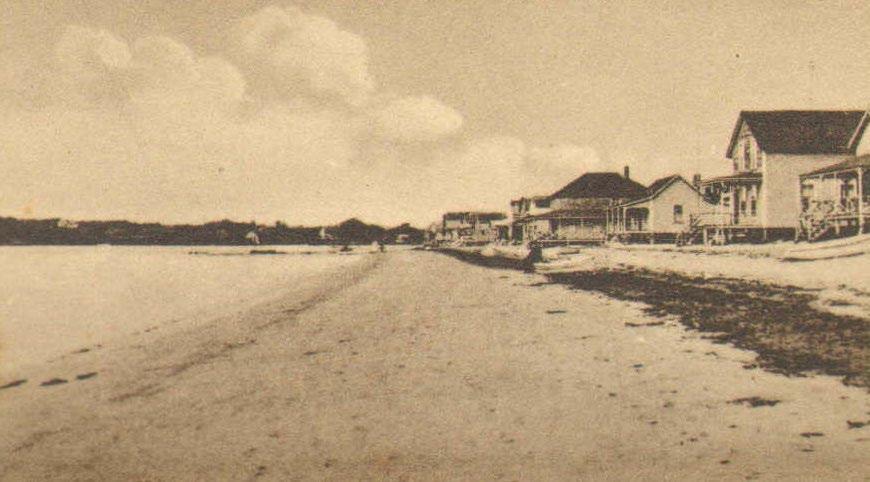
From Swansea’s natural features; to historic districts such as Barneyville, Hortonville, Swansea Village, and Luther’s Corner; to several unique and historical homes throughout town; several aspects of the Town’s history represent profound meaning for residents and visitors. Given that many historic properties are not designated as part of the historic inventory, they are vulnerable to demolition and significant structural change, especially following a purchase. A demolition delay by-law is a strategy that Historical Commissions commonly utilize across the Commonwealth. By providing a delay period to consider alternatives to the demolition of a building, this by-law can be an effective tool to protect historically significant resources in the community.
If the Town’s representative and property owner cannot find a reasonable alternative to demolition, it can then proceed.
To adopt a by-law for demolition delay, Swansea would need to draft the requisite language and propose it for a vote at Town Meeting. As part of the by-law drafting process, the Town will decide which historical period or date identifies homes that are subject to the demolition delay. Ultimately, although the demolition delay bylaw would not prevent demolition altogether, it does provide a period where the Town can foster conversation with owners of historic properties to reach a mutually agreeable compromise for development.
Photo 14. Historic Photo of Long Beach, Ocean Grove. Swansea Historical Society.
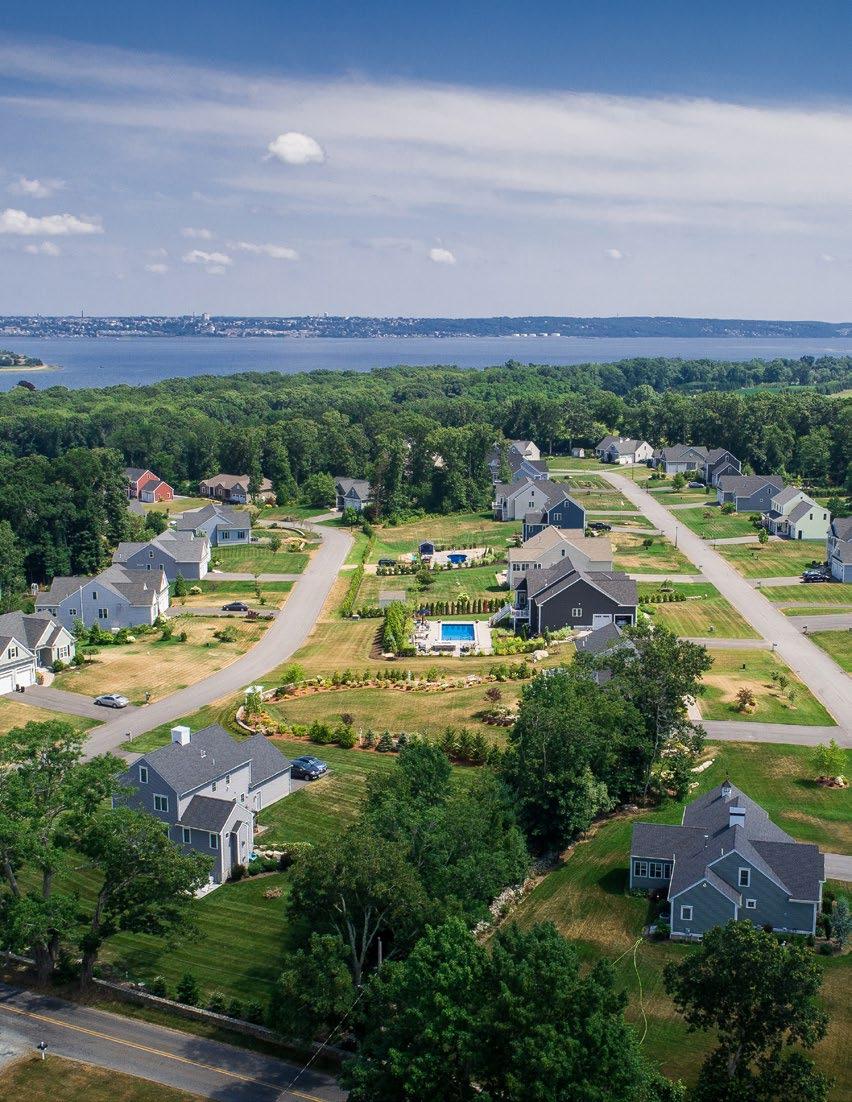
Element 2: Housing
Photo 15. Residential Subdivision in Swansea. Kevin Ham, SRPEDD.

In Summary: Housing
Swansea is home to several scenic rural neighborhoods with deep agrarian history, including Hortonville, Swansea Village, and Luther’s Corner. In addition to these rural residential areas, the town also hosts the densely settled seaside community of Ocean Grove – a neighborhood known for its small-lot single-family homes. Many residents cite these the neighborhoods as defining features of Swansea, and value the historical and natural features entwined in them.
A major priority for the Town of Swansea will be the production of new affordable housing options that are integrated into the existing historical and natural fabric of the community. The Town’s Subsidized Housing Inventory (SHI) is currently at 3.56% as of June 2023, meaning that the Town will need to produce an additional 439 units to meet the Commonwealth’s required 10%. Furthermore, only 1 in 4 survey respondents feel that the Town’s current housing stock is meeting the community’s needs. Fifty percent also reported that they do not think there are enough senior housing options, and 33% do not think there are enough veterans housing options.
This chapter will also serve as a portion of the Town’s five-year Housing Production Plan and shall meet all the requirements of MGL c.40B and 760 CMR 56.
Barriers to Housing Development
In every community, there exist challenging market conditions, laws, land characteristics, historic development patterns, and other factors that can contribute to limited development opportunities or a lack of affordable housing options. It is important to examine these challenges so that planning officials and municipal staff can craft a set of goals and strategies to address each community’s needs. In Swansea, some of the main barriers that may hinder the development of smaller, more affordable housing options include:
Public Utilities and Municipal Services
The absence of public sewer/water and municipal services can limit the types of development options available and add costs to development (e.g., wells and septic systems). Swansea currently has limited access to sewer services, a notable concern among residents and municipal staff. The Town is currently working to establish an Intermunicipal Agreement with the Town of Somerset to bring sewer service to the eastern portion of Route 6. Furthermore, the Town is serviced by a municipal desalination plant, which is in need of upgrades due to water quality concerns. The Town is currently exploring IMAs for water, as well, with neighboring Rhode Island municipalities and Somerset. Swansea also has limited emergency services, notably constrained by their volunteer fire department.
Zoning Regulations
Swansea has one residential zone that allows for single-family home development on 30,000sqft lots (60,000sqft in the Town’s Water Resource Protection District). Zoning regulations, intentionally or unintentionally, are one of the most common limiting factors when it comes to the production of affordable housing. Zoning that prohibits higher density uses, favors larger minimum lot sizes, lacks clarity, and maintains high parking requirements can prohibit the production of moderately priced, minimally impactful homes. This often leads to unsustainable and unaffordable development outcomes that exacerbate car dependence, environmental degradation, deforestation, and suburban sprawl.

Environmental Constraints
Swansea is home to a wide array of natural features. Being a coastal community, the Town is home to several estuaries at the mouths of the Palmer, Cole, and Lee Rivers. These estuaries contain important aquatic habitats and wetlands. Swansea also has many historic farmlands and active agricultural uses, particularly in the northeastern parts of town. In 2020, the amount of land under a permanent preservation restriction or belonging to a class of publicly owned land unlikely to be developed is approximately 1,061 acres, or approximately 6.5% of the town's land area. There are also roughly 965 acres (5.9%) of Chapter land in Swansea, though the acreage fluctuates with property additions and removals. Additionally, Swansea is situated on the unceded ancestral territories of multiple Indigenous Tribes and First People’s Nations, including the Wampanoag and Pokanoket, and Pocasset Tribes.
Negative Community Perceptions
Whether we are conscious of it or not, the phrase “affordable housing” summons up misguided images of potential neglect, loss of property value, and increased crime. Residents and elected/appointed officials often cite associated costs (e.g., more students in schools, increased need for emergency services) as another reason more housing shouldn’t come to the community. However, it is required by state and federal law that communities provide fair housing opportunities for residents, regardless of their social, economic, cultural, or family make-up. Young professionals, families, and older adults who are not in the position to afford high homeownership costs, but wish to remain in their community, as well as minority and low- to moderate income households, have the right to fair housing opportunities throughout Massachusetts.
Photo 16. Residential Subdivision in Swansea. Kevin Ham, SRPEDD.
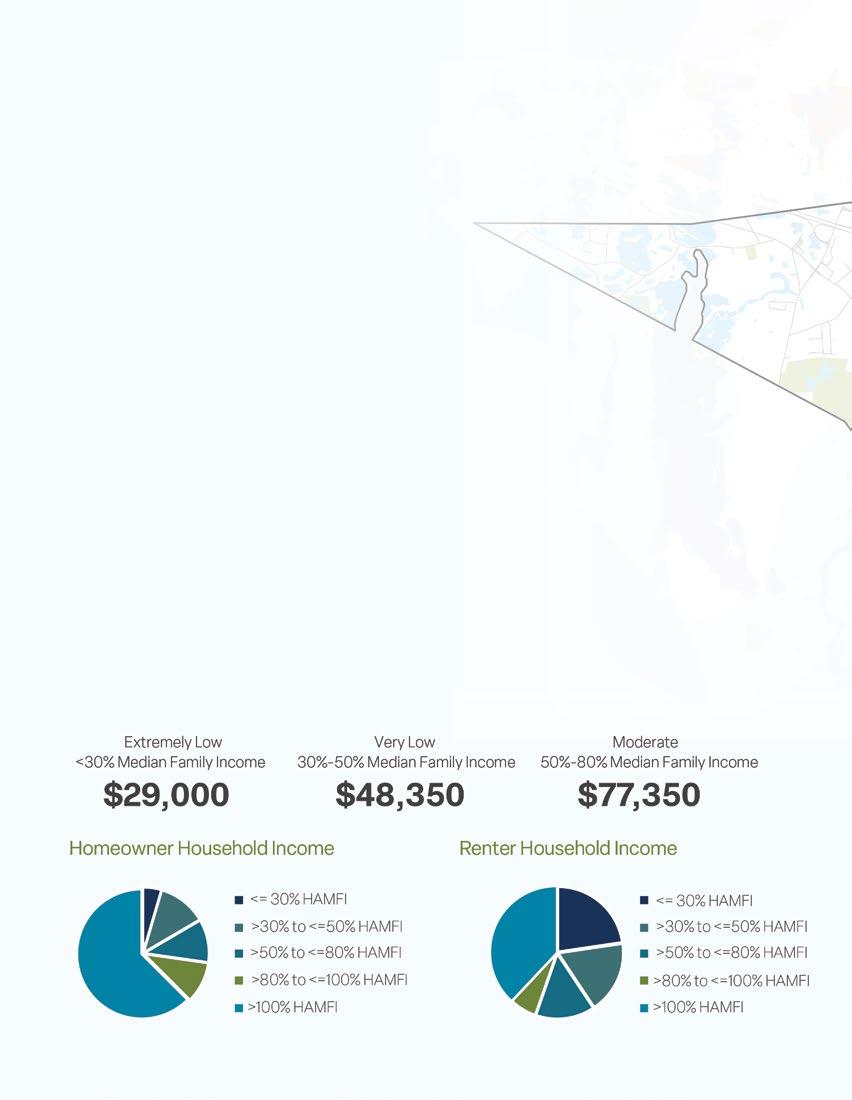
Goal 2.1 Continue to produce SHI-eligible units to achieve the Commonwealth's required amount and to support communities in need.
This first housing goal is straightforward in its intent – to produce subsidized affordable housing options to create new housing options for those making at or below 80% of the Town’s AMI ($77,350 for a family of four).
Currently, 37% of Swansea households are eligible for some form of subsidized affordable housing. The production of new housing units throughout town (primarily along the Route 6 and Route 118 corridors) through partnerships with developers will be the primary mechanism to achieve this goal.
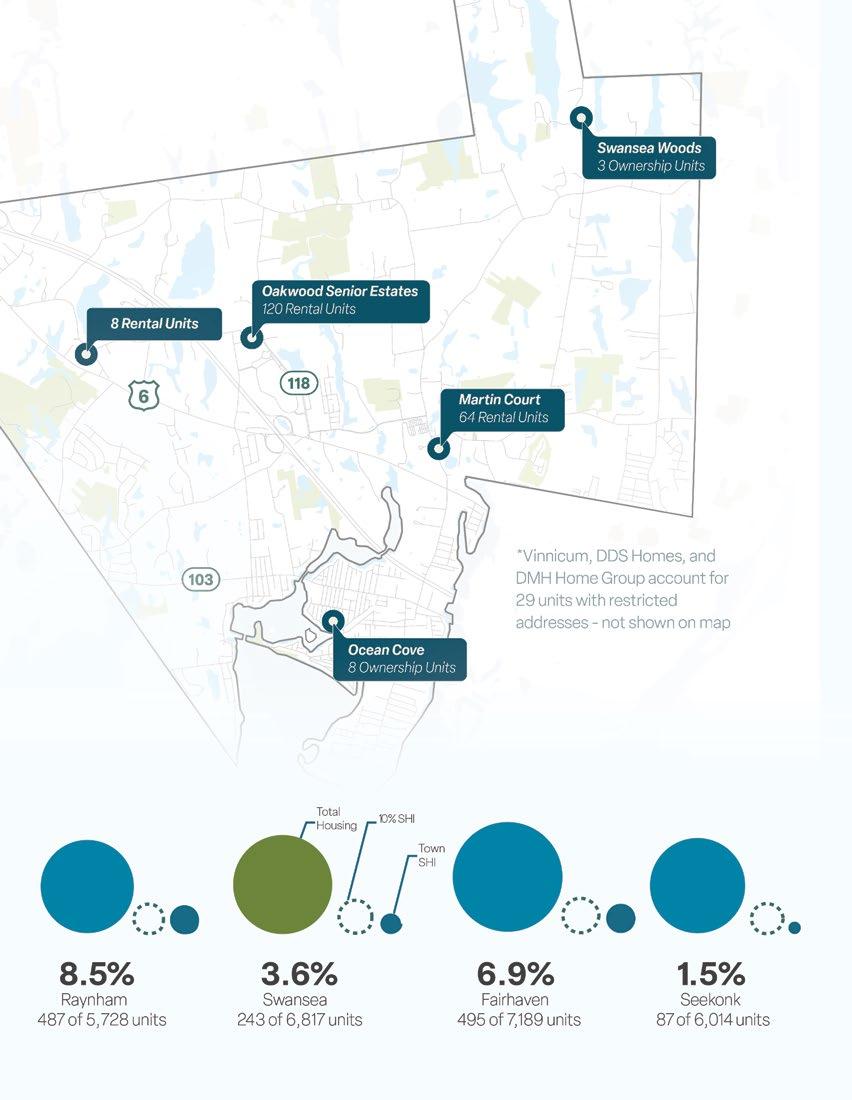
Strategy 2.1-1
Collaborate on “friendly 40Bs” in partnership with developers to produce affordable housing units.
Performance Measures
Priority: High
Year 1: The Town will have determined an eligible parcel to undergo the RFP process through LIP.
Year 2: The Town will have released an RFP for the eligible parcel.
Year 2-3: The Town will have selected a developer to partner with through the RFP process.
Year 4: The Town and partnered developer will have applied for a Comprehensive Permit through LIP.
Complementary Goals and Strategies
2.1-2 Pursue partnerships leading to development that is affordable to those with low, moderate, and fixed incomes.
2.2-2 Pursue partnerships and funding resources to provide direct assistance to help preserve housing for vulnerable communities, including senior residents.
Responsible Party
Planning Board, Select Board, Zoning Board of Appeals, and Town Planner
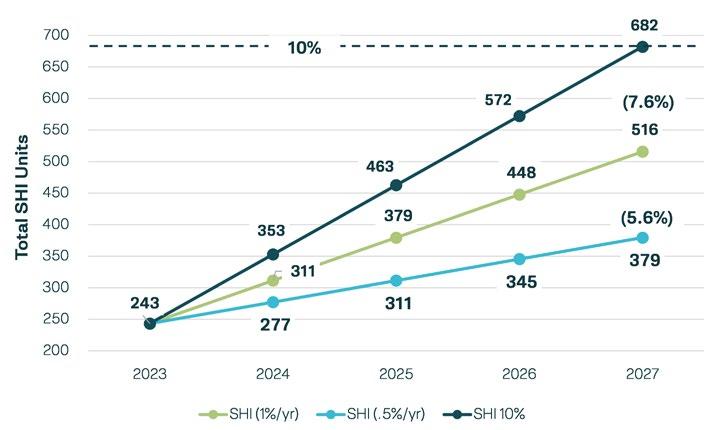
Swansea could pursue producing SHIeligible housing by working to partner with a “friendly 40B” developer through the State’s Local Initiative Program (LIP). LIP allows communities and developers to work together on SHI-eligible housing developments, usually initiated through a Request for Proposals on behalf of the municipality. Upon response, the project (known as a Local Initiative Project) would then go through the Comprehensive Permit process under Chapter 40B, where the municipality and developer apply jointly. Applying through LIP gives the municipality more oversight over the decision-making
process, including aspects of financing, design, and construction.
To complement this process, Swansea can inventory parcels they own, as well as taxtitle properties, to determine if they are suitable for affordable housing development. These parcels are more readily available for affordable housing development than their privately-owned counterparts. Communities can declare these properties “excess property” (typically at Town meeting); then, through an RFP process, can partner with affordable housing developers or agencies to produce housing.
Figure 8. SHI projections showing yearly production at 0.5% and 1.0% per year, as well as production necessary to achieve 10%.
After a preliminary review, the Town has identified five sites for potential development, described in Map 5. Per 760 CMR 56.03 (4)(d), Swansea will consider encouraging the use of 40B as a permitting tool for one or more of these properties. Additionally, the town will also consider issuing RFPs, now or in the future, for the development of the townowned parcels into SHI-eligible housing. The town-owned sites include:
• Joseph Case Junior High School (LOC ID M_225455_833396);
• Swansea Council on Aging (LOC ID M_224132_830710, M_224154_830718); and
• Taft Avenue Land (LOC ID M_223969_834062, M_223991_833897).
The privately-owned sites include:
• The former Rodeway Inn (LOC ID M_223254_833370); and
• The former St. Louis de France School (LOC ID M_228545_833227).
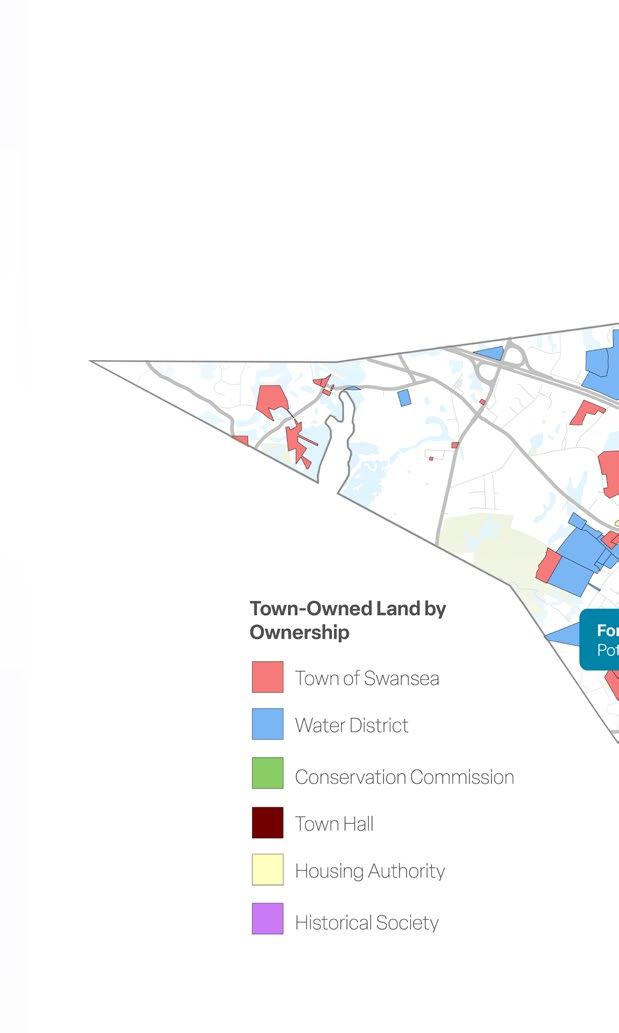
Map 5. Swansea Housing Action Map.

Strategy
2.1-2 Pursue partnerships leading to development that is affordable to those with low, moderate, and fixed incomes.
Performance Measures
Priority: High
Year 1: The Town will have inventoried all town-owned parcels and evaluated their eligibility for housing development.
Year 2: The Town will work with a local non-profit partner or developer to produce small-scale affordable housing on a town-owned site.
Complementary Goals and Strategies
2.1-1 Collaborate on “friendly 40Bs” in partnership with developers to produce affordable housing units.
2.2-2 Pursue partnerships and funding resources to provide direct assistance to help preserve housing for vulnerable communities, including senior residents.
Responsible Party
Planning Board, Select Board, and Town Planner
In addition to 40B development under LIP, Swansea could pursue partnerships with local non-profits or other developers to produce housing options for folks with low, moderate, and fixed incomes. This can include working with Habitat for Humanity, the Town’s Housing Authority, or NeighborWorks to produce smaller-scale housing opportunities than a conventional 40B. Known as Local Action Units (LAUs; a specific type of housing project under the Local Initiative Program), these units would be deed-restricted and eligible to be included on the SHI, although they do not go through the Comprehensive Permit process.
Project Spotlight: The Residences at Lawrence Hill
The Town of Wellfleet put out an RFP for a municipally-owned property at 95 Lawrence Road and received three bids, one of which was recently selected and unanimously approved by the Select Board to proceed. The project, which would produce 46 apartments ("The Residences at Lawrence Hill"),and received a Comprehensive Permit in September 2022. These apartments will be designed considering net zero energy goals, and will feature rooftop solar, all electric building systems, and low flow plumbing fixtures.
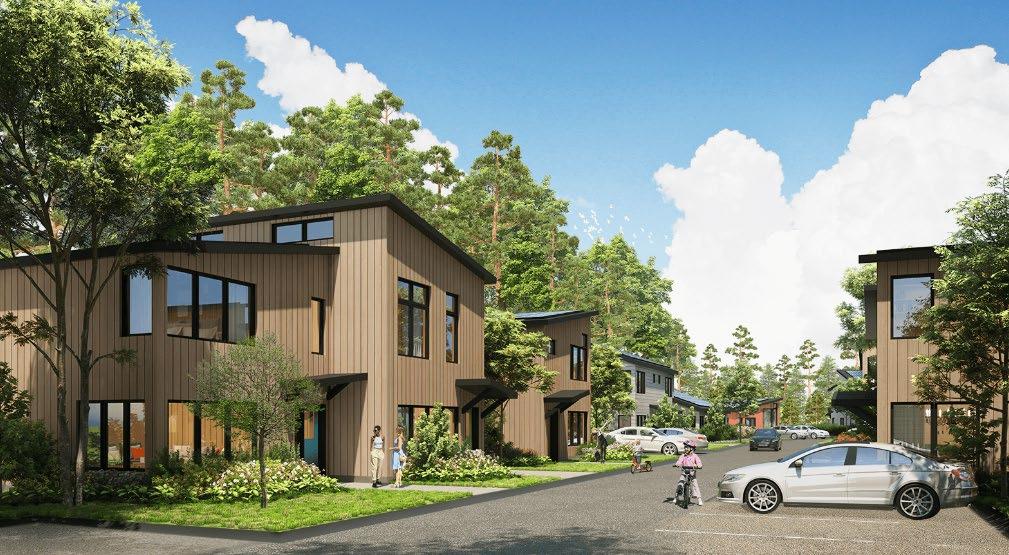
Photo 17. Architectural rendering of 95 Lawrence Road. Studio G Architects.

Goal 2.2
Produce housing options for older adults to support aging in place and for adults with disabilities and/or chronic illnesses.
As is the trend regionally, statewide, and nationally, Swansea’s population is aging. An individual's housing needs are likely to change as they get older, due to changes in their income, mobility, household structure, etc. Given its aging community, the Town should find ways to assist residents who wish to “age in place” by finding avenues to provide new senior housing options or offering mechanisms and resources to support retrofitting existing homes so that they are “aging-ready.”

Swansea Comprehensive Plan
OR. Communitecture.
Photo 18. Cottage Cluster Housing in Portland,
Strategy 2.2-1 Amend Town Accessory Apartment By-law to encourage its intended uses.
Performance Measures
Priority: High
Year 1: Work to review the Accessory Apartment By-law.
Year 2: Present draft amendments to the By-law to the relevant boards and the public.
Year 3: Incorporate stakeholder feedback and present the By-law for adoption at Town Meeting.
Complementary Goals and Strategies
1.1-4 Implement key zoning amendments to create new housing opportunities for first time homebuyers, older adults wishing to downsize, and those with moderate or fixed incomes.
2.2-2 Pursue partnerships and funding resources to provide direct assistance to help preserve housing for vulnerable communities, including senior residents.
Responsible Party
Planning Board, Select Board, and Town Planner
Additional Reading
Town of Northampton Zoning By-laws
HUD Accessory Dwelling Units Case Study
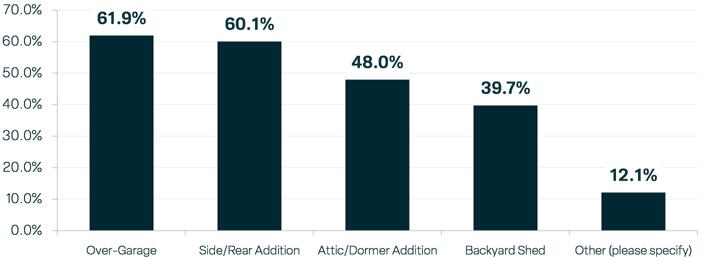
A common problem in the region is limited housing stock for individuals looking to age in-place at their current residence, looking to purchase their first home, or looking to rent affordably. Without access to alternate housing opportunities, such as 55+ communities or local downsizing options, whether because of expenses or not living in an aging-friendly home, older residents are forced to make a difficult choice, which may involve moving from their home in Swansea to somewhere outside of Town. Accessory apartments are an effective way of allowing a homeowner to maintain their property, while also providing residence for friends, relatives or tenants, and to also generate income through rent to pay for increasing expenses, like property taxes. To more effectively use this tool, Swansea would need to amend the Town’s Accessory Apartment Bylaw to encourage its intended uses.
The Accessory Apartment Bylaw is rather restrictive when compared to other nearby communities. When amending the Bylaw there are several different paths the Town can take to further encourage this use. First the Town should look into amending the use for accessory apartments so that they are by-right in the Rural/Residential (RR) and the Business A (BA) Districts, while also making them allowable through site plan approval in the Business B District. Currently, the zoningbylaw requires a special permit through the ZBA in the RR and the BA. The Town could also look into allowing detached-accessory apartments as a separate use, while only making it allowable through administrative approval. The Town should also examine its restrictions on the number of bedrooms allowed within the accessory apartment.
Figure 9. Survey responses - "Which of these accessory apartment types would fit in Swansea?"
Another potential avenue for amending the Bylaw, would be to switch to formbased criteria for accessory apartment requirements. What this essentially does is give the owner of the property more flexibility when it comes to ADU construction. In turn, this option would allow for more accessory apartment construction, while ensuring the new structure would adhere to the character of the home, and by extension the neighborhood. The Town of Northampton adopted a version of design-based criteria in order to encourage accessory apartment uses.
During the public feedback process, about 60% of survey respondents expressed that over-garage and rear/side addition accessory apartments fit in Swansea. There is interest in Town by residents in these types of accessory apartments and the Town should determine what makes the most sense in their zoning to help encourage these uses.
Types of Accessory
ADUs come in many forms, and Swansea can tailor its ADU by-law to fit the resident preferences. The examples on the right show some of the most common types of ADUs that can be constructed.
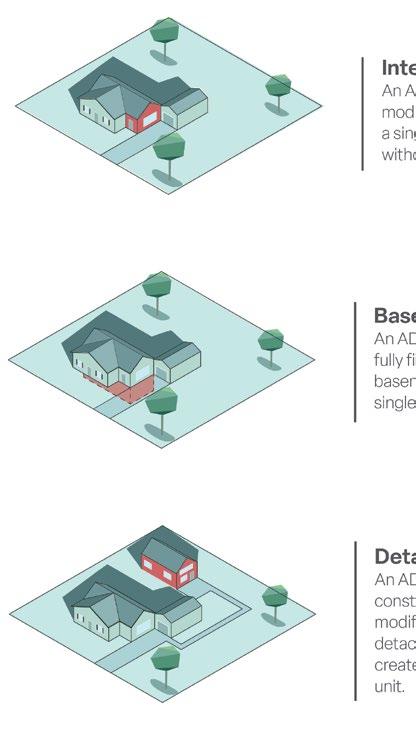
Accessory Dwelling Units (ADUs)
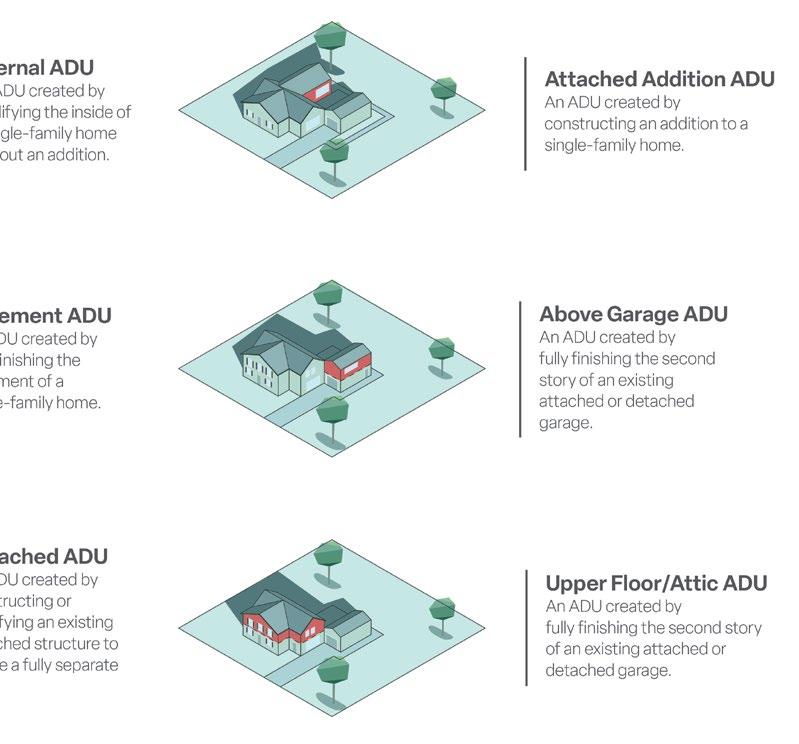
Strategy 2.2-2
Pursue partnerships and funding resources to provide direct assistance to help preserve housing for vulnerable communities, including senior residents.
Performance Measures
Priority: High
Year 1: Inventory current funding streams and evaluate gaps.
Year 2: Apply for relevant funding opportunities, including the Commonwealth's CDBG grant round.
Complementary Goals and Strategies
2.2-4 Begin a Housing Rehabilitation and Repair Program.
Responsible Party
Town Planner, Town Administrator, and Redevelopment Authority
Additional Reading
Community Preservation Coalition’s CPA Project Database
Housing Toolbox for Massachusetts Communities Affordable Housing Trust and CPA Conference 2022 Resources
Preserving housing for vulnerable communities is essential for Swansea to support its most underserved groups. Direct assistance and preservation tactics serve a dual function, to allow folks to remain at their homes and/or provide them with better available housing options. Swansea, and to a much greater extent the region, are seeing concerning trends that indicate the potential for underserved groups, like senior residents, to be displaced for a variety of reasons, including becoming priced out due to increasing taxes, the need to modify homes to age in-place, the expenses associated with replacing septic systems, etcetera. Swansea luckily has many different avenues and funding sources at its disposal to support these vulnerable communities, including establishing a housing consortium with other nearby towns.
Housing consortiums enable communities like Swansea to partner with nearby municipalities to combat complex housing problems. These partnerships enables groups to pool resources and create active programs to assist with a variety of housing problems. A great example of this is the Greater Attleboro/Taunton Home Consortium (GATHC), where 14 member communities have access to funds for housing rehabilitation and a first time
homebuyer assistance program. Swansea can work with nearby communities to apply for funding sources, such as the Community Development Block Grant (CDBG), to greatly increase their chances of a successful application and have a more impactful program. The Town can also apply on their own for this funding if they deem it to be the best route forward. To increase the odds of receiving these funds even more, Swansea could use CPA funds to match the federal funds from this program. Town staff should review the Community Preservation Coalition’s CPA project database for similar projects to get a sense of what could achieved with this avenue.
An example Swansea can reference is the City of New Bedford's several home rehabilitation and accessibility assistance programs that aim to improve low- and moderate-income residents’ housing. These programs offer direct funding and/or low-to-no-interest loans to make necessary accessibility, safety, or home rehabilitation repairs in owneroccupied or investor-owned homes. The programs are funded through HUD’s HOME Investment Partnership Program and CDBG.
Strategy
2.2-3 Create new zoning by-laws that support aging in place, such as an Adult Retirement Community By-law.
Performance Measures
Priority : High
Year 1: The Town will have evaluated comparable ARC bylaws.
Year 2: The Town will have written a draft ARC bylaw.
Year 3: The Town will have brought the new ARC bylaw to Town Meeting for resident vote.
Complementary Goals and Strategies
1.1-4 Implement key zoning amendments to create new housing opportunities for first time homebuyers, older adults wishing to downsize, and those with moderate or fixed incomes.
Responsible Party
Planning Board, Select Board, and Town Planner
Additional Reading
Marshfield's Age Restricted Adult Village By-law
Figure 10. Survey responses to the LU-H-ED Survey Question: " Which of the following agerelated housing options would you support? (please select all that apply) "
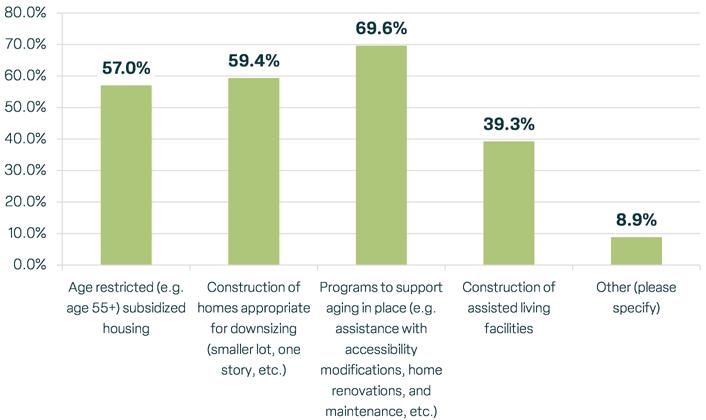
Age-Restricted/Adult Retirement bylaws allow for development, restricted to people aged 55 and above and disabled persons, at a higher density than is typically allowed in a municipality’s various zoning districts. These communities often provide a mix of housing types, ranging from single family homes to condominiums, townhouses, or other types of multi-family structures – all designed for independent living. However, age-restricted communities often assist with day-to-day living by providing help with activities and adequate connections to other town services. These by-laws may include an affordability component to ensure that a
portion of the units produced from the zoning change are accessible to seniors with lower or moderate incomes.
During the public feedback process, 56% of survey respondents expressed an interest in seeing an age-restricted or adult retirement by-law in Swansea as part of a broader approach to provide opportunities for residents to age in place and to provide housing assistance to those in need. The Town can explore locations that would be appropriate for integrating an adult retirement community and conducting further public feedback.
Strategy 2.2-4 Begin a Housing Rehabilitation and Repair Program.
Performance Measures
Priority: High
Year 1: Explore funding and programmatic opportunities through CDBG, CPA, and the GATHC.
Year 2: Work with regional partners to tap into existing funds or pursue new funds for a Home Rehab and Repair Program.
Year 3-4 (if creating a new program): Establish criteria for applications using local precedents as references.
Year 5 and on: Open the program for applications.
Complementary
Goals and Strategies
2.2-2 Pursue partnerships and funding resources to provide direct assistance to help preserve housing for vulnerable communities, including senior residents.
2.3-2 Create a Municipal Affordable Housing Trust.
Responsible Party
Planning Board, Town Planner, and Town Administrator
A major step toward increasing the availability of livable housing stock in Swansea is for the Town to look into developing programs aimed at rehabbing homes in need of repair or modification, especially for individuals who desire to age in place. There are several different funding sources the Town can look into to create this type of program, including Mass Community Development Block Grants (CDBG) or Community Preservation Act (CPA) funds.
CDBG is a great way to receive necessary funding for projects that help low- to moderate-income populations that need financial assistance for essential modifications to their place of living. The target population of these projects falls under the grant’s required 1 of 3 national objectives, which is to “benefit a majority of low- and moderate-income persons.”
The Town should pursue opportunities that would help their most in-need residents, and they could do this by also applying in tandem with other municipalities to
accomplish projects with similar goals. If the Town was able to provide matching funds (through CPA or otherwise) to show its financial commitment to the project, as well as to submit a joint application with other municipalities, this would greatly increase the probability of the application’s success. CPA funding could be utilized for these types of programs, but these funds could only be used if the property was acquired using CPA funds, so it might be necessary to rely on other forms of funding to match CDBG funds. CDBG funds are competitive, and the Town should continue to apply annually to increase the likelihood of access to these resources.
Through CDBG funding, the Towns of Truro, Eastham, and Provincetown were awarded funds to establish a tri-town program managed by a non-profit for housing rehabilitation. The program is income restricted for those looking to apply.

Goal 2.3 Pursue funding and professional support to implement new housing strategies.
Producing contextual, affordable, and environmentally-sound housing options requires a lot of work on behalf of a Town. Given that Swansea’s dedicated municipal staff must already divide their attention across many competing projects and initiatives, the Town would benefit from having professional support to assist in implementing the findings of both this Housing Chapter and Comprehensive Plan. There are many ways the Town could do this, some of which are described below. Additionally, producing housing is costly; consequently, Swansea should work to obtain funding to do the work – both for technical assistance and construction.
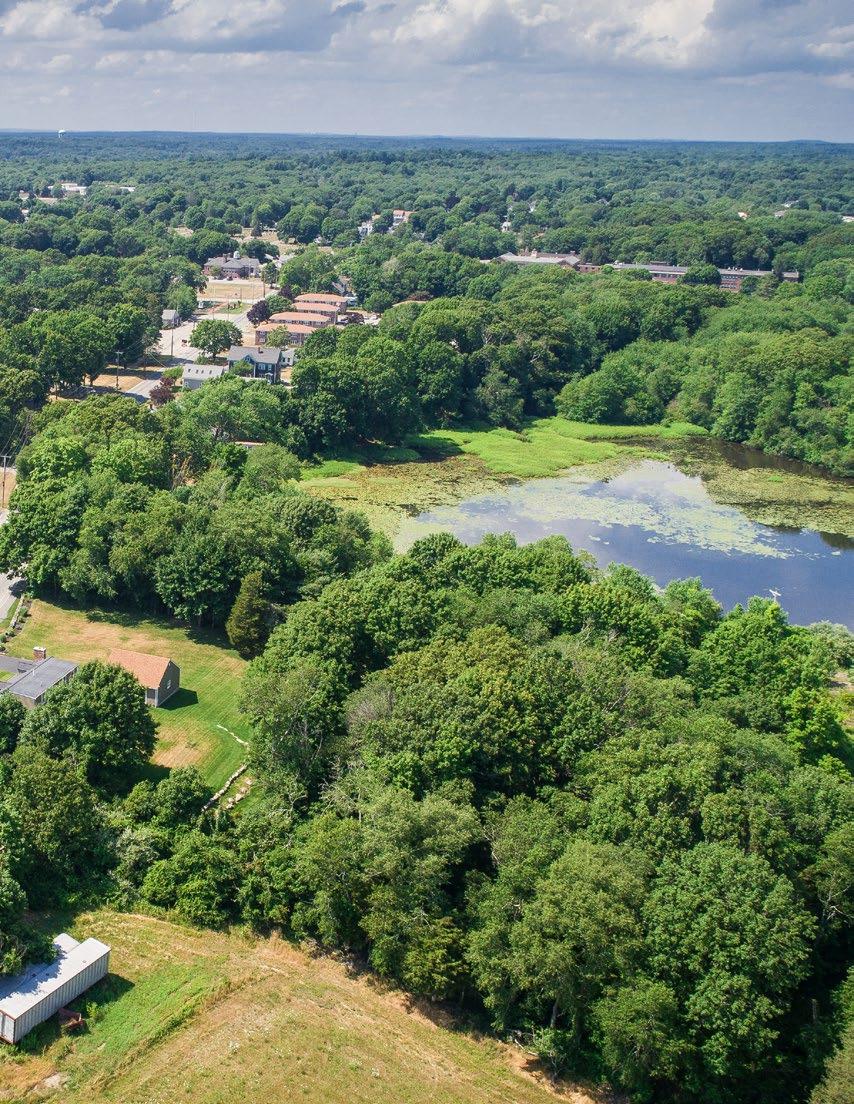
Photo 19. Neighborhoods in Swansea. Kevin Ham, SRPEDD.
Strategy 2.3-1 Consider hiring a consultant to assist in implementing the strategies within the Housing Production Plan.
Performance Measures
Priority: High
Year 1: Solicit opportunities to hire a consultant.
Year 2: Hire a consultant to assist the Town with implementing the findings of the Comprehensive Plan and Housing Production Plan.
Year 3 and on: Evaluate ongoing progress with implementing the Plans and hire consultants as needed.
Complementary Goals and Strategies
Goal 2.1 Continue to produce SHI-eligible units to achieve the Commonwealth's required amount and to support communities in need.
Goal 2.2 Produce housing options for older adults to support aging in place and for adults with disabilities and/or chronic illnesses.
Responsible Party
Planning Board, Select Board, Town Planner, and Town Administrator
Swansea would benefit from acquiring additional assistance in implementing their housing goals and strategies given current staff’s existing time commitments and responsibilities. This can include contracting with a housing consultant using local funds or applying through regional- and staterun technical assistance programs. Some potential opportunities the Town could explore include:
• CPA Allocations: Swansea could allocate funding through its CPA tax levy to hire a housing consult and/or accomplish strategies laid out in this Plan.
• Community Compact Cabinet (CCC): Swansea could apply for CCC funding through the Best Practices Program. To apply through this program, the Town must elect at least one “Best Practice” that they agree to implement. If awarded, Swansea could utilize the funding to hire a consultant. To implement housing-specific work, the Town should elect up to two “Housing and Livable Communities” Best Practices. Applications for CCC’s Best Practices Program typically open after the finalization of the state budget and are accepted on a rolling basis. In order to be eligible, Swansea must not have received a CCC award in the previous fiscal year.
• District Local Technical Assistance (DLTA): Swansea could apply for DLTA funds through SRPEDD’s annual application process. These applications typically open within the first three months of every calendar year.
• Massachusetts Housing Partnership (MHP): MHP offers numerous technical assistance programs that range from navigating the 40B process to establishing an Affordable Housing Trust. Swansea can reach out to MHP to determine how the agency may be able to assist the Town in implementing the findings of this Plan.
Using funding from one or multiple of the above sources, the Town could take action to obtain external assistance to aid in implementation of this Plan.
Through CPA funding, the Town of Wellfleet allocated $4,626,611 to community housing efforts from 20062021, totaling 47% of their CPA spending over that timeframe. In 2016, the town used $50,000 of their housingdesignated CPA funding to hire a parttime consultant to assist with various housing projects and the development of a new Housing Production Plan.
Strategy 2.3-2 Create a Municipal Affordable Housing Trust.
Performance Measures
Priority : High
Year 1: Attend statewide training conducted by agencies such as MHP on establishing a Municipal Affordable Housing Trust.
Year 2: Review the opportunity to establish a Trust with relevant boards and the public.
Year 3: Incorporate stakeholder feedback and present the proposal for adoption at Town Meeting.
Complementary Goals and Strategies
2.2-4 Begin a Housing Rehabilitation and Repair Program.
Responsible Party
Planning Board, Town Planner, and Town Administrator
A Municipal Affordable Housing Trust is a trust that allows municipalities to collect funds for affordable housing that are separate from the general municipal budget and may be used for local initiatives aimed at creating and preserving affordable housing. These trusts can:
• Provide financial support for the construction of affordable housing by private developers (non- or for-profit);
• Rehabilitate existing homes to convert to affordable housing;
• Increase affordability in new housing development projects;
• Develop surplus municipal-owned land or buildings;
• Preserve expiring affordable units;
• Create programs to assist low- and moderate-income homebuyers;
• Create programs to help low- and moderate-income families make health and safety repairs; and
• Educate and advocate for further affordable housing initiatives.
These housing trusts can use funding under M.G.L. Chapter 44 s.55c from:
• The Community Preservation Act (CPA);
• Inclusionary zoning payments;
• Negotiated developer fees;
• Tax title sales;
• Payments from special bylaws/ordinances;
• Cell tower lease payments;
• Resale of affordable units as market rate, lottery/resale agent revenue; and
• Private donations.
CPA allocations are the most common source of trust funds. Many CPA communities appropriate more than the 10% minimum annual expenditure for community housing required by the CPA statute. The CPA law states specifically in Section 5(f) that “A city or town may appropriate money in any year from the Community Preservation Fund to an affordable housing trust fund.” Such trusts can have the power to purchase, sell, lease, manage, and improve real property for the purpose of creating and preserving affordable housing.
Strategy 2.3-3 Explore the feasibility of becoming a Housing Choice Designated community.
Performance Measures
Priority: High
Year 1: The Town will have evaluated their housing production determine if they are eligible for Housing Choice Designation.
Year 2: If eligible, the Town will have applied for Housing Choice Designation, either with or without Housing Best Practices.
Complementary Goals and Strategies
Goal 2.1 Continue to produce SHI-eligible units to achieve the Commonwealth's required amount and to support communities in need.
Goal 2.2 Produce housing options for older adults to support aging in place and for adults with disabilities and/or chronic illnesses.
Responsible Party Planning Board, Select Board, and Town Planner
Additional Reading
Marshfield's Age Restricted Adult Village By-law
The Commonwealth’s Housing Choice Initiative was created to provide municipalities with tools and funding to plan for and produce diverse housing options. Under this initiative, a community can receive a Housing Choice Designation, which provides exclusive access to the Housing Choice Community Grants Program and priority under Housing Choice programs like MassWorks and Complete Streets, among others.
Housing Choice Communities must meet three core requirements. First, a municipality cannot have any active housing restrictions, including moratoriums or limitations on the number of new units eligible to be constructed. Second, a municipality must
have produced or agree to produce an Americans with Disabilities Act (ADA) SelfEvaluation and Transition Plan in partnership with the Massachusetts Office of Disability. Third, the municipality must meet a five-year, year-round housing unit production goal, either:
• An increase of 5% (or 500+ units); or
• An increase of 3% (or 300+ units) and proof the community has met 7 unique Housing Best Practices.
For a 3% production goal, the municipality must show proof that they have met 7 of the 15 different Housing Best Practices, two of which must be in the Affordable category.
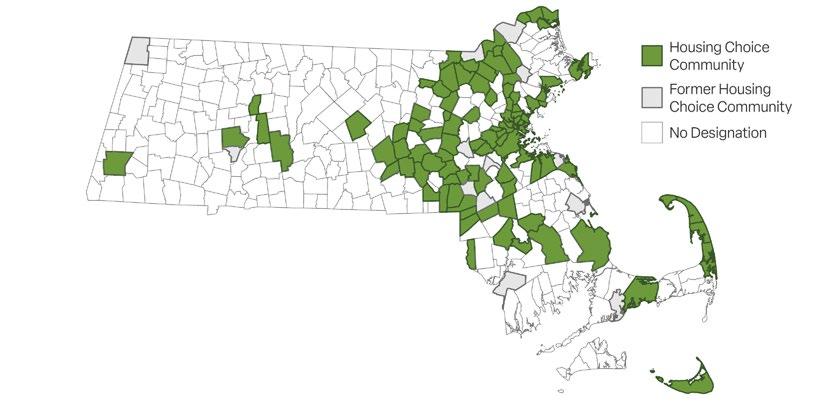
Map 6. Housing Choice Communities in MA.
Becoming Housing Choice Designated
As described above, Swansea will have to meet 7 of the following 15 Housing Best Practices, with two being apply for designation. Applications for designation typically open at the beginning of the calendar year. The
Best Practice Category
Zoning
Other
Best Practices
Multi-Family allowed as of right
Inclusionary zoning, with a density bonus
A 40R or 40Y Starter Home District [Affordable]
Mixed-Use or Cluster Development
Accessory Dwelling Units
Reduced multi-family parking requirements
Local actions that support housing [Affordable]
Land Use Board Training
40B pattern or approval [Affordable]
Subsidized Housing Inventory at or above 10%
Subsidized Housing Inventory increased at least
Participated in the Housing Development Incentive approved District Improvement Financing (DIF) element.
Property tax relief/Community Impact Fee [Affordable]
Certified Housing Production Plan
Housing Plan Implementation
Table 3. Housing Choice Designation Best Practices.
Designated
being categorized as Affordable. Once the Town has determined which categories it meets, staff can The 2023 Application Sample can be viewed here
[Affordable]
least 2.5% [Affordable]
Incentive Program (HDIP), adopted an Urban Center Housing Tax Increment Financing district, (DIF) related to housing, or have adopted an Urban Renewal Plan that includes a significant Housing [Affordable]
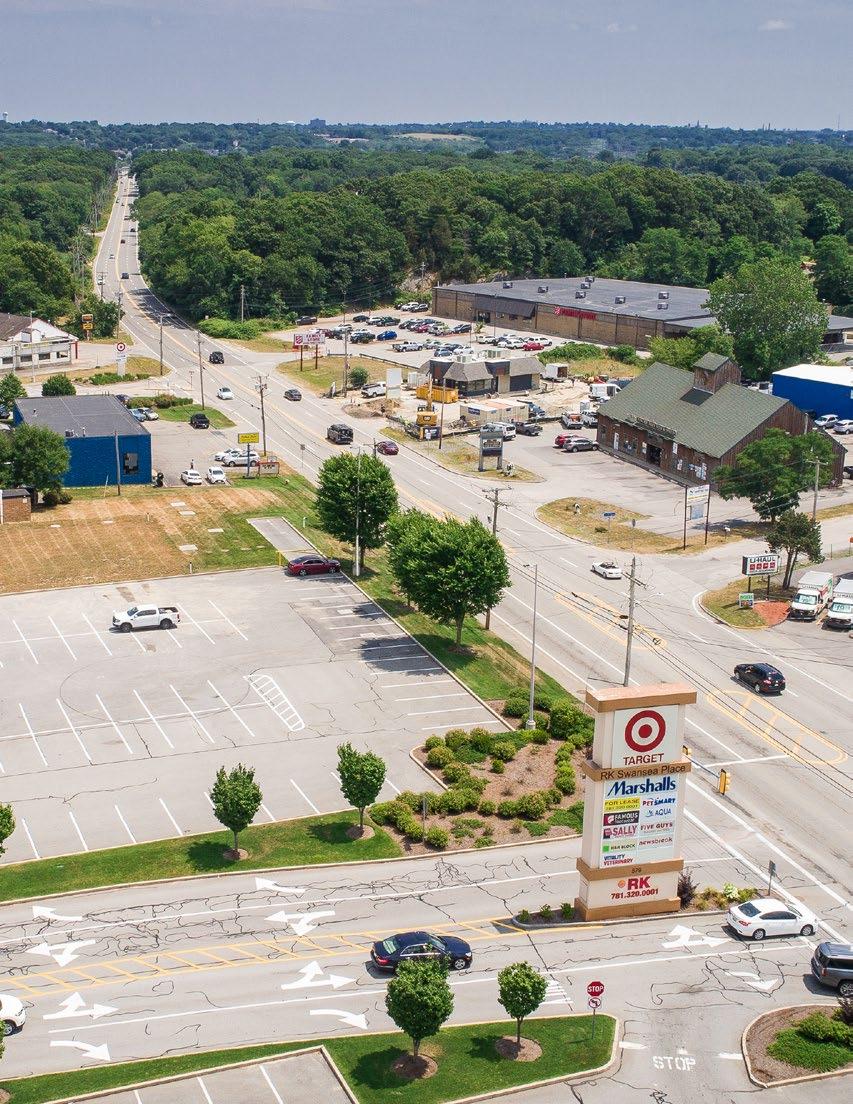
Element 3: Economic Development
Photo 20. Route 6 Corridor. Kevin Ham, SRPEDD.

In Summary: Economic Development
Over the next ten years, by pursing a diverse and coordinated set of actions, Swansea seeks to retain existing residents and draw visitors from nearby towns with revitalization of critical economic development sites, such as the former Swansea Mall on Route 118, while also incorporating meaningful placemaking interventions along the corridors of Routes 6 and 103.
In making Route 103 a destination for shopping and dining, Swansea will maintain existing businesses and attract new ones looking to relocate or startup. Along Route 6, the Town can introduce sewer, which will serve as a catalyst for more compact development; with a greater mix of uses than the current large-format, lowdensity commercial and industrial properties currently lining the corridor.
New business development will help Swansea expand its tax base and enable the town to continue providing services to residents. Future economic development activity in Swansea hinges on the ability to provide the proper water and sewer infrastructure at sites suited and identified for economic growth, while improving quality of life features at targeted areas in Town.
Goal 3.1 Explore new development opportunities along Route 6.
Route 6 is the commercial spine of Swansea. Running east/west through the heart of town, it is home to several of Swansea’s most significant commercial and industrial businesses. Prior to the extension of Interstate 195 in the 1970s, Route 6 was the primary road that provided access for a high volume of traffic to Cape Cod. Although it still allows for that use, it now serves many other purposes – in the case of Swansea, primarily as a commercial hub for shopping and economic development.
When surveyed, 37% of respondents identified Route 6 as the town center (second only to Main Street with 52% of responses). However, many of these same respondents would like to see a change in the character of Route 6 to accommodate a broader composition of uses along with fewer big box stores. Swansea, like many communities along this thoroughfare, struggle with how the road can marry its original purpose, as a throughway to the Cape, with its relationship to the core of the towns through which it runs. This goal explores the ways in which the Route 6 corridor can navigate this challenge and develop in a way that supports the needs of the town moving forward.
Map 7. Development Suitability from the Swansea Land Use Model. The areas highlighted on this map show places of economic interest for Swansea. The darker the blue, the more suitable the area is for new development.

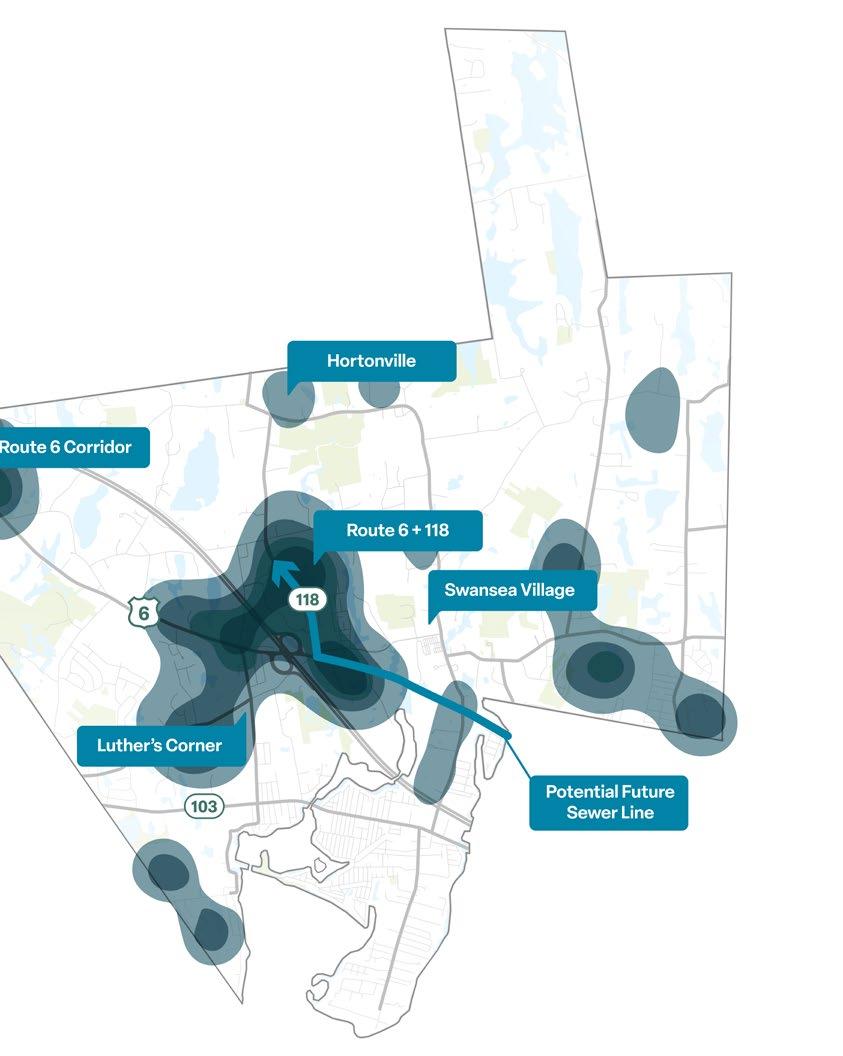
Strategy 3.1-1
Build on the 2021 Wastewater Service IMA with Somerset and the 2023-2024
Route 6/Route 118 Study to Foster Economic and Community Development.
Performance Measures
Priority: High
Year 1: Maintain ongoing, constructive conversations with Somerset, MassDOT, EOED, and U.S. EDA.
Year 2: Complete the Route 6/Route 118 Corridor Study. Ensure that the plan and resulting public-private partnerships identify both mixed-use and commercial/industrial sites and result in private sector commitments for investment and growth.
Year 3-4: Pursue U.S. EDA- or Commonwealth-funded design and engineering and construction awards for wastewater infrastructure.
Complementary Goals and Strategies
3.1-2 Work with the Swansea Redevelopment Authority to pursue an Urban Renewal Plan and detailed proposals for the former Swansea Mall site
Responsible Party
Department of Public Works, Town Planner, and Town Administrator
The lack of wastewater infrastructure along Route 6 has historically been an impediment to higher-value development and redevelopment at key sites along the corridor. In 2018, the U.S. Economic Development Administration (U.S. EDA) awarded the neighboring town of Somerset funding to work with Swansea to negotiate an inter-municipal agreement (IMA) to extend sewer service west along Route 6 corridor and Route 118; the towns officially executed this IMA in March of 2021. It is important to note that, under several other EDA-funded projects, Somerset has also executed upgrades to water and sewer systems that resulted in system capacity improvements that will allow for significant development along Swansea’s Route 6 corridor when those projects come online. Continued, sustained communication with Somerset, MassDOT, the Executive Office of Economic Development (EOED), U.S. EDA, and other partners will be key to maintaining this essential ingredient to economic development in Swansea.
To even further guide future economic and community development, Swansea is actively pursuing a Route 6/Route 118 Corridor Study in 2023 and 2024. This project will seek
to identify an inventory of project-ready sites, accelerate private-sector investment in commercial/industrial and mixed-use projects, and support the conversion of underutilized properties and obsolete facilities into modern, tax-generating uses.
To achieve these outcomes, the Study will explore and visualize potential low-end and high-end redevelopment scenarios on key sites, seeking to explore different use portfolios and building typologies based on stakeholder input and current market data (e.g., demand for retail or office space in Swansea). Its implementation plan will likewise enumerate necessary zoning changes and design guidelines, where applicable; recommend programs to facilitate development, including but not limited to Chapter 43D and the Economic Development Incentive Program (EDIP); inventory any additional roadway, multimodal transportation, or other service and facility needs; and identify public-private partnerships to support further EDA- or Commonwealth-sponsored infrastructure grants ranging from placemaking and transportation projects to design, engineering, and construction funding for the wastewater lines, themselves.
Strategy 3.1-2 Work with the Swansea Redevelopment Authority to pursue an Urban Renewal Plan and detailed proposals for the former Swansea Mall site.
Performance Measures
Priority : High
Year 1-2: Complete an Urban Renewal Plan and obtain approval from the Commonwealth.
Complementary Goals and Strategies
3.1-1 Build on the 2021 Wastewater Service IMA with Somerset and the 2023-2024 Route 6/Route 118 Study to Foster Economic and Community Development.
Goal 3.2 Support the continued growth of new and existing local businesses at key locations in town.
8.3-2 Implement findings from Route 118 and Route 6 Studies.
Responsible Party
Redevelopment Authority, Town Planner, and Town Administrator
“The Massachusetts Legislature established the Urban Renewal Program under Massachusetts General Laws Chapter 121B (M.G.L. c. 121B) to assist communities to revitalize disinvested and underutilized neighborhoods and redevelop substandard, decadent, and blighted open areas for residential, commercial, industrial, business, governmental, recreational, educational, hospital or other uses. Under M.G.L. c. 121B, urban renewal agencies are authorized to undertake a range of public actions to address these conditions in order to create the environment needed to promote sound growth and attract and support private investment in designated urban renewal areas. Future redevelopment within these areas must be undertaken in accordance with use limitations specified in approved Urban Renewal Plans.”

At its May 2019 Town Meeting, Swansea created a Redevelopment Authority; both the Planning Board and the Board of Selectmen sponsored this action. The Authority is governed by an independently elected board of four Swansea residents and one person appointed by the Governor. It works to improve vacant, underutilized, and derelict commercial properties; can remove barriers to growth (such as deed restrictions); and is authorized to buy and sell land, demolish, and rehabilitate buildings and fund itself through its activities.
The distressed and underutilized former Swansea Mall site was one of the main factors that Boards cited when arguing for the Redevelopment Authority. And while the Mall site has seen some recent reinvestment, the scale, intensity of use, and resulting jobs and tax benefits are far below prior levels or the site’s full potential. In short, the roughly 50-acre site represents a huge opportunity for comprehensive, campus-
style redevelopment that achieves numerous housing, economic development, and community development goals described in the Comprehensive Plan.
At the time of this writing (Fall 2023), the Swansea Redevelopment Authority has not completed its Urban Renewal Plan This document provides detailed recommendations for specific sites in town. By providing detailed legal reasoning and real estate market analysis, it goes beyond the scope of corridor studies such as the Route 6/Route 118 Study described above; an approved Urban Renewal Plan is essential to Authority activities. This Comprehensive Plan strongly advocates for the Redevelopment Authority to complete its plan in order to clearly define the Town’s vision for – and to navigate the many legal and financial complexities surrounding –the former Swansea Mall and other critical redevelopment sites.
M.G.L. Chapter 121b Urban Renewal Plan Preparation Guide
Photo 21. Swansea Mall. Kevin Ham, SRPEDD.

Goal 3.2 Support the continued growth of new and
existing local businesses at key locations in town.
Swansea has a small, but significant and long-established cohort of small businesses. However, during public feedback, participants agreed that they would like to see more local and small-scale retail, dining, and grocery stores. Further, folks highlighted corridors along which they would like to see these changes occur – such as Route 6, Route 118, and Route 103. Successfully implementing a concentration of small businesses, particularly when it integrates principles of mixed-use development, relies on establishing a specific area or corridor as a destination or local hub to maintain a consistent customer base. Goal 3.2 provides recommendations, ranging from professional networks of small businesses to improvements in the built environment that will foster the growth of small businesses in town.
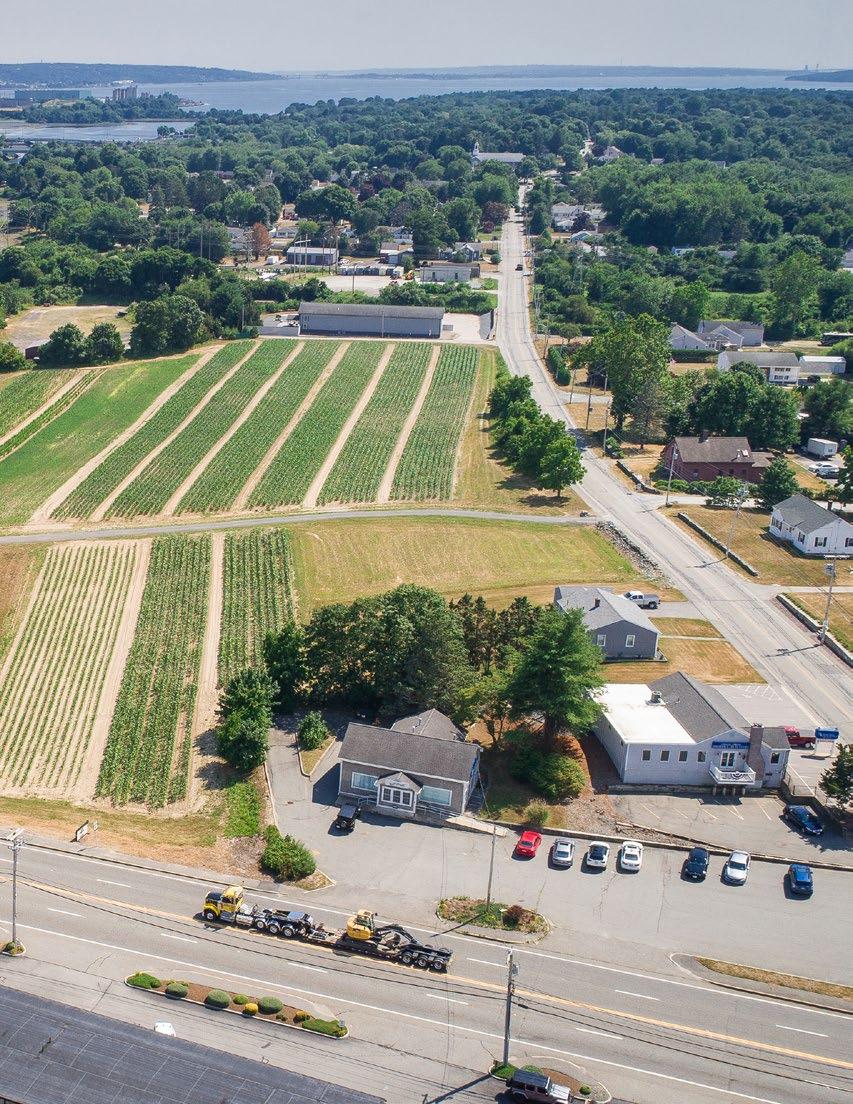
Photo 22. Businesses along Route 6. Kevin Ham, SRPEDD.
Strategy 3.2-1 Identify constraints that are limiting the development of small businesses and inventory locations in town where they may thrive while connecting these businesses to funding sources.
Performance Measures
Priority: Medium
Year 1: Consider approach options including a stand-alone study, or integration of exploration regarding small business constraints into existing or proposed studies.
Year 2: Explore funding through Commonwealth programs to fund necessary study(s).
Year 3: Completion of work and summarization of findings.
Year 4 and on: Implementation of findings in Town zoning and business practices
Complementary Goals and Strategies
3.2-3 Create a formal organization for local small business owners.
3.3-3 Update and publicize Swansea's user-friendly Development and Permitting Guide to facilitate business development.
Responsible Party
Planning Board, Town Planner, Town Clerk, and Select Board
Figure 11. Survey responses - "What should Swansea's top economic development priorities be? (select up to three)"
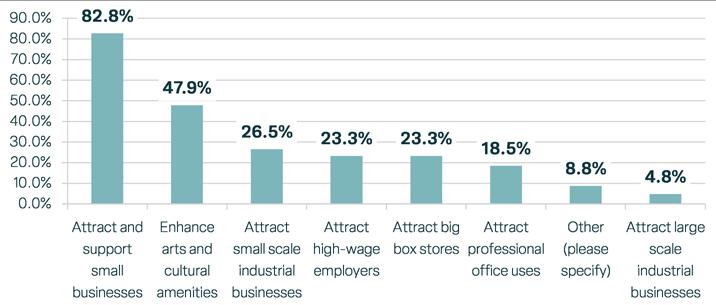
Swansea residents would like to see the tax base expand via more local establishments and small businesses (83% of survey respondents). To achieve this, it is important to explore the current constraints that are limiting business expansion. Local business owners most frequently identified a lack of local business assistance (19%) and lack of access to utilities (19%) the greatest challenges to doing business in town. Similarly, in a separate survey, respondents identified a lack of sewer (74%) and water (68%) utilities as significant constraints. 38% of respondents pointed to a lack of accessible transportation options, such as limited walkability and connections to bus in key areas.
This survey data, which highlights some of the most apparent sticking points related to business development in Swansea, can
serve as the starting point for a deeper study. One option to continue exploring this topic would be to pursue a stand-alone study. A second approach could be to integrate questions about small business development into several of the other studies discussed in this Plan – for example, studies focused on Routes 6, 118, and 103 could explore ways to encourage smaller businesses along those thoroughfares. Additionally, if the Town looked to expand its permitting guide, that effort could include conversations with small business owners to better understand challenges they face during the development and permitting process. Better understanding the challenges that small business owners face, as well as any untapped market potential is a necessary first step in developing more local business in Swansea.
Strategy 3.2-2 Explore public realm opportunities - such as public space improvements and plantings - to enhance Swansea's sense of place.
Performance Measures
Priority: Medium
Year 1-2: Identify potential public realm projects and improvements. Pursue high priority, and / or easy to implement projects.
Year 3: Identify scopes of work, secure funding, and conduct analysis with appropriate consultants for more intensive projects.
Year 4 and on: Implement high-priority, larger-scale improvements.
Complementary Goals and Strategies
6.2-4 Create new passive recreation opportunities in tandem with green infrastructure preservation.
7.2-1 Increase the publicity and number of cultural and community events in town, including pop-ups, food trucks, seasonal lights, etc.
8.1-5 Continue to construct high priority “Complete Streets” improvements in Partnership with MassDOT.
Goal 8.3 Develop key routes to support economic development and improve quality of life.
Responsible Party
Planning Board and Town Planner
The Town of Wakefield undertook a community visioning process for several of its downtown streets, focused on using simple and modest public space improvements to enhance the current sense of place and add charm to the center of Town. In addition to traffic improvements, the town emphasized the addition of public realm improvements such as, wayfinding signage, public seating and plantings, and the lighting of street trees year-round for 24 downtown trees. In addition to pursuing an overall study of several streets, the Town crowdfunded over $29,000 dollars for these improvements, which MassDevelopment matched.
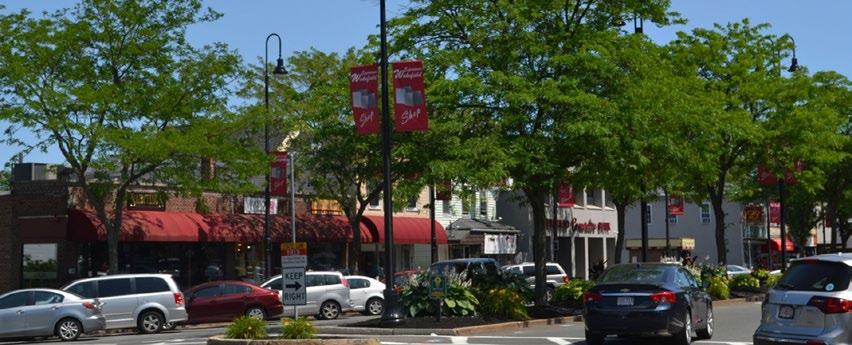
Previous strategies focus on the ways Swansea can increase local zoning flexibility (1.1-3), highlight areas of underutilized real estate (Goal 3.1), and identify constraints to attracting small businesses (3.2-1). While these strategies provide significant and straightforward steps towards enabling the development of establishments, it is necessary to invest in the public realm to encourage successful implementation of these aspirations. In other words, while it is great to attract a new business to town, public realm enhancements that make a location more unique and iconic can help create the conditions / physical environment that will continuously attract both businesses and customers.
Public realm features, such as seating, planting, street trees, benches, and other pedestrian realm improvements help knit together all the establishments in an area. When this happens successfully, local businesses are no longer ‘in competition’ with one another for retail activity, but the
overall area, instead, becomes an attractor, or destination for a greater population of visitors. While all areas of town would benefit from public realm enhancements, it is important to ‘right-size’ these, according to their intensity. For example, a more robust arrangement of public realm improvements may be appropriate for a busier street with commercial traffic, while historic signage, removal of invasive species and replacement with native or adapted plantings may enhance historic vehicular corridors in Town.
The Town can begin by identifying the areas and scopes for projects it would like to conduct, identifying funding sources it would like to pursue, or creating a plan to allocate funds from sources such as the Community Preservation Act. Alongside this, Town staff can create a timeline to implement this work in concert with other ongoing initiatives such as Complete Streets improvements, corridor / redevelopment studies, and critical infrastructure projects.
Photo 23. Town of Wakefield Downtown. Wakefield Main Streets, Inc.
Strategy
3.2-3 Create
a formal organization for local small business owners.
Performance Measures
Priority: Low
Year 1: Explore the creation of, and derive format for a formal small business organization
Year 2-3: Develop charter(s) and legally establish the appropriate organization(s) to represent small businesses.
Year 4 and on: Support initiatives from small business organizations.
Complementary Goals and Strategies
Goal 3.1 Explore new development opportunities along Route 6.
3.2-1 Identify constraints that are limiting the development of small businesses and inventory locations in town where they may thrive while connecting these businesses to funding sources.
8.3-1 Conduct a mobility and land-use study on Route Wilbur Ave / Route 103 to explore creating a walkable, neighborhood center for Ocean Grove.
Responsible Party
Town Planner and Select Board
Additional Reading
Falmouth Village Association
Strategies 3.2-1 and 3.2-2 focus on the components that may be limiting small business development in Swansea. The development of a formal business organization could serve as a complement to these strategies to maximize the impact of business-friendly practices in town and to continue to advocate for conditions that will help grow an environment that is conducive to small business development.
Creating a ‘Main Street’ or ‘Village’ group is a great way to support the economic viability of small and local businesses in key areas such as Route 6, Route 118, or Route 103. These organizations, which are typically established as non-profits, provide services to enhance local business culture by offering development and start-up services, creating business-development programs, organizing events, conducting marketing initiatives, and implementing beautification projects to attract visitors and support local businesses. A small business association could work alongside the Planning Department and Redevelopment Authority to highlight business priorities as part of Swansea’s economic development decisions. Small business associations can be associated with a Business Improvement District, but this is not required.
Case Study: Falmouth Village Association
The Falmouth Village Association works for the betterment of Main Street businesses by providing:
• An atmosphere of vibrant commerce enhanced by commercial, social, and cultural events for all residents and visitors.
• Advertising and promotional support to its retail and professional membership.
• A forum for the exchange of ideas relative to problems and opportunities affecting its members.
• A voice to government and the public in issues important to its members.
The Village Association provides a range of services to enhance business development in one of Cape Cod’s most recognizable downtowns. The Association’s services include providing walking tours, parking information, and information on resources in the village; display of an informational page about businesses in the village; hosting of regular and annual events / festivals; provision of beautification projects; and marketing services for local businesses.
Strategy 3.2-4 Support new Agritourism opportunities in Swansea.
Performance Measures
Priority: Low
Year 1-2: Conduct detailed public feedback related to town sentiment for agritourism (locations, properties, strategies, etc.).
Year 3-4: Assist with securing funding for targeted farm locations.
Year 5 and on: Support implementation of agritourism businesses.
Complementary Goals and Strategies
3.2-1 Identify constraints that are limiting the development of small businesses and inventory locations in town where they may thrive while connecting these businesses to funding sources.
3.2-3 Create a formal organization for local small business owners.
OSRP Objective 2C
OSRP Objective 3A
Responsible Party
Planning Board, Town Planner, Town Clerk, and Zoning Board of Appeals
Additional Reading
MDAR Resource Grants
Community Compact Cabinet Economic Development Best Practices
The National Agricultural Law Center Agritourism Overview
During the public feedback process, participants frequently cited the future of Swansea’s farmland as an area of significant concern. Most participants cited the historical, economic, and cultural value of the town’s history and practice of farming. With this in mind, workshop participants generally did not want to see farmland replaced with open space, but expressed a strong desire to protect the practice of this industry. At the same time, conversations acknowledged the amount of farmland in town (and throughout the Commonwealth) that often becomes available for purchase to developers who wish to subdivide it.
One potential solution is to develop strategies that support agritourism at any of Swansea’s several agricultural properties. These include the Hale Farm, a 44-acre vegetable farm on Locust Street is protected both by Ch. 61A as well as a Conservation Restriction (CR), which means the development rights have been permanently removed. Three dairy and vegetable farms, D’Allesandro Farm (68 acres), Kenneth Baker Farm (95 acres, distinct from the town-owned Baker Farm property), and the Chase Farm (127 acres), have been protected
with Agricultural Preservation Restrictions (APRs). Mason Farm on Locust Street is partially enrolled in Ch. 61A and the Town has been supporting one of the owners to further protect these farmland parcels as well. Additional deed-restricted and Ch. 61A properties can be found in Section V. Inventory of Lands of Conservation and Recreation Interest.
Additionally, there are two equestrian farms in Swansea: Pinegate Farm and Saddle Brook Farm. These is also an Alpaca farm called Moonlight Rose Alpacas, and a cattle farm called Stony Creek Farm. These properties are privately owned and do not have any type of protections placed on them.
Agritourism is a broad and often evolving term; however, most agritourist businesses involve an integration of productive agriculture with a business enterprise that will attract visitors to a farming property. A thriving agritourism industry provide several benefits, ranging from the preservation of agricultural lands to additional revenue sources for an agriculture business, as well as an increase in tax-base and developing a stronger local business culture in town.
For an example of a thriving agritourist business, folks need to look no further than Swansea’s own Ice Cream Barn, which uses milk produced from Baker Farm, a longstanding, multi-generational farm, in its ice cream, which is produced on-site, which in-part allows the farm to continue as a viable agricultural operation. Swansea’s farmland can follow this model with its other farm properties linking their agricultural production directly to a commercial business. Survey respondents identified several agritourism businesses they felt could be viable in town, including:
• Farm / Summer Vacation Camps (61%)
• Retail farm / nursery trades (67%)
• Winery / Vineyard (56%)
• Hosting scenic private events / functions (48%)
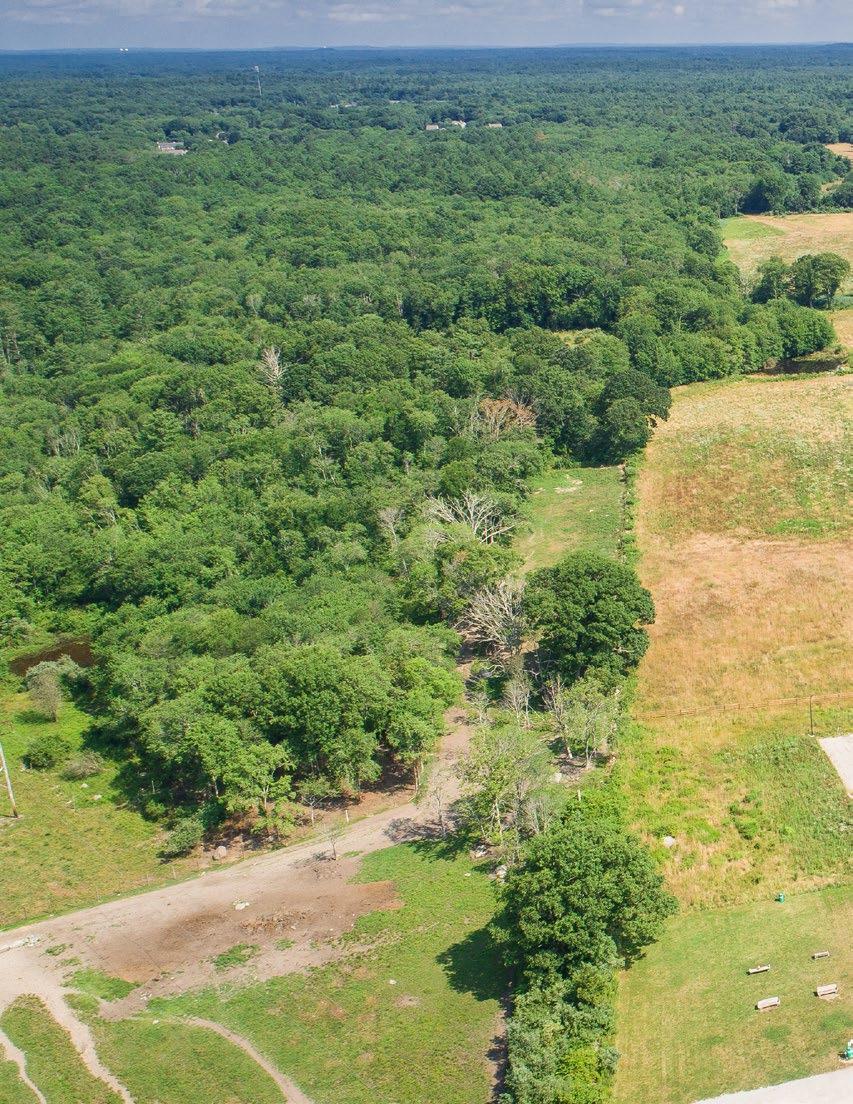
The Commonwealth’s Department of Agriculture (MDAR) provides several grant resources that, depending on the specifics of the farm’s agriculture operation, could combine well with an integration of agritourism. The Commonwealth’s Office of Tourism (MOTT) alongside the Executive Office of Housing and Economic Development (EOHED) offers competitive grants to develop tourism operations through the Destination Development Capital Program (DDC). Additionally, Swansea should pursue a grant to plan and prioritize agriculture as a Best Practice through the Community Compact program, which can allow the town to discuss and strategize, in detail, the best ways to plan for the future of its farming community.
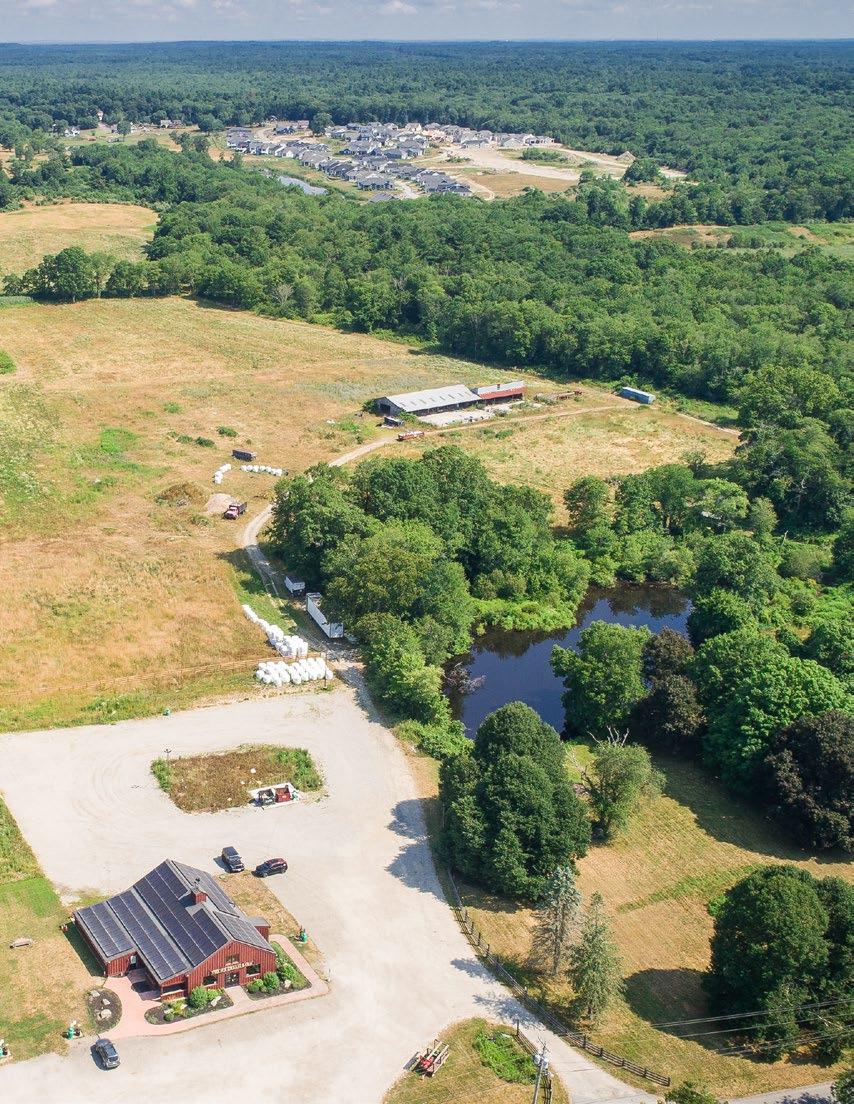
Swansea Comprehensive Plan
Photo 24. The Ice Cream Barn. Kevin Ham, SRPEDD.
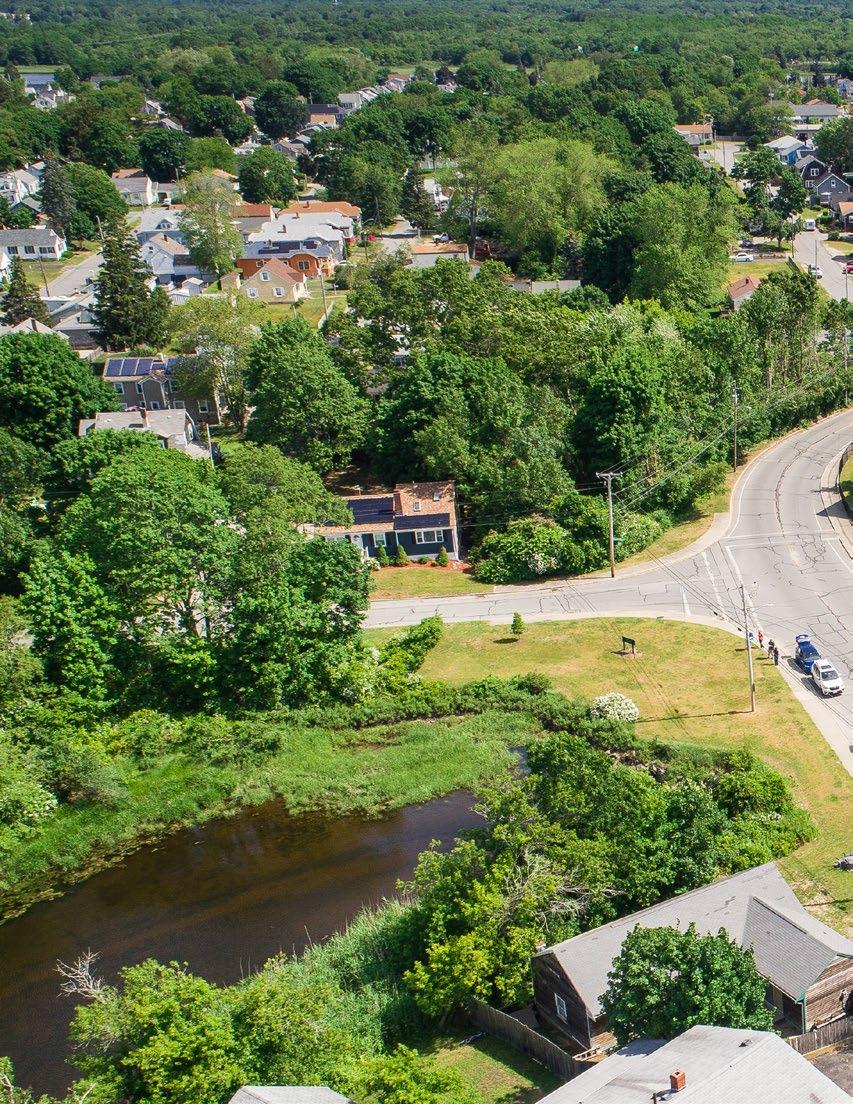
Goal 3.3 Simplify the permitting process to make development more accessible.
The strategies in Goals 3.1 and 3.2 describe mechanisms to produce the specific types of economic development that residents, the Town administration, and visitors would like to see in Swansea. However, the Town’s permitting and development procedures outline the process that brings many of the individual projects to life that ultimately create this change. Goal 3.3 provides a short list of strategies that the Town can pursue to ensure that any bigger-picture aspirations do not get stymied, and that the Town’s process properly incentivizes business owners and developers in Swansea.

Photo 25. Pinehurst Ave and Ocean View Ave. Kevin Ham, SRPEDD.
Strategy 3.3-1 Implement a new e-permitting process for all departments in town.
Performance Measures
Priority: Medium
Year 1-2: Hire any necessary consultants to integrate e-permitting infrastructure for remaining departments.
Year 3: Conduct trials with businesses in town to ensure e-permitting process is navigable.
Year 4: Implement new e-permitting.
Complementary Goals and Strategies
3.2-1 Identify constraints that are limiting the development of small businesses and inventory locations in town where they may thrive while connecting these businesses to funding sources.
3.3-3 Update and publicize Swansea's user-friendly Development and Permitting Guide to facilitate business development.
Responsible Party
Town Planner and Town Clerk
Swansea’s permitting process currently requires permits for a range of building activity, in accordance with the Town’s by-law and Massachusetts General Law. In the development process, it is typical for one project to require several different enabling permits – for example the work associated with this project could require permits for new construction; plumbing and HVAC; demolition of any existing structures currently on the site; grading, drainage, and permits related to wetland interference; and several more.
Currently, potential permit grantees begin this process by viewing the Town’s Permitting Guide (3.3-3) and reaching out to the Town, with the exception of the Building Department, which is currently using e-permitting processes. From there a representative will guide the applicant through the necessary steps to achieve compliance with the building and zoning codes. While this process has produced a
sustained and successful list of development projects, at can be demanding for both Town staff and the permit applicant.
The implementation of an e-permitting system would alleviate some of the work associated with the permitting process. This would entail the development of a website that hosts a system to manage the permitting review process. This webpage would include navigable categories for any relevant permits to the Town, ranging from Fire Marshall review to food establishments, and everything in between. Successful integration of this tool would not replace the personal and accessible relationship the Town maintains when aiding permit applicants. Ultimately it should serve to free up more time for this assistance.
Strategy 3.3-2 Promote the PACE Program to allow for clean energy improvements on commercial properties to be privately financed and paid back through betterments on the town's tax bills.
Performance Measures
Priority: High
Year 1-2: Create promotional materials/implement information about PACE Program into existing Town outreach formats.
Year 3 and on : Work with businesses to increase participation in PACE Program.
Complementary Goals and Strategies
Goal 1.1 Review zoning by-laws to improve clarity and focus development in key areas in town.
6.2-1 Allow compact, climate-resilient adaptations, including raised houses and vertical additions.
Responsible Party
Planning Board, Town Planner, and Building Department
Additional Reading
MassDevelopment's Resource Page on the PACE Program
Property Assessed Clean Energy (PACE) Massachusetts is an innovative program to help commercial and industrial property owners in Massachusetts finance energy improvements. The program lets you agree to a betterment assessment and lien on your property, sufficient to repay the financing extended by a private capital provider. If the property is sold before the financing has been repaid, the assessment stays and is transferred to subsequent property owners.
This program offers the Town of Swansea an opportunity to continue to develop its tax base through attracting commercial properties, while pursuing clean energy systems. By pursuing this initiative, the Town has identified creative ways to increase its tax base by providing a program to attract and retain commercial organizations, while also remaining conscientious of residents’ concerns to maintain Swansea’s environmental and ecological systems. Additionally, the PACE program can apply to industrial, manufacturing, and multifamily developments.
To highlight the Town’s commitment to principles of sustainability, it should market and promote the PACE Program to current and prospective developers and business owners. Some valuable steps the Town can pursue would include:
• Creating informational materials, such as a brochure or webpage identifying contracts for businesses looking to utilize the PACE Program in Swansea
• Integrating information about the PACE Program into the Town’s business and development materials, such as its permitting guide
• Tracking data for organizations and sectors that utilize the PACE Program to identify areas where participation can be improved.
Promotion of the PACE Program would maximize the Town’s investment in clean energy and provide bargaining power to attract new businesses.
Strategy 3.3-3 Update and publicize Swansea's user-friendly Development and Permitting Guide to facilitate business development.
Performance Measures
Priority: Low
Year 1: Increase awareness of Town permitting guide and procedures through existing outreach mechanisms.
Year 2: Identify and make any necessary substantial changes to the permitting guide. Pursue funding through Community Compact Cabinet if necessary.
Year 3 and on: Expand and adapt guide as necessary.
Complementary Goals and Strategies
3.2-1 Identify constraints that are limiting the development of small businesses and inventory locations in town where they may thrive while connecting these businesses to funding sources.
3.2-3 Create a formal organization for local small business owners.
Responsible Party
Planning Board, Town Planner, Town Clerk, and Zoning Board of Appeals
Case Study: Local Permitting Guides
Many local towns have been able to utilize grant funding to provide permitting resources for small and local businesses. The City of Taunton, Town of Mansfield, and Town of Middleborough recently leveraged DLTA funding to pursue visually based and simplified permitting resources to clarify processes that often complicate and slow down local business development. The City of Taunton also utilized Community Compact funding to connect its recent permitting revisions to broader business development efforts to expand its local business network.
While Goal 3.3-1 (implementing e-permitting) identifies a longer-term tool to simplify to the permitting process, Swansea recently created a user-friendly permitting guide to provide direction for those seeking permits. However, during workshops, many individuals still described difficulties navigating the permitting process. These participants outlined it as a challenging hurdle to overcome for those looking to develop business or residential properties. Because of this, the Town should consider further publicizing its permitting guide by including it in updates on the monthly newsletter (7.2-2) or including references in other relevant town document and online resources.
In addition to publicizing the existing permitting guide, the Town could explore updating and expanding its permitting guide. Many permitting guides can take the form of concise handbooks, topic specific brochures, marketing campaigns, E-Government webpages, or a coordinated combination of all the above. They can utilize graphic design, flow charts, and simple diagrams to help describe and simplify required procedures; identify departmental points of contact; and highlight fees, resources, and timelines needed to obtain various permits in town.

Element 4: Open Space & Recreation
Photo 26. Autumn Foliage in a Marsh, Swansea, MA. Howard Eaton.

In Summary: Open Space & Recreation
The following two chapters (Open Space & Recreation and Natural & Cultural Resources) reference the Town's concurrently producing 2023 Open Space and Recreation Plan (OSRP). SRPEDD developed the 2023 OSRP in accordance with the applicable requirements and guidelines as set forth by the Massachusetts Executive Office of Energy and Environmental Affairs (EEA), Division of Conservation Services (DCS), for open space planning. The Commonwealth requires that all municipalities file an Open Space and Recreation Plan every seven (7) years as a means of satisfying eligibility requirements for state and federal grant programs offered through DCS. Having a current OSRP may also grant communities a competitive edge in other state grant programs.
These next two chapters' Goals and Strategies come from the 2023 OSRP's Seven Year Action Plan . For more information on the findings of the OSRP or each individual Goal and Strategy, please see the final report

Goal 4.1 Provide
adequate staffing and facilities to meet the recreational needs of all Town residents.
Most OSRP survey respondents indicated they are “satisfied” with (31.7%) or “neutral” (30.9%) towards recreational services in Swansea. Additional amenities that respondents would like to have available in Swansea are mostly related to different types of special community events, particularly outdoor concerts, movie nights and/or a drive-in movie theater, farmers markets and other types of community festivals and events.
Residents also reported being particularly concerned about the cost of maintaining recreation fields and centers. Public input from both the survey and events identified that there is a very limited budget for maintenance staffing of recreation spaces. The biggest areas for concern when it comes to open space and recreational activities in Swansea are a lack of conservation, upkeep and maintenance of these spaces, and lack of awareness and signage. Goal 4.1 and its accompanying strategies outline how Swansea can work to increase staffing capacity, as well as increase access to and expansion of the town's network of recreational facilities.
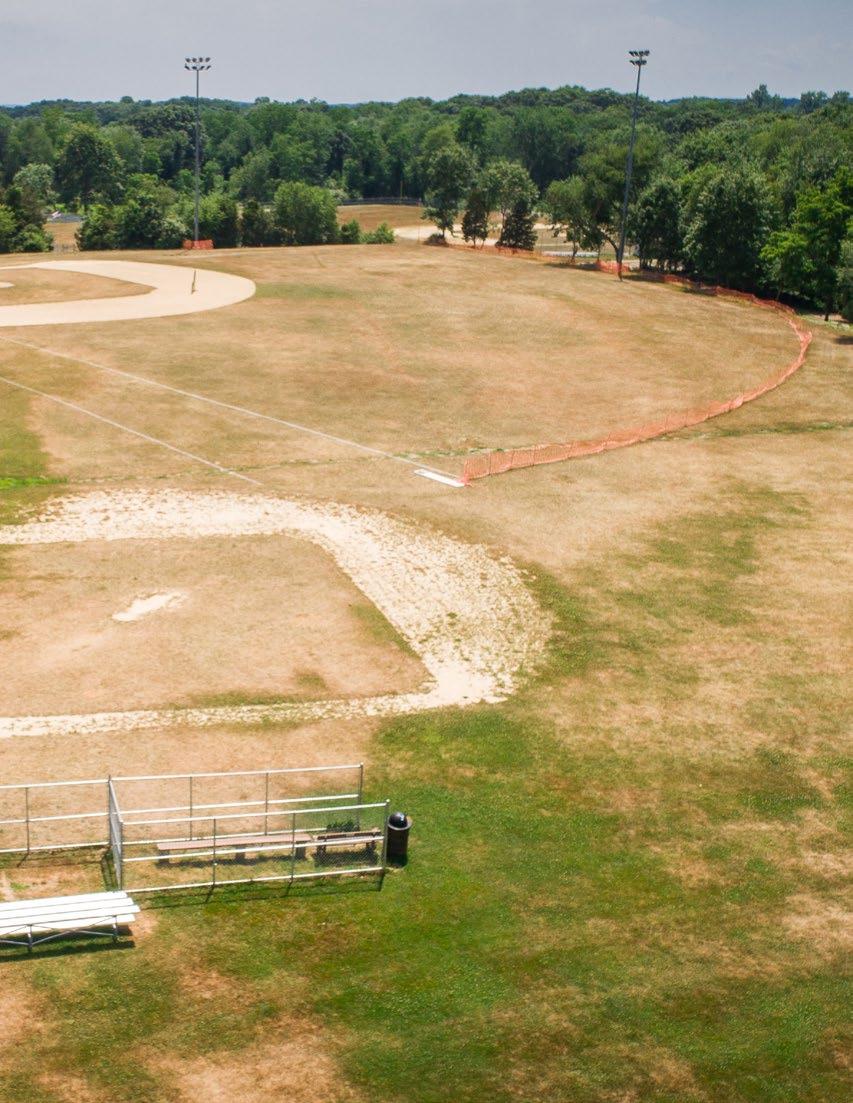
Photo 27. A Ball Field in Swansea. Kevin Ham, SRPEDD.
Strategy 4.1-1 Increase local capacity for management and maintenance of open space & parks.
OSRP References
Objective 4A; Action Items 27-31.
Action items
Identify and implement strategies to increase funding and staffing for facility management
Responsible Parties
Town Administrator, Selectboard
Seek Town support for expanding resources allocated to Town open space
Increase local volunteer support to assist Wildlands Trust in managing lands and offering more public trails
Assess Town committee and board volunteer needs and set goals and expectations to help recruit more community volunteers to participate
Recruit volunteers to help maintain Town open space properties (i.e. "adopta-spot" program, "friends of" program, sponsorships, boy scout projects)
Town Administrator, Parks & Recreation Open Space Committee, ADA Committee, Committee
Town Administrator, Conservation Wildlands Trust
Town Administrator, Selectboard, Open Space Committee, Master Plan
Town Administrator, Open Space Committee, Recreation Commission
High 1-3 years
Recreation Commission, Committee, Master Plan Medium Ongoing
Commission, Low Ongoing
Planning Board, Plan Committee Medium Ongoing
Committee, Parks & Low 3-5 years
Municipal Budget, explore financing strategies through permitting and/or user fees
Municipal Budget/regular operations, support from partners and/or volunteers
Municipal operations, support from partners and/or volunteers
Municipal Budget/regular operations, support from partners and/or volunteers
Municipal Budget/regular operations, support from partners and/or volunteers, support from private donors
Strategy 4.1-2 Improve existing recreational facilities and programs.
OSRP References
Objective 4B; Action Items 32-38.
Action items Responsible Parties
Identify funding to implement ADA transition plan, possibly in conjunction with other suggested improvements
Provide picnic amenities in suitable locations
Formalize and expand parking areas at Town parks (especially at Sandy Beach to reduce congestion at boat ramp, Milford St Playground, athletic fields)
Post identifying signage at all Town-owned open space parcels and at future acquisitions (particularly the collection of parcels collectively known as Veterans Memorial Park).
Formalize and mark trail network at Village Park (separating hiking and biking trails to reduce user conflicts) and develop trail maps
Install bike racks at Town open spaces to improve accessibility by bike
Establish public database of public open spaces and allowed uses at each
Town Administrator, ADA Coordinator, Parks & Recreation Commission
Town Administrator, Parks & Recreation Open Space Committee
Parks & Recreation Commission, Highway
Town Administrator, Selectboard
Parks & Recreation Commission, Highway Town Administrator, Open Space Committee
Parks & Recreation Commission, Open Committee
Town Administrator, Parks & Recreation
Open Space Committee, Selectboard, Committee, Highway Department
Parks & Recreation Commission, Open Committee, Town Administrator
Coordinator, Selecboard, Low Ongoing
Recreation Commission, Low 3-5 years
Highway Department, Low 1-5 years
Highway Department, Committee Medium Ongoing
Open Space Low 3-5 years
Recreation Commission,
Selectboard, Master Plan
Open Space
years
MA Office on Disability (MOD) grants, Community Preservation Fund
Community Preservation Fund
Municipal Budget, explore potential grant sources
Municipal Budget/regular operations, support from partners and/or volunteers
Division of Conservation Services (DCS) grants, Community Preservation Fund
Municipal Budget, Community Preservation Fund
Municipal Budget/regular operations, SRPEDD technical assistance, support from partners and/or volunteers
Strategy 4.1-3 Provide additional facilities and programs that meet the needs of the community.
OSRP References
Objective 4C; Action Items 39-46.
Action items
Identify parcels of recreation potential, especially in under-served areas (including Ocean Grove, Smokerise Circle, Rosewood), for playgrounds and neighborhood parks
Analyze & expand existing and establish new programs for elderly
Explore options for an indoor recreational facility
Assess recreational use potential at Town parcels on Little Neck
Organize more community events, such as outdoor concerts, movie nights, festivals
Offer more recurring organized activities, such as fitness and craft classes and youth group activities
Establish one or more dog parks
Establish one or more skate parks (consider Medeiros Farm as potential location)
Responsible Parties
Parks & Recreation Commission, Open Committee, Selectboard
Council on Aging, ADA Coordinator, Commission, Open Space Committee
Parks & Recreation Commission, Selectboard, Swansea Sports Corp
Parks & Recreation Commission, Open Committee
Town Administrator, Parks & Recreation Council on Aging, Open Space Committee, Plan Committee
Parks and Recreation Commission, Open Space Committee, Master Plan Swansea Sports Corp, Council on
Parks & Recreation Commission, Open Committee
Parks & Recreation Commission, Open Committee
Priority Timeframe Potential Funding Source(s)
Open Space Low 5-7 years
Coordinator, Parks & Recreation Committee Low 4-7 years
Selectboard, Low 3-5 years
Open Space
Recreation Commission, Committee, Master
Commission, School District, Plan Committee, Aging
Open Space
Open Space
3-5 years
4-7 years
4-6 years
2-5 years
4-7 years
Division of Conservation Services (DCS) grants, Community Preservation Fund
Municipal budget/regular operations, support from partners and volunteers, explore potential grant sources
Division of Conservation Services (DCS) grants, Community Preservation Fund
Municipal budget, support from partners and volunteers
Municipal budget, support from partners and volunteers
Municipal budget, support from partners and volunteers
Division of Conservation Services (DCS) grants, Community Preservation Fund
Division of Conservation Services (DCS) grants, Community Preservation Fund
Strategy 4.1-4 Expand Swansea’s hiking and biking trail network.
OSRP References
Objective 4D; Action Items 47-50.
Action items
Consider the establishment and completion of a cohesive green belt in the areas between Stevens Rd and Marvel St from Sharps Lot to Bark St; Town Farm, YMCA, Medeiros Farm, and open space land attached to OSRD's, which could be connected with trails
Responsible Parties
Open Space Committee, Parks & Recreation Commission, Conservation Commission
Explore potential for formalizing use of power lines for hiking and bike trails
Establish a trail network on the newly acquired Baker Farm and Delmac properties behind Case High School, with connections to existing trails nearby
Formalize bike lanes along Warren Ave. and Route 103, exploring potential connections to the East Bay Bike Path
Open Space Committee, Parks & Recreation Commission
Parks & Recreation Commission, Open Committee, Conservation Commission
Parks & Recreation Commission, Open Committee, Master Plan Committee, Highway Department (with support
Recreation Commission
Low 5-7 years
Division of Conservation Services (DCS) grants, Community Preservation Fund, MassTrails grants
Recreation
Low 5-7 years
Open Space Commission
Open Space Committee, Planning Board, support from SRPEDD)
High 1-3 years
Municipal budget, support from partners and volunteers
MassTrails grants, Division of Conservation Services (DCS) grants, Community Preservation Fund
Medium 4-6 years
MassTrails grants, MassDOT Complete Streets funding, state earmarks, Community One-stop Grant
Strategy 4.1-5 Improve public access to riverfront and coastal resources.
OSRP References
Objective 4D; Action Items 51-57.
Action items
Assess potential uses of and public access to Sears Farm Town property
Continue to assess public access to coastal and river resources and prepare plans for improving access
Develop a roadside signage system of waterways to identify their names and characteristics to improve public awareness of water resources
Assess town-wide canoe and boat access; improve access and parking areas
Install new ADA accessible kayak launches (consider the following potential locations: Lewin Brook next to Joseph Case Junior High School; Lees River at Veterans Memorial Park; Cole River right-of-way south of Route 103)
Place and monitor signage identifying public rights-of-way and distinguishing public vs private coastal access areas
Identify Town department / staff to oversee coastal access issues, enforce access rights and maintain signage and rights-of-way
Responsible Parties
Highway Department, Open Space Conservation Commission, Parks and Commission
Harbor Advisory Committee, Swansea Selectboard, Open Space Committee,
Open Space Committee, Conservation Harbor Advisory Committee, Highway
Parks & Recreation Commission, Open Committee, Harbor Advisory Committee, Highway Department
ADA Coordinator, Parks & Recreation Highway Department, Harbor Advisory
Harbor Advisory Committee, Selectboard, Safe Passage, Save the Bay, Highway
Town Administrator, Harbor Advisory Selectboard
Space Committee, and Recreation
Swansea Safe Passage, Committee, Save the Bay
Conservation Commission, Highway Department
Open Space
Committee, Selectboard,
Recreation Commission, Advisory Committee
Selectboard, Swansea Highway Department
Advisory Committee,
operations
Municipal budget/regular operations, support from partners
Municipal budget, partner support, explore potential grant opportunities
Municipal budget/regular operations, support from partners and/or volunteers
Division of Conservation Services (DCS) grants, Community Preservation Fund
from
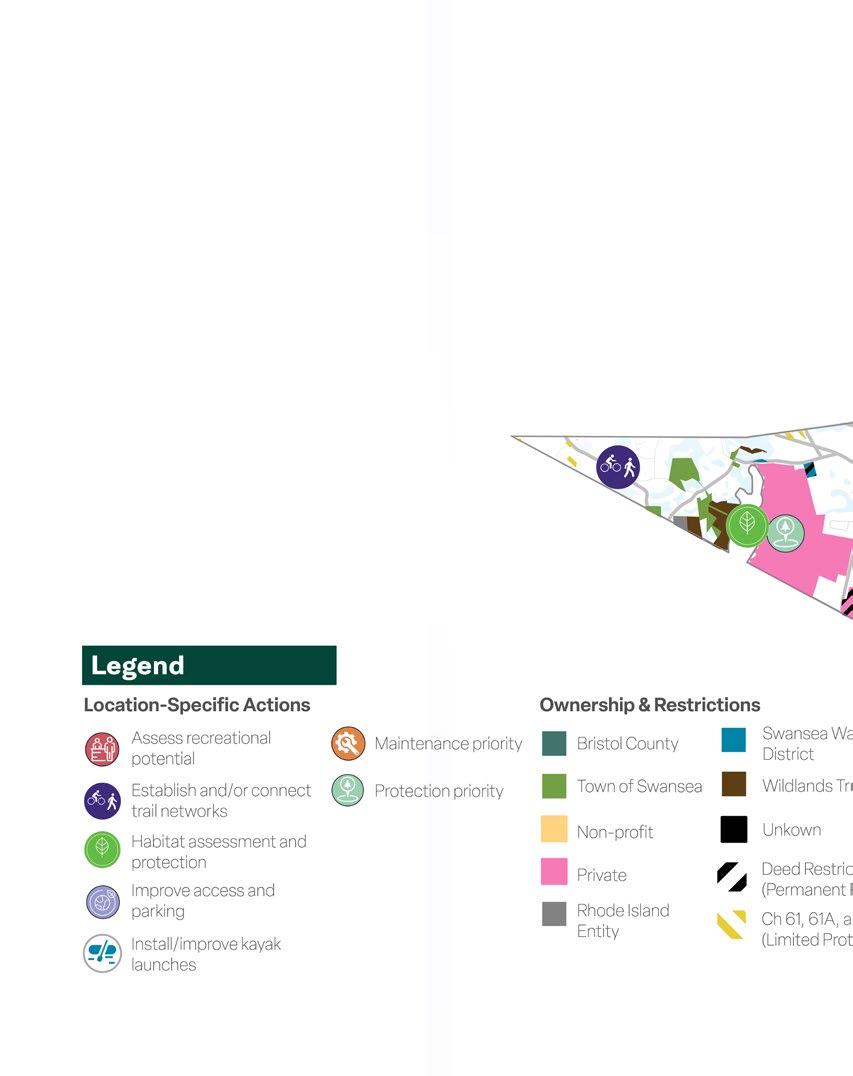
Goal 4.2 Carry out the Open Space and Recreation Plan goals and objectives.
This Comprehensive Plan's sister document, the Open Space and Recreation Plan (OSRP) provides a series of recommendations, based on public feedback and developed under the guidance of the OSRP steering committee. The OSRP provides a number of goals and strategies - identified on this mapthat can help ensure a healthy and diversified breadth of open spaces across Swansea.
Map 8. OSRP Actions and Land Ownership.
The parcels shown on this map are colored based on ownership, with hatching to indicate conservation restrictions. Each icon corresponds to a location-specific action.
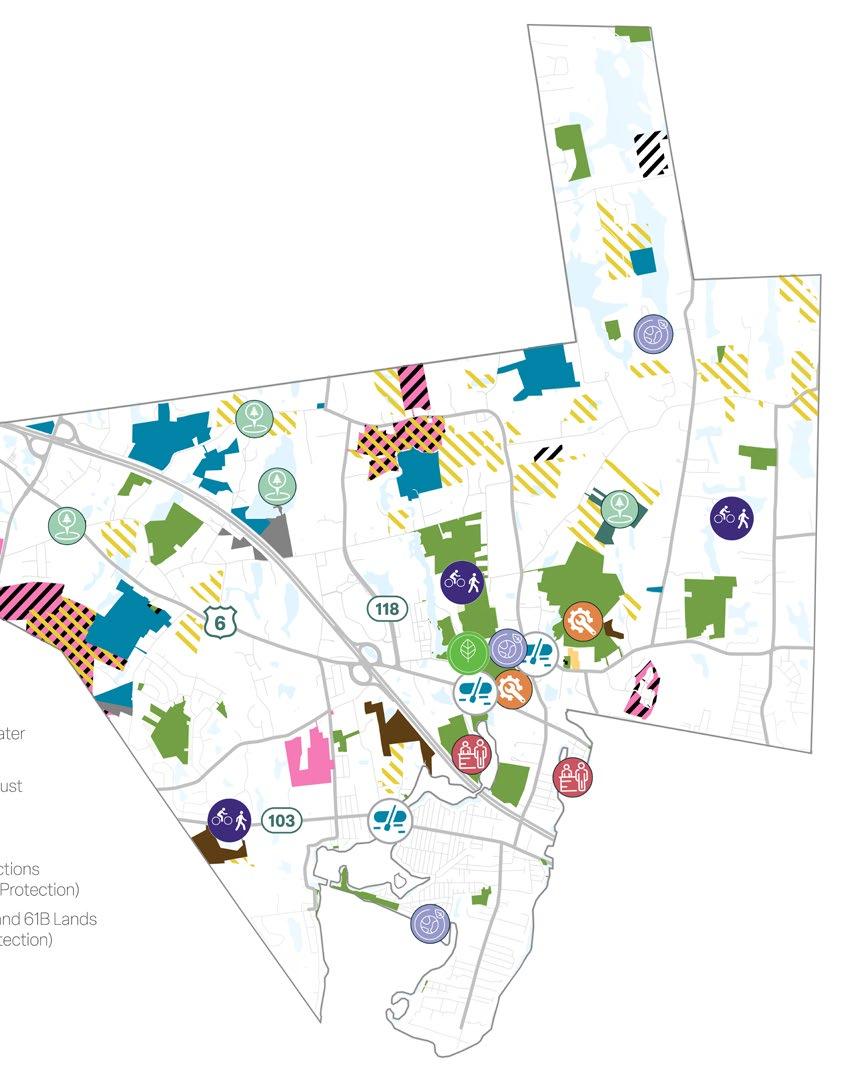
Strategy 4.2-1 Establish a framework for implementing the action plan.
OSRP References
Objective 5A; Action Items 58-60.
Action items
Continue the Open Space Committee and formalize its responsibilities as a standing implementation committee (i.e. working with other town and regional staff and organizations on grant writing, planning)
Responsible Parties
Open Space Committee, Town Administrator
Circulate and publicize Action Plan to the community, encouraging public to take ownership and get involved in implementation
Open Space Committee, Master Plan Town Administrator, SRPEDD
Support the completion of the Town’s Comprehensive Master Plan, ensuring open space priorities are incorporated Master Plan Committee, SRPEDD,
Administrator Medium Ongoing
Municipal operations, volunteer board members
Plan Committee, Medium 1-3 years
Municipal budget/regular operations, support from partners and/or volunteers
Town Planner Low 1-3 years
Municipal budget/regular operations, SRPEDD technical assistance
Strategy 4.2-2 Coordinate a townwide regulatory approach that supports plan implementation.
OSRP References
Objective 5B; Action Items 61-67.
Action Items
Prepare a comprehensive resource protection zoning overlay district and bylaw (include water resources, scenic corridors/viewsheds, river corridors, etc.)
Adopt a preservation bylaw for delaying demolition of historic properties
Adopt road and sidewalk standards across departments to coordinate improvements and funding sources for implementation
Assess the effectiveness of existing regulations to protect water resources and promote aquifer recharge, and identify any necessary improvements
Review and improve, as needed, Conservation Subdivision Bylaw to aid in the protection of high quality natural areas
Continue to implement Town’s Stormwater Management Plan, in compliance with MS4 permit
Identify opportunities within the Town’s existing regulatory framework to incorporate tree protections and encourage tree planting in new development
Responsible Parties
Town Planner, Planning Board, Zoning Appeals, Conservation Commission, Commission
Town Planner, Planning Board, Historical Zoning Board of Appeals
Planning Board, Highway Department, Historical Commission, Town Administrator
Town Planner, Planning Board, Conservation Commission, Swansea Water District
Conservation Commission, Town Planner, Board, Zoning Board of Appeals
Stormwater Coordinator, Highway Conservation Commission
Town Planner, Conservation Commission, Department
Priority Timeframe Potential Funding Source(s)
Zoning Board of Commission, Historical Low 5-7 years
Historical Commission, Low 2-5 years
Department, Selectboard, Administrator Low Ongoing
Conservation District
Planner, Planning
2-5 years
3-5 years
Department, Low Ongoing
Commission, Highway Medium 3-5 years
Municipal budget/regular operations, Executive Office of Energy and Environmental Affairs (EEA) Planning Grants, SRPEDD technical support
Municipal budget/regular operations, SRPEDD technical assistance
Municipal budget/regular operations; MassDOT grants, MassTrails grants for implementation
Municipal Budget/regular operations, SRPEDD technical assistance, Executive Office of Energy and Environmental Affairs (EEA) Planning Grants
Municipal Budget/regular operations, SRPEDD technical assistance, Executive Office of Energy and Environmental Affairs (EEA) Planning Grants
Municipal budget/regular operations, SNEP Network technical assistance
Municipal budget/regular operations, SRPEDD Technical Assistance

Element 5: Natural & Cultural Resources
Photo 28. A Snowy Egret near the Coles River. Howard Eaton.

In Summary: Natural & Cultural Resources
Alongside the aforementioned Open Space & Recreation Chapter (Chapter 4), the Natural & Cultural Resources chapter references the Town's concurrently produced 2023 Open Space and Recreation Plan (OSRP). Goals and strategies in this chapter complement those identified in Chapter 4 for protecting and enhancing open space. However, the strategies in this chapter emphasize natural and cultural lands with particular focus on the protection of water supplies and resource areas; natural;, scenic, and cultural resources; conservation of wildlife habitat; and industries such as shellfishing and farming. Please see the final report for more information.

Goal 5.1 Protect the public water supply, wetlands and waterways.
While many communities throughout southeastern Massachusetts celebrate local connections to waterbodies, even in a region with such abundance, few towns are as rich with water resources as Swansea. During the planning process, residents highlighted the importance of this connection. Survey respondents identified land that protects water resources and drinking water supplies as the most important as the most important to protect (80% identifying it as very important, with 16% somewhat important).
The following goal looks at the ways to protect water supplies and water resource areas, while also ensuring that the town is emphasizes these water resources' resilience in within the context of a changing climate.

Swansea Comprehensive Plan
Photo 29. The Coles River and Mt. Hope Bay. Howard Eaton.
Strategy 5.1-1 Assess and implement strategies to protect water supplies.
OSRP References
Objective 1A; Action Items 1-4.
Action Items
Develop a Comprehensive Water Resource Management Plan (CWRMP) that addresses drinking water supplies, water quality threats, and wastewater management
Responsible Parties
Swansea Water District, Board of Health, Commission, Planning Board, Building Sewer Commission, Highway Department, Administrator
Continue to coordinate on and support acquisition of additional land area around existing and proposed wellheads
Revitalize River Aware public awareness campaign for the Palmer, Lees, Coles, and Kickamuit Rivers (coordinate with Save The Bay and Friends of the Palmer River)
Launch a public awareness campaign that educates residents about the importance of water conservation and ways to reduce unnecessary water consumption
Swansea Water District, Conservation Planning Board, Selectboard, Open
Harbor Advisory Committee, Conservation Commission, Open Space Committee,
Swansea Water District, Conservation Planning Board, Selectboard
Health, Conservation Building Department, Department, Town High 2-5 years
U.S. Economic Development Administration (EDA), Municipal Budget/regular operations
Conservation Commission, Open Space Committee
High Ongoing DCS Drinking Water Supply Protection Grant Program
Conservation Committee, Planning Board High 2-5 years
Southeast New England Program (SNEP), Narragansett Bay Estuary Program (NBEP)
Conservation Commission, High 2-5 years
Municipal & Water District Budget/regular operations, partner support; explore transferable models from other communities
Strategy 5.1-2 Identify, assess and protect water resource areas.
OSRP References
Objective 1B; Action Items 5-8.
Action Items
In coordination with state, utilize interns, staff and/or the Town's GIS contractor to remain current with local wetland and vernal pool maps and data, or with other data needs as requested by the Conservation Commission
Responsible Parties
Town Administrator, Conservation
Continue to certify potential vernal pools across Town (work with Wildlands Trust and other local environmental organizations, volunteers and school groups to support field verification and application process).
Secure funding to complete habitat and water quality assessment of Mount Hope Pond on the Coles River (with Save the Bay)
Narragansett Bay Watershed Team, Commission, RiverAware, Wildlands
Identify potential areas for stormwater infiltration and retrofits to improve water quality of impaired waters.
Save The Bay, Conservation Commission, Advisory Committee
Stormwater Coordinator, Highway Conservation Commission (with assistance SRPEDD, Save the Bay)
Commission High 1-3 years
Municipal Budget/regular operations, partner support
Team, Conservation Wildlands Trust
High Ongoing
Municipal Budget/regular operations, partner support Commission, Harbor
High 1-3 years
Department, assistance from High 1-3 years
Southeast New England Program (SNEP), Narragansett Bay Estuary Program (NBEP), Municipal Vulnerability Preparedness (MVP) Program
Southeast New England Program (SNEP),
Narragansett Bay Estuary Program (NBEP), Municipal Vulnerability Preparedness (MVP) Program
Strategy 5.1-3 Plan for the resilience of Swansea’s water resources in anticipation of climate change impacts.
OSRP References
Objective 1C; Action Items 9-11.
Action Items
Identify and protect low-lying lands and marsh migration areas
Preserve and/or restore forested buffers along waterways, particularly unprotected lands along the Palmer and Lees Rivers (coordinate with Save The Bay and Friends of the Palmer River)
Responsible Parties
Conservation Commission, Open Space (with assistance from Save the Bay)
Conservation Commission, Open Space
Explore programs that fund local tree planting and maintenance, in order to protect water resources (i.e. Tree City USA)
Town Administrator, Conservation & Recreation Commission
Space Committee Bay)
Medium 1-3 years
Municipal Budget/regular operations, partner support, CZM grants, MVP Action grant
Space Committee
Medium Ongoing
MVP Grants / SNEP Grants
Conservation Commission, Parks
Medium 1-3 years
Tree City USA, Executive Office of Energy & Environmental Affairs (EEA) grants

Goal 5.2 Protect and preserve Swansea’s
natural, scenic, historical and cultural resources.
Swansea has myriad natural, cultural, and scenic resources. From Hailes Hill to the Warren Reservoir, many sites throughout town provide high conservation value. Lands along the town's river system provide immeasurable habitat value. Additionally, some of Swansea's iconic corridors - such as Main Street - and notable historic properties - like the Martin House - maintain significant scenic and historic integrity. Goal 5.2 explores the ways that Swansea can identify, protect, and preserve its most valuable natural and cultural resources.

Photo 30. Morning Fog on the Coles River and Mt. Hope Bay. Howard Eaton.
Strategy 5.2-1 Negotiate the purchase and/or protection of priority conservation lands.
OSRP References
Objective 2A; Action Items 12-16.
Action Items
Consider conveyance of Bristol County Hailes Hill parcel to Town’s open space network
Review protection status of Town-owned open space parcels and consider transferring high priority parcels to the Conservation Commission for permanent protection
Consider options for long-term preservation of the three country clubs/golf courses in Town, particularly to protect these properties from potential future development if sold
Acquire Warren Reservoir from the Bristol County (RI) Water Authority, assess its suitability for a supplemental drinking water source or recreation, and manage appropriately
Increase public education about conservation options for private property to ease responsibility on Conservation Commission to protect land
Responsible Parties
Selectboard, Open Space Committee, Commission, Planning Board
Selectboard, Open Space Committee, Commission, Planning Board
Planning Board, Conservation Commission support from Save The Bay, The Nature SRPEDD)
Swansea Water District, Town Administrator
Conservation Commission (with resources Audubon and MassWildlife)
Committee, Conservation Low 5-7 years
Committee, Conservation
Community Preservation Fund, Division of Conservation Services (DCS) Grants
2-5 years Municipal Budget/regular operations, partner support
Commission (with Nature Conservancy, Low 3-5 years Division of Conservation Services (DCS) grants
Administrator
(DCS) grants
resources from Mass
Strategy 5.2-2 Preserve connected corridors through Town for water movement, wildlife and community resilience.
OSRP References
Objective 2B; Action Items 17-18.
Action Items
Identify key open space corridors (including “Greenbelts” along the Palmer, Kickamuit, Coles and Lees Rivers) and, as opportunities arise and resources allow, acquire parcels along these corridors to protect them from sale or development (coordinate with property owners, the Town of Rehoboth, Save the Bay, Friends of the Palmer River)
Responsible Parties
Work with local and regional environmental organizations to advance habitat restoration and enable future marsh migration along the Palmer River
Open Space Committee, Conservation Planning Board, Selectboard
Conservation Commission, Open Space Planning Board (in partnership with SRPEDD, Wildlands Trust, Friends
Conservation Commission, Low Ongoing
Municipal Budget, Division of Conservation Services (DCS) grants, Community Preservation Fund
Space Committee, with Save the Bay, of the Palmer River) Low Ongoing
Division of Conservation Services (DCS) grants, Municipal Vulnerability Preparedness (MVP) Program, Southeast New England Program (SNEP) grants
Strategy 5.2-3 Preserve areas of significant scenic, historical, and cultural integrity.
OSRP References
Objective 2C; Action Items 19-22.
Action Items
Conduct an inventory of important scenic and cultural landscapes (coordinate with Sowams Heritage Area Project)
Work with local and Massachusetts Historical Commissions and other regional groups (such as the Sowams Heritage Area Project) to plan and fund resource protection efforts
Explore historical and cultural designations that could offer funding for preservation (i.e. Cultural District Designation for Main Street / Milford Road; Certified Local Government national designation, etc.)
Secure permanent protection for the Martin House historical property.
Responsible Parties
Open Space Committee, Historical Selectboard, Planning Board
Historical Commission, Conservation Planning Board
Cultural Council
Cultural Council, Conservation Commission, Space Committee, The Colonial Dames
Historical Commission,
Priority Timeframe Potential Funding Source(s)
Low 2-5 years
Town staff and volunteer time
Conservation Commission,
Low Ongoing
Division of Conservation Services (DCS) Grants, National Park Service grants
Commission, Open Dames
Low 1-3 years
Town staff and volunteer time
Medium 5-7 years
Division of Conservation Services (DCS) Grants, National Park Service grants
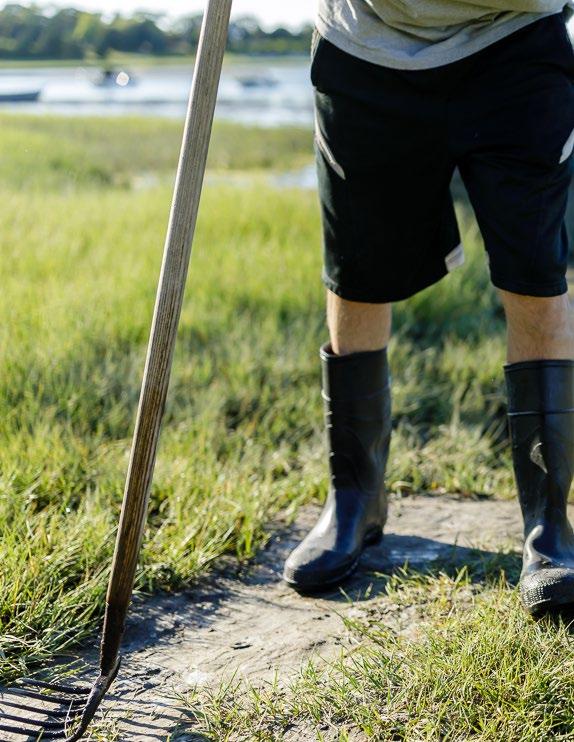
Goal 5.3 Protect Swansea’s Agriculture and Shellfishing Industries.
The town of Swansea has a strong presence of agriculture and shellfishing industry. The strategies in this chapter explore the ways that the Town can continue to support its current agriculture and shellfishing operations; facilitate adaptations of these industries; and ultimately restore, enhance, and expand opportunities for the practice of agriculture and shellfishing in Swansea.

Photo 31. A local harvests shellfish from an estuary in Eastham, Cape Cod. Raj Das.
Strategy 5.3-1 Support local farmers and protect farmland.
OSRP References
Objective 3A; Action Items 23-25.
Action Items Responsible Parties
Form committee to coordinate with regional agricultural groups to assist local farmers and encourage new agricultural activities on prime soils
Conservation Commission, Planning Selectboard
Explore and/or encourage protection programs (i.e. APR, CR) on priority farmland Open Space Committee, Conservation
Work with landowner to secure a permanent Agricultural Preservation Restriction on the Mason Farm property on Locust Street.
Conservation Commission, Open Space
& volunteer support
Conservation Commission Low Ongoing Municipal budget/regular operations, partner support Space Committee
years
Massachusetts Department of Agricultural Resources technical assistance and grant programs
Strategy 5.3-2 Restore shellfishing in the Palmer, Coles and Lees Rivers.
OSRP References
Objective 3B; Action Item 26.
Action Items
Establish a shellfish restoration program that improves water quality in the Palmer, Coles and Lees Rivers and reduces shellfishing closures
Responsible Parties
Harbor Advisory Committee, Board Conservation Commission (in collaboration the Bay, UMass Dartmouth)
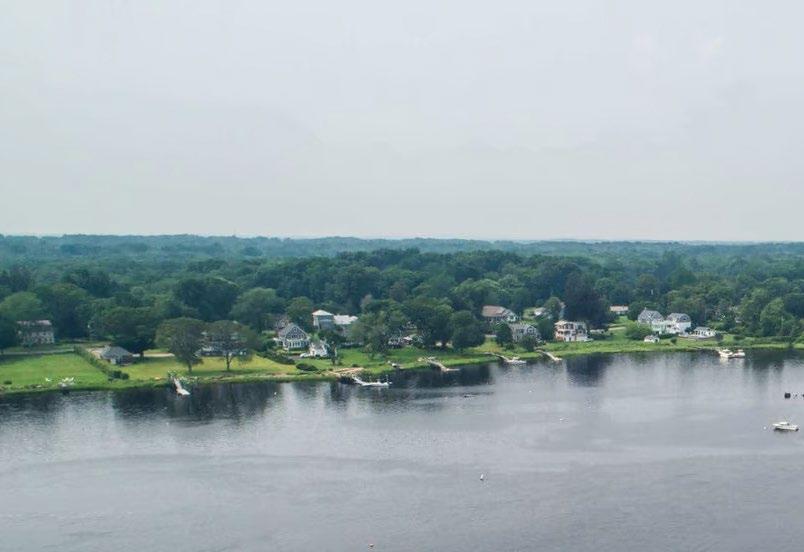
Photo 32. Coles River Estuary and Residential Neighborhoods. Town of Swansea.
Board of Health, collaboration with Save Medium 1-3 years
Source(s)
CZM Grants, Municipal Vulnerability Preparedness (MVP) Program, Southeast New England Program (SNEP), Narragansett Bay Estuary Program (NBEP)

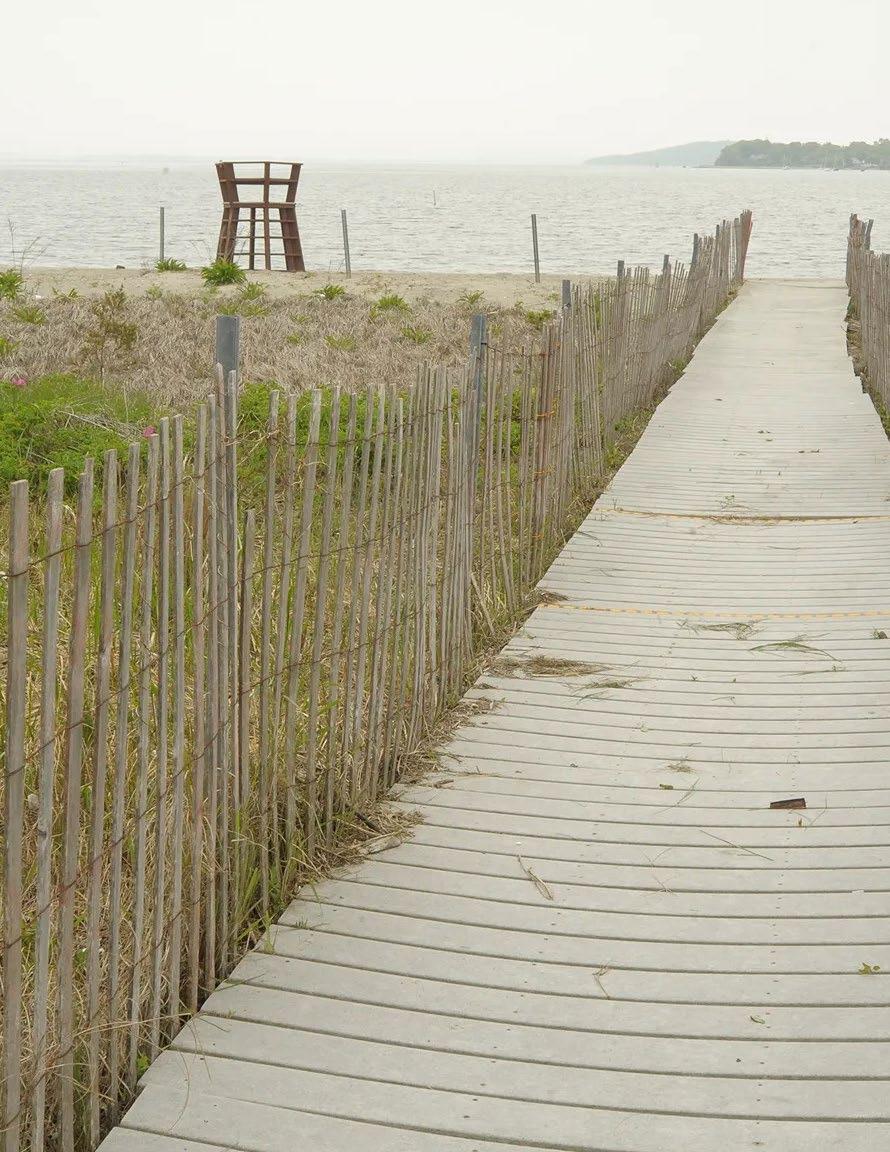
Element 6: Climate & Resilience
Photo 33. Swansea Town Beach. Wicked Local.

In Summary: Climate & Resilience
Swansea, like all coastal communities, should plan for its future within the context of a changing climate and increasing prevalence of environmental hazards. Given the town's aging population and proximity to an extensive riverine system, Swansea should prioritize preparing for potential extreme weather events and natural disasters. This includes expanding municipal resources for emergency preparedness, as well as improving supportive municipal services to create more resilient, climate-ready communities.
The strategies in this chapter identify a series of steps the Town could make to address any potential climatic impacts Swansea may face, while providing additional opportunities for open space, recreation, transportation networks, and more. Through improvements to municipal facilities via energy efficiency upgrades, implementing sewer service expansions, and increasing resident awareness and preparedness, the Town can ensure its residents and its natural resources are protected in both the short-term and long-term.

Goal 6.1 Develop Town facilities and infrastructure to increase climate resilience.
Rising temperatures and the potential for more frequent and/or severe storm events means the Town of Swansea should be prepared to support its most vulnerable populations in the event of a natural disaster. Older residents, children, those with disabilities, and individuals living alone are some of the most vulnerable during extreme weather events. By proactively planning for these events, the Town can work to support, protect, and ensure the safety of its residents and equitable access to the Town’s shared resources.

Photo 34. A sign outside of a cooling center in Los Angeles. Ashley Balderrama.
Strategy 6.1-1 Ensure vulnerable populations, including older adults/senior residents, have access to air conditioning during heat events.
Performance Measures
Priority: Medium
Year 1: Identify current/potential locations for cooling stations and determine the feasibility of applying for Green Communities Designation.
Year 1-2: Identify changes necessary for Designation OR Apply for Green Communities Designation if all criteria are met.
Year 2-3: Ensure that Town is providing adequate cooling at these locations. If eligible, apply for a Green Communities grant.
Year 4 and on: Expand and adapt portfolio of cooling stations as necessary. If eligible, continue applying for Green Communities competitive grants.
Complementary Goals and Strategies
6.1-2 Continue to explore opportunities to expand Swansea's water capacity through infrastructure improvements and new IMAs with neighboring RI communities and Somerset.
7.1-1 Explore the feasibility of upgrading Town-owned properties such as the Council on Aging, and the Town Annex to enable use of its facilities.
Responsible Party
Town Planner, Planning Board, Conservation, and Building Dept.
Additional Reading
Green Communities Designation and Grant Program Guidance
The years 2016, 2019, and 2020 have been the hottest years on record, taking first, second, and third place, respectively. More locally, July of 2023 served as the hottest month on record in Massachusetts’ history. As each decade emerges with warmer weather patterns than those past, it is becoming increasingly important for municipalities to prepare for extreme heat events.
Older adults, aged 65 and above, are among those most vulnerable to the effects of extreme heat events and heat stress. The older members of our communities are several times more likely to die from heatrelated cardiovascular disease. According to the CDC, older adults do not adjust as well to sudden changes in temperature when compared to younger individuals, are more likely to have chronic medical conditions that change the body’s response to heat and are more likely to take prescription medications that affect the body’s ability to regulate its temperature or sweat.
Given these factors, the Town should ensure that municipal facilities, especially public facilities such as the Library, Council on Aging, and schools, are equipped with adequate air conditioning and drinking water access (such as water fountains and water
bottle fill stations). Additionally, the Town should plan to identify open cooling centers in the summer during extreme heat events to accommodate residents’ potential needs.
A program the Town could utilize to support any necessary improvements to cooling infrastructure is the Commonwealth’s Green Communities Designation and Grant Program provides technical assistance and grants to support reductions in energy use and costs within municipal buildings. For example, neighboring Seekonk received two Green Communities grants in 2018 and 2022 to fund energy conservation measures and weatherization, among other improvements, in their Public Safety building and schools. Currently, Swansea is not a designated Green Community. The Town would need to review the criteria to see if they would be eligible for designation. There are five criteria the town must meet are described in the table on the following page.
Upon reviewing the criterion and determining the feasibility of meeting them, the Town could outline a path forward to achieving the said criterion or apply for designation if they already meet them. Applications for designation are due in December of the respective year.
Green Communities Designation &
Table 4. Green Communities Criterion.
Criterion
1. As-of-Right Siting – Renewable Energy / Alternative Energy
Description
A municipality must provide zoning in designated locations for
• Renewable or alternative energy generating facilities; OR
• Renewable or alternative energy research and development
• Renewable or alternative energy manufacturing facilities.
2. Expedited Permitting
3. Energy Baseline / 20% Energy Reduction Plan
4. Purchase Only Fuel-Efficient Vehicles
A municipality must adopt an expedited application and permitting permitting process shall not exceed one (1) year from the date expedited permitting process.
A municipality must establish an energy use baseline inventory pumping stations, and open spaces), vehicles, and street and
A municipality must also adopt a comprehensive five-year Energy implementing its ERP.
All Departments in the municipality must purchase only fuel-efficient includes creating a policy to purchase only fuel-efficient vehicles,
A municipality must require all new residential construction over feasible, the life cycle cost of facilities/buildings by utilizing energy
The recommended way for cities and towns to meet this requirement
5. Minimize Life-Cycle Costs
Note: There is no minimum 3,000 square foot threshold for new residential square footage, will be subject to the Stretch Code. Towns are advised and choose to use another standard, the community must provide evidence community. While this option exists, no municipality has successfully
Grant Program Criteria
for the as-of-right siting of: OR development facilities; OR facilities.
permitting process under which Criterion 1 (Renewable and Alternative Energy facilities) may be sited, and the date of the initial application to the date of final approval. This can be accomplished through M.G.L. c.43D or a local
inventory for all municipal buildings (which includes school buildings, drinking water and wastewater treatment plants, traffic lighting.
Energy Reduction Plan (ERP) designed to reduce that baseline by 20% after completion of a full five-years of
fuel-efficient vehicles for municipal use whenever such vehicles are commercially available and practicable. This vehicles, inventorying all vehicles, and creating a replacement plan for non-exempt vehicles.
over 3,000 square feet and all new commercial and industrial real estate construction to minimize, to the extent energy efficiency, water conservation, and other renewable or alternative energy technologies.
requirement is by adopting the Stretch Code Regulations (225 CMR 22.00 and 225 CMR 23.00).
residential construction if your municipality adopts the Stretch Code. All new residential construction, irrespective of size/ advised to adopt the Stretch Code as a general bylaw at Town Meeting. Should a community choose to not adopt the Stretch Code evidence that this alternative standard minimizes the life cycle energy costs for new construction and is enforceable by the met the requirements of Criterion 5 in this manner.
Strategy 6.1-2 Continue to explore opportunities to expand Swansea's water capacity through infrastructure improvements and new IMAs with neighboring RI communities and Somerset.
Performance Measures
Priority: High
Year 1-2: Evaluate town needs for water moving forward.
Year 2-3 : Conduct a study to align estimated capacity requirements with potential water sources and establish financing strategies that can support water capacity expansion.
Year 3 and on: Engage with municipal partners to expand water capacity in Swansea as necessary.
Complementary Goals and Strategies
OSRP Goal 1
Responsible Party
Town Planner, Town Administrator, and Public Works
Swansea’s water quality has been a concern that residents in town highlighted both in previous plans and throughout the Comprehensive Plan feedback process. In the 2018 Municipal Vulnerability Preparedness (MVP) Plan, participants identified water quality as an ‘area of concern.’ Additionally, 22% of participants described themselves as ‘very unsatisfied’ with the water infrastructure in Town (although folks in town point out they are very happy with the water department itself).
The Town has been responsive to these concerns and has been exploring opportunities to expand Swansea’s water capacity. The Warren Reservoir, which currently provides backup water to Bristol County is a Town-identified, potential source of future water – this could provide surface water, or recreational water, in addition to contributing to the Town’s utility water supply. Additionally, Swansea has an agreement in place for reserve water from Somerset to assist with its water supply. As the Town continues to explore and negotiate these potential solutions, monitor water resources, and evaluate future need; leadership can check in with and reach out to residents to identify if these changes are impacting perceptions or experiences with water in the town of Swansea.
Case Study: Mansfield Foxborough Norton (MFN) Wastewater District
The Mansfield Foxborough Norton (MFN) Wastewater District was formed through a partnership and agreement between the Towns of Mansfield, Foxborough, and Norton in July 2014, the first wastewater district created in Massachusetts in 20+ years.
The MFN Wastewater District owns and operates the MFN Regional Wastewater Facility, which is located within the Town of Norton. The 4.14 million gallonsper-day facility treats wastewater and septage from the three member towns, as well as from Easton and Sharon. Treated effluent is discharged into the Three Mile River.
The facility is governed by a seven-member commission with representatives from each of the three towns.
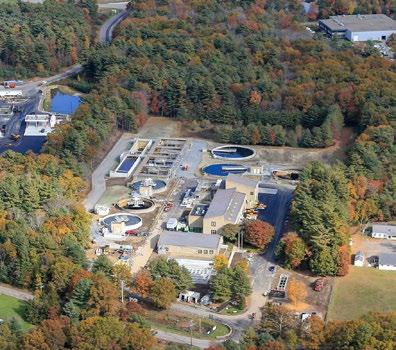
Photo 35. The MFN Wastewater Facility. MFN Wastewater District.
Strategy 6.1-3
Increase awareness of local evacuation routes, emergency shelters, and Town resources.
Performance Measures
Priority: High
Year 1: Identify critical evacuation routes and ensure that current list is compatible with projected sea level rise and development patterns. The Town can explore the MVP 2.0 Grant Program for potential funding options to update prioritization from the Town’s 2018 Plan.
Year 2: Conduct community outreach to raise awareness about storm and hazard preparedness.
Year 3: Secure funds and implement signage along evacuation routes.
Complementary Goals and Strategies
6.1-1 Ensure vulnerable populations, including older adults/senior residents, have access to air conditioning during heat events.
7.2-2 Refine, update, and promote a monthly email / newsletter to provide updates on town initiatives, events, etc.
Responsible Party
Town Planner, Highway Department, Fire Department, Police Department, and Building Department
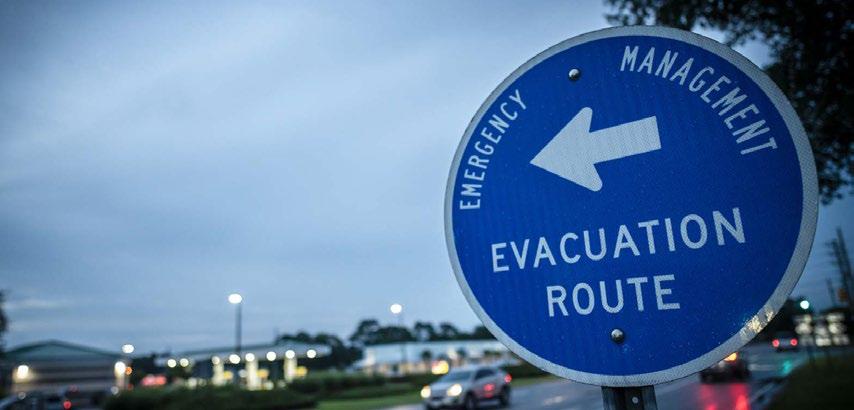
While increasingly critical in all communities throughout the Commonwealth, the issue of preparedness for storms takes on an increased significance in coastal communities such as Swansea. Often, folks in town do not know their local evacuation route or where their nearest community shelter is in the event of a severe storm or hazardous event. When surveyed, 69% of Swansea residents stated they would not know how to locate their suggested evacuation route and roughly 35% said they would not feel prepared to evacuate in these circumstances. During the 2018 Hazard Mitigation Plan (MVP), focus groups indicated that clearly marking the locations of evacuation routes via signage should serve as a high priority strategy for storm and hazard preparedness. The Town should further identify which routes it should mark, particularly to direct traffic safely inland from
the southern, coastal border. Following a consensus on these routes, the Town can secure funding for clear demarcation of priority routes, in the event of a major storm event.
In addition to evacuation routes, not all households have a plan or toolkit prepared in the event of an emergency. The Town can prepare a series of resources to assist families in emergency preparedness planning, including the production of an online resource page, adding roadside signage along evacuation routes, and distributing information via mailers, text messages, or social media posts. Additionally, Town administration could utilize other items from this Plan, such as the monthly newsletter to showcase and highlight critical evacuation routes and details.
Photo 36. An evacuation route road sign. Darwin Brandis.
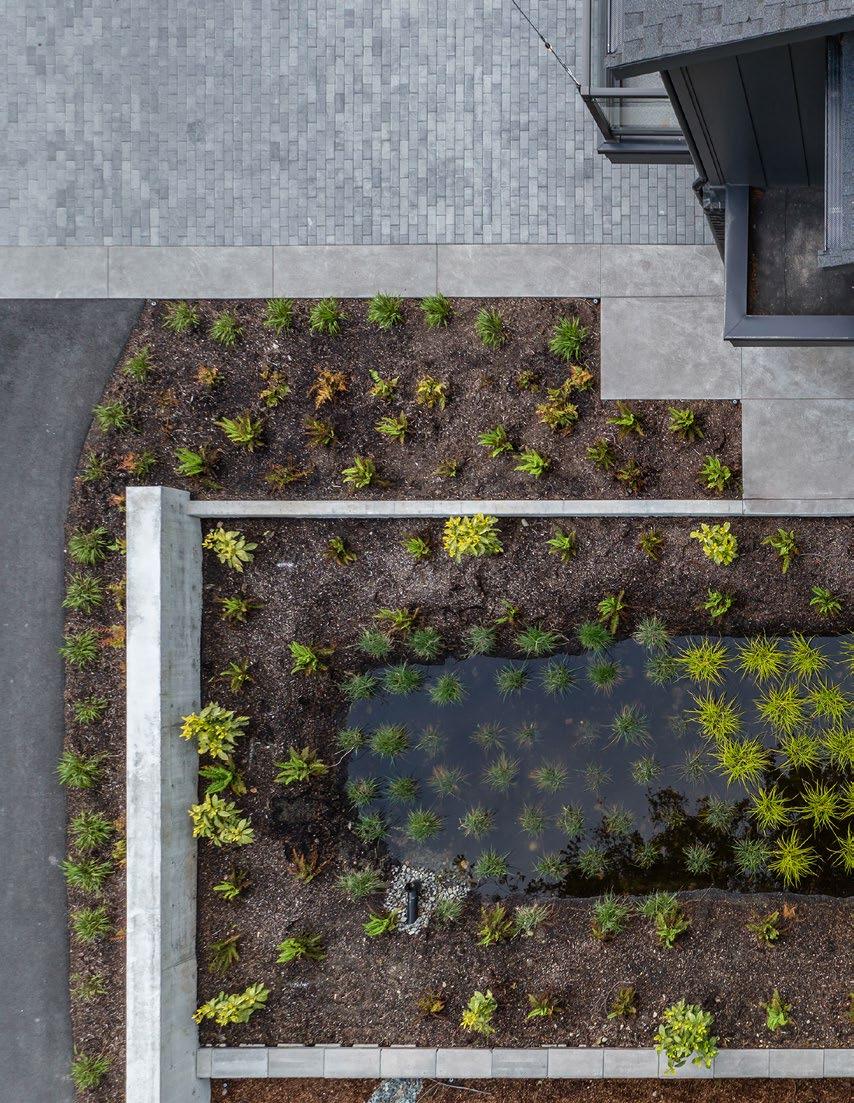
Goal 6.2 Increase coastal resilience through new programs and adaptation strategies.
This goal looks at climate resilience planning, holistically and long-term. While Goal 6.1 seeks to shore up Swansea’s emergency preparedness and the vulnerability to its resources and facilities, many of those factors should be addressed in the more immediate term. Goal 6.2 looks to establish responsive and forward-thinking mechanisms for Swansea to implement, ranging from new approaches to housing along the town’s coastal neighborhoods and ecosystems to creating a plan to address the climate action for all areas of town. These strategies will allow Swansea plan in a way that balances its future development while adapting to a changing ecological reality.

Photo 37. A rain garden next to a home in Normandy Park, WA. Studio Terrain/Terrain.
Strategy 6.2-1 Allow compact, climate-resilient adaptations, including raised houses and vertical additions.
Performance Measures
Priority: High
Year 1-2: Identify locations in town and sections of by-law that may need increase flexibility to respond to potential flooding.
Year 3-4: Pass necessary amendments to Zoning By-laws.
Year 5 and on: Administer financial and informational resources for those who may need to retrofit their property.
Complementary Goals and Strategies
Goal 6.1 Develop Town facilities and infrastructure to increase climate resilience.
6.2-2 Explore participation in FEMA’s Community Rating Service program to bolster flood mitigation town-wide while also reducing flood insurance premiums.
6.2-5 Produce a Town-wide Climate Action Plan.
Responsible Party
Planning Board, Conservation Commission, Conservation Agent, Building Inspector, and Town Planner
Owners of property in Swansea’s floodprone or FEMA designated zones may wish to incorporate flood proofing building mechanisms into their residence to preempt any potential damage from storms or flood events, or may need to consider retrofit or rehabilitation in the event of a serious flood event.
Swansea’s zoning and building codes, like many typical lower-density residentially based zoning codes, rely on dimensional standards, such as limitations on height from the existing finished grade, setbacks from the street for entryways to homes, requirements for the placement of mechanical systems, and so on. The Town may need to create paths to exception and/ or flexibility in the zoning code to allow lots which would otherwise be out of compliance with its by-law requirements as a response to the threat of flood damage in some key areas. Some examples of this flexible approach might include:
• Allow for an increase height threshold by considering building height from the finished floor elevation of the first floor, instead of finished grade, in homes that choose to freeboard by raising their first to flood elevations, or those that provide a flood-resistant garage or carport underneath the homes finished floor elevation.
• Allow for exceptions from regulations pertaining to setbacks for homes that need to creatively construct stairways, ramps, or other vertical features to allow access to raised homes.
• Allow for the position of mechanical, plumbing, heating, and cooling systems on the roof or at higher elevations in situations where a lower placement of these components may cause significant failure in the event of a flooding event.
• While these include just a few of the accommodations the Town may want to consider, creating room in the zoning and building codes that is compatible with the threat of flood events will require creative thinking and flexibility to ensure that the residents have sufficient opportunity to prepare for and respond to natural disasters.
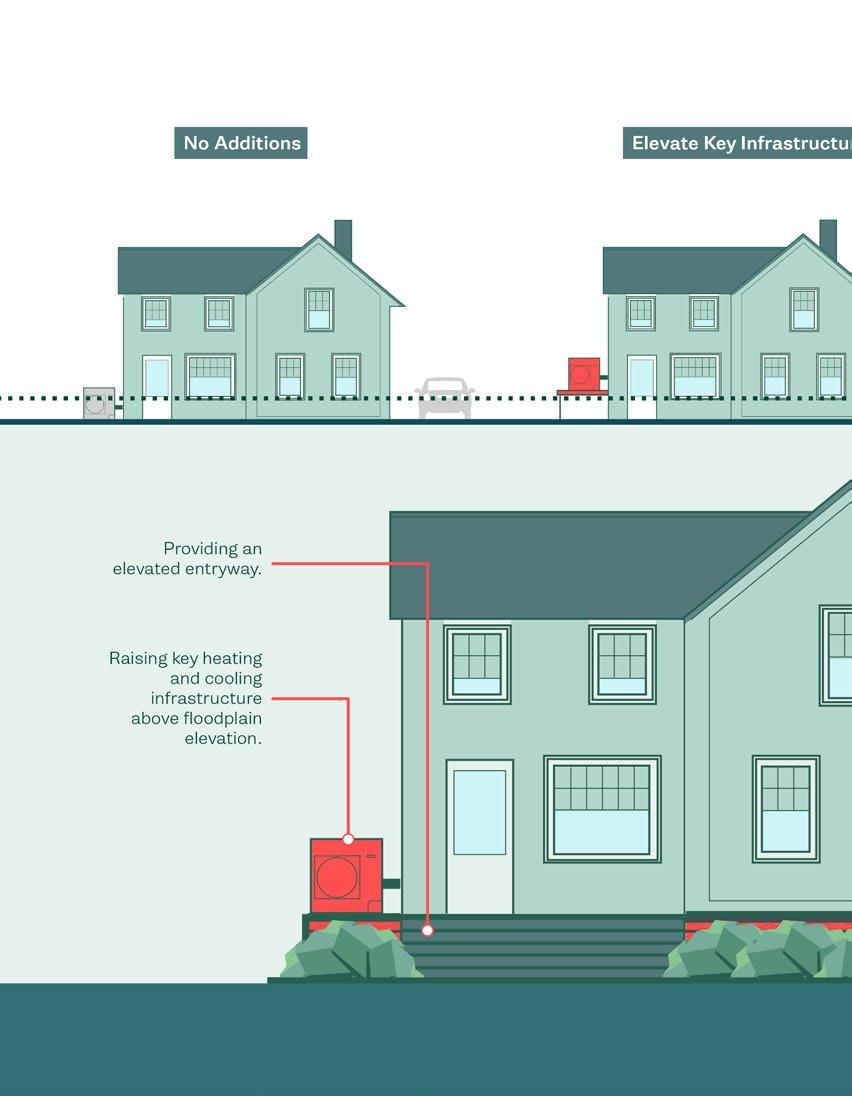
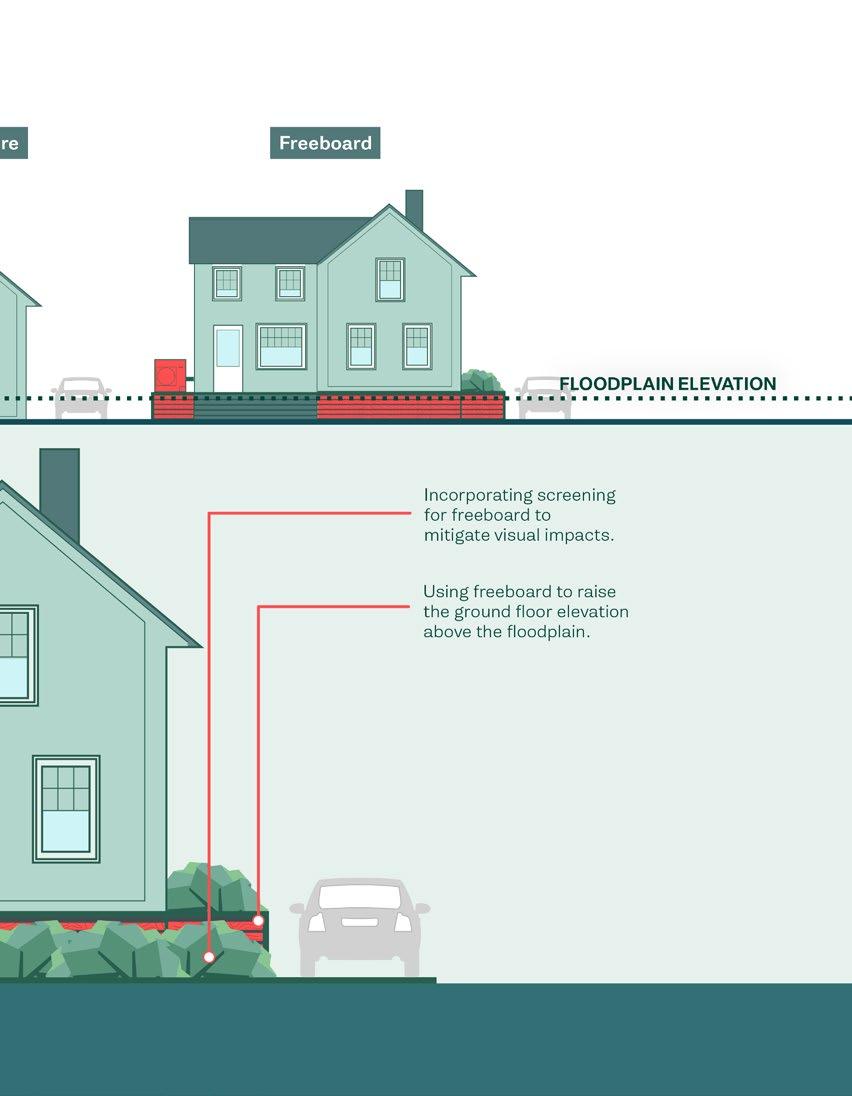
These diagrams show various climate-resilient architectural modifications for residential uses. The changes shown here focus on flood protection, though there are other types of modifications focused on resource conservation, storm-proofing, and renewable energy generation.
Strategy 6.2-2 Explore participation in FEMA’s Community Rating Service program to bolster flood mitigation town-wide while also reducing flood insurance premiums.
Performance Measures
Priority: Medium
Year 1: Evaluate if Swansea meets the criteria for reduction in insurance premium reduction through participation in the Community Rating Service Program.
Year 2: Apply for eligibility and pursue any practice areas to earn additional credits.
Year 3: Continue to pursue practice areas to increase insurance discount.
Complementary Goals and Strategies
Goal 6.1 Develop Town facilities and infrastructure to increase climate resilience.
6.2-1 Allow compact, climate-resilient adaptations, including raised houses and vertical additions.
6.2-3 Evaluate the severity of coastal erosion and improve coastal buffers.
6.2-5 Produce a Town-wide Climate Action Plan.
Responsible Party Planning Board, Conservation Commission, Conservation Agent, and Town Planner
The Community Rating System (CRS) is a voluntary incentive program that recognizes and encourages community floodplain management practices that exceed the minimum requirements of the National Flood Insurance Program (NFIP). Over 1,500 communities participate nationwide.
In CRS communities, flood insurance premium rates are discounted to reflect the reduced flood risk resulting from the community’s efforts that address the three goals of the program:
1. Reduce and avoid flood damage to insurable property.
2. Strengthen and support the insurance aspects of the National Flood Insurance Program.
3. Foster comprehensive floodplain management.
Over 20 communities across the Commonwealth participate in this program –proactively planning for flooding. By doing so, these communities receive flood insurance premium discounts. Discounts for CRS communities’ insurance premiums range from 5% to 45%, depending on their level of
participation in the program via credit points earned for various activities. Activities fall into one of four categories:
• Public Information
• Mapping and Regulations
• Flood Damage Reduction
• Warning and Response
Swansea can inquire about becoming eligible for the CRS program’s insurance benefits. To do so, the Town will need to apply with FEMA to confirm that they meet the prerequisites to become a Class Nine community. Beyond securing basic eligibility, Swansea should begin identifying areas where it is already participating in activities that provide credit towards premium reductions and identifying areas where it would like to conduct new activities that will earn insurance premium credit. Further, the Town should identify a coordinator to interface with CRS program representatives and track the Town’s creditworthy activities to ensure that Swansea residents are receiving the maximum insurance discount for their efforts. This strategy can work alongside Strategy 6.2-1 to ensure protection to some of Swansea’s most vulnerable properties.
Strategy 6.2-3 Evaluate the severity of coastal erosion and improve coastal buffers.
Performance Measures
Priority: Low
Year 1 and on: Continue to monitor the threat of coastal erosion and take proactive steps where necessary.
Complementary Goals and Strategies
OSRP Goal 1
OSRP Goal 2
OSRP Goal 3
6.2-2 Explore participation in FEMA’s Community Rating Service program to bolster flood mitigation town-wide while also reducing flood insurance premiums.
6.2-5 Produce a Town-wide Climate Action Plan.
Responsible Party Conservation Commission and Conservation Agent

Swansea’s Town beach, coastal shoreline, shell fishing sands, and coastal lands describe a range of buffer conditions that could be subject to erosion. While the Commonwealth has spent significant resources studying this phenomenon at the state-level, via its Coastal Commission, it is important for coastal locations to continue to evaluate the severity and impacts that coastal erosion may have on their community.
While the Swansea’s most recent MVP plan did not identify coastal erosion as a concern, the threat of erosion is contingent upon several ongoing environmental conditions, ranging from development in town to the current water level. Given this reality and the potential severity of the threat of coastal erosion, the Town should continue to monitor changes in the environment for any visible signs of alteration along the coast. If the town notices any potential concerns, it can update its planning document and take
steps to implement changes to alleviate the stresses that may cause the erosion of its coast.
In the meantime, if the town would like to be proactive about reducing the likelihood coastal erosion, there are several steps Swansea may take locally. Proactive initiatives range from implementing erosion control-focused living shorelines with rocks and vegetation at critical points along Swansea’s coast to taking steps towards reducing stormwater runoff from impermeable surfaces and exploring strategic retreat from the shoreline by reducing construction within 100 feet of the coast and limiting foot traffic along sensitive coastal areas. Ultimately, whichever approach the town chooses to pursue, it will be important to remain mindful of the suite of hazards to which coastal communities are susceptible, including coastal erosion.
Photo 38. A neighborhood off of Route 6 overlooking the Lee River. Town of Swansea.
Strategy 6.2-4 Create new passive recreation opportunities in tandem with green infrastructure preservation.
Performance Measures
Priority: Medium
Year 1: Build off the findings of the Comprehensive Plan and OSRP to identify lands with ecological and recreational value that have minimal risk of flooding.
Year 2: Explore funding opportunities to create new passive recreation opportunities.
Year 3: Secure funding for a high-priority passive recreation project.
Complementary Goals and Strategies
OSRP Goal 4
OSRP Goal 5
Responsible Party
Town Planner, Town Administrator, Parks and Recreation, and Conservation Commission
While many visitors to Swansea may be familiar with its coast via the Town Beach, residents will often highlight the entire coastal system, describing an ecosystem that includes the Cole’s River, Lee River, and the unnamed river that flows along Duck Pond. The complex and interdependent nature of the Town’s tidal system provides unique environmental conditions, while also imposing critical constraints to consider.
It is important to consider the impact that tides can have on the rising and falling of water levels along the town’s riverbanks. While these may limit the development that can occur along the riverfront, there exist ample opportunities to provide ecologically sensitive, passive recreation opportunities.
During public participation, participants identified a few improvements they’d like to see, with the most popular including:
• Designated fishing areas (69% of respondents would like to see)
• Kayak launches (69%)
• Overlook docks in tidal areas (67%)
• Natural play areas (57%)
In addition to providing ecologically sensitive access to the Town’s riverine systems, it will also be increasingly important for Swansea to control stormwater throughout town before it reaches critical natural systems. Participants, similarly, identified several improvements they would like to see the Town encourage related to the control of stormwater runoff.
The most popular included:
In Residential Areas:
• Rain gardens (77%)
• Barrels for Rain Storage ( 62%)
In Public Spaces:
• Roadside plantings to absorb water (72%)
• Seating areas with plantings (60%)
• Sidewalk paving to allow drainage (54%)
In Town-owned Spaces:
• Rain gardens (71%)
• Parking lot gardens to retain water (67%)
• Paving to allow drainage at building entries (58%)
While developing these two spaces may seem materially disconnected from one another, when thinking about the Town-wide context of preserving some of Swansea’s most precious natural resources, it will be important to intercept stormwater at an ‘upstream’ position – before this rainfall runs along roads, picking up chemicals and toxins, and bringing them to Swansea’s rivers. Similarly, at ‘downstream’ locations along riverbanks and the coast, it will be important to preserve the tidal ecosystems, by providing low-impact, passive recreation projects, and avoiding the introduction of ecologically altering developments in these areas.
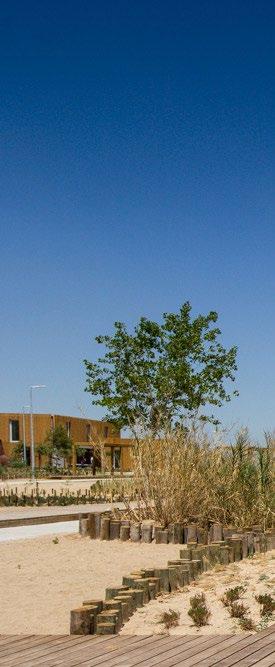
The Tagus Linear Park in Portugal, designed incorporating ecologically resilient vegetation and resilient infrastructure by providing an opportunity
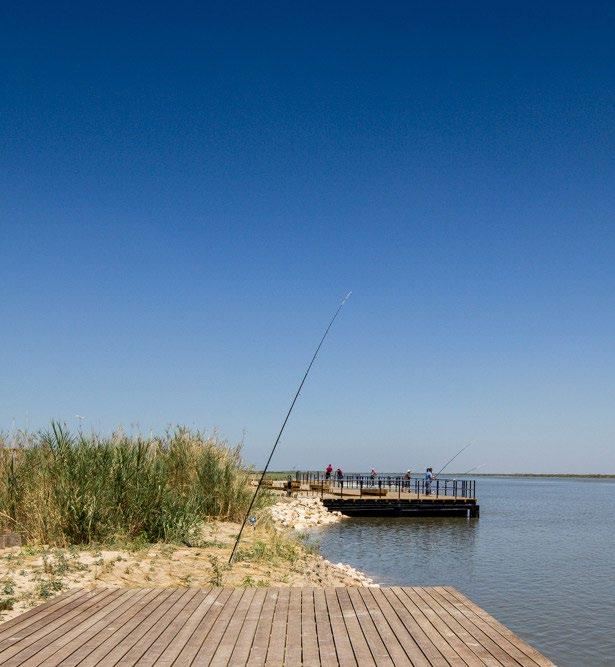
designed by Topiaris (a landscape architecture firm) emphasizes connections between 'beach' landscapes and natural areas, and providing a series of recreative spaces to activate the coast. In this photo, a fishing dock doubles as climate opportunity for recreation during dry times and allowing for intermittent flooding during storms.
Photo 39. Tagus Linear Park in Lisbon, Portugal. Landezine/Topiaris/Joao Morgado.
Strategy 6.2-5 Produce a Town-wide Climate Action Plan.
Performance Measures
Priority: High
Year 1: Pursue Coastal Zone Management (CZM) Plan funding or similar funding source, depending on the scope and limits of the Town’s climate action goals.
Year 2-3: Conduct planning analysis and public outreach.
Year 4 and on: Utilize plan to pursue funding for implementation projects.
Complementary Goals and Strategies
6.1-1 Ensure vulnerable populations, including older adults/senior residents, have access to air conditioning during heat events.
6.1-3 Increase awareness of local evacuation routes, emergency shelters, and Town resources.
Responsible Party
Planning Board, Town Planner, Conservation Agent, and Conservation Commission
Additional Reading
Massachussetts Coastal Resilience Grant Program
While it has become commonplace to see climate action plans at the State and regional level, or in major cities and metropolitan areas, smaller and more rural communities increasingly find themselves with the need to think proactively about climate adaptation strategies. Nearby towns, such as Marshfield, MA and North Kingstown, RI have produced local climate action plans that specifically address the needs and challenges in their communities.
Like these other towns, Swansea has an excellent opportunity to consider which climate action strategies it would like to pursue on a community-wide basis. These
adaptations can range from energy audits on town-owned facilities to coastal flood mitigation strategies. Although several aspects of this plan would be unique to Swansea, the Town can draw from the extensive work already produced at larger geographical scales, including the Massachusetts Clean Energy and Climate Plan for 2050 and the Southeastern Regional Resilience Plan. Additionally, the Commonwealth recently made funding available for town-wide climate adaptation plans via its Coastal Zone Management program, which the Town could use to pursue funding.
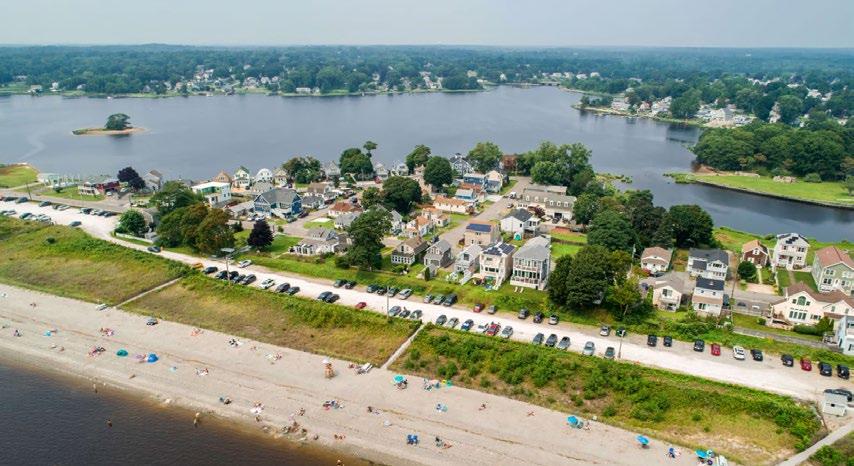
Photo 40. Swansea Town Beach and Ocean Grove. Town of Swansea.
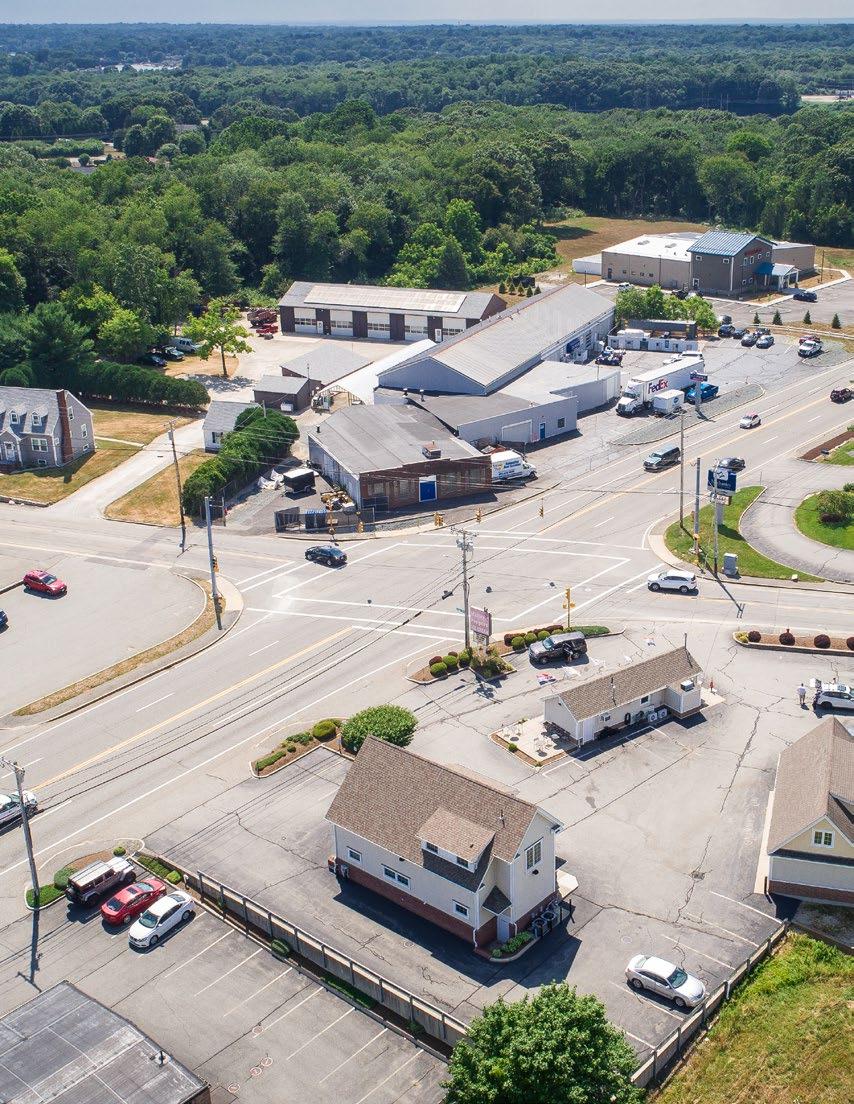
Element 7: Services & Facilities
Photo 41. Gardners Neck Rd and Route 6. Kevin Ham, SRPEDD.

In Summary: Services & Facilities
Town services and facilities are highly important components of any municipality and are what keep a community running year-round. Town services may include waste management, electricity distribution, and road maintenance; while municipal facilities may include the local public library, town hall, and police department. Swansea offers many highly regarded municipal services, including the local utility management, animal control, and education. The Town should focus on both improving access to and updating their municipal facilities to maintain their quality.

Goal 7.1 Improve town-wide accessibility and services.
A significant (and at times costly) aspect of improving Town-wide services and facilities is the implementation of capital improvements. These capital improvements can help centralize and unify town resources; make facilities more physically accessible while increasing their visual presence in town; and increase Town staff’s ability to provide critical functions for Swansea residents and visitors. Goal 7.1 explores the best strategies to leverage the Town’s resources to serve its population.
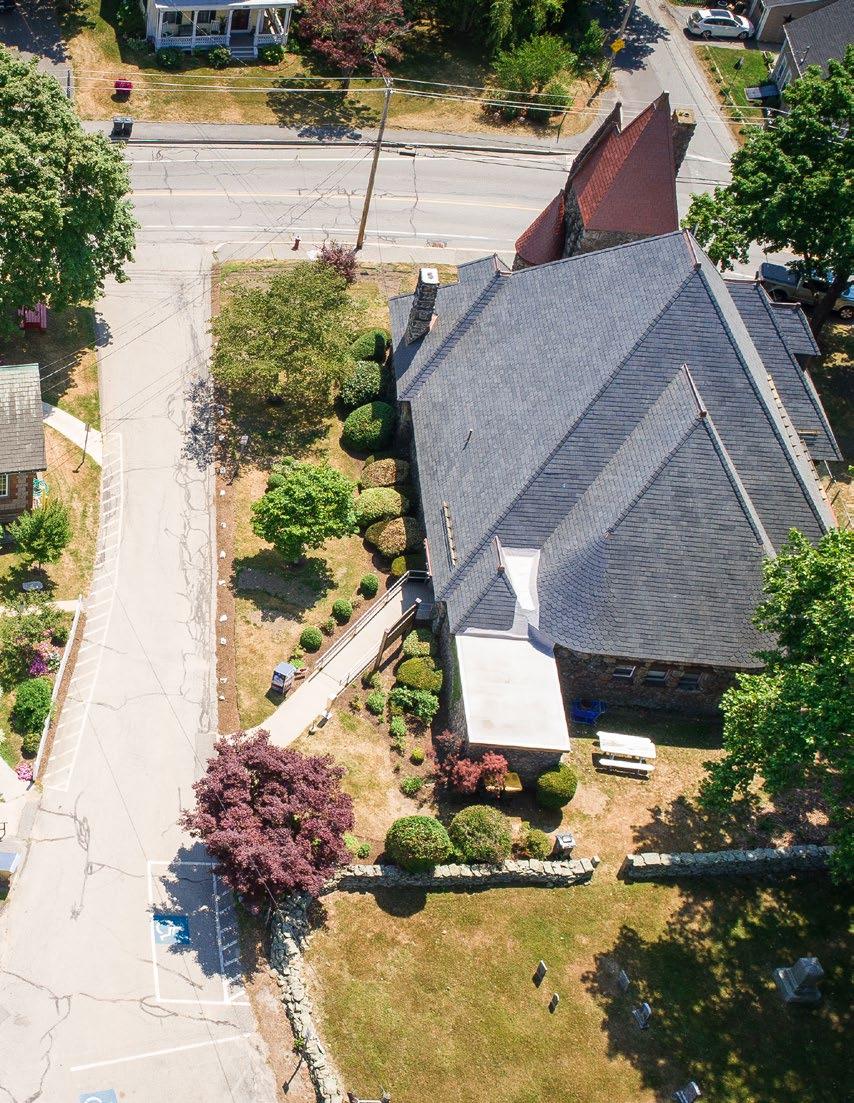
Photo 42. Parking Behind Town Hall and the Library. Kevin Ham, SRPEDD.
Strategy 7.1-1
Explore the feasibility of upgrading Town-owned properties such as the Council on Aging, and the Town Annex to enable use of its facilities.
Performance Measures
Priority: High
Year 1-2: Complete design and engineering studies. Hold public outreach about proposed design for Council on Aging and Town Hall construction.
Year 3: Hold Town vote on construction of Town facilities and secure additional funding when available.
Year 4 and on: Begin construction.
Complementary Goals and Strategies
7.1-3 Develop a non-profit to fundraise for causes that could benefit the Town, including but not limited to improvements for the Fire Station, Town Hall, or DPW Facility.
Responsible Party
Planning Board, Town Planner, Town Administrator, Building Department
Additional Reading
MA Executive Office of Elder Affairs
AARP Foundation Grants Program
Administration for Community Living Grants Overview
Swansea’s Council on Aging (COA) and Community Center is located at 260 Ocean Grove Avenue. While the location provides excellent access to those seniors who are living in the Ocean Grove neighborhood and in the southern portion of Swansea, the COA is less accessible to many in the north and west portions of town. Further, its vehicle fleet does sits uncovered, posing additional transportation challenges during inclement weather. Regarding the COA’s programming, staff highlighted challenges due to space constraints and structural issues with their current facility, as well as a need for accessible outdoor spaces.
The Town Annex, located at 68 Stevens Road, houses several Town departments. These include the Building Department, Board of Health, and a shared parcel with the Department of Animal Control. Town staff described a limitation on space for staff, an inability to hold meetings, and will need structural updates and significant asbestos removal.
The Town can pursue one of several grant opportunities through the Community Development Block Grant (CDBG) for improvements to its COA. The Town could further pursue programming and operations funding through the Executive Office of Elder Affairs supportive services grants; the Office’s community-based senior center grant; AARP grants; and other federal grants through the department of Health and Human Services or the Administration of Community Living. Strategy 7.1-3 provides a path to establish a non-profit to secure funding to provide Town facility improvements that could augment any funding secured to enhance the COA, the Town Annex, or any other facilities that may need renovations, additions, or alterations.
Strategy 7.1-2
Identify and implement appropriate modifications from the ADA SelfEvaluation & Transition Plan, with particular concern for seniors and individuals with disabilities at Town-owned facilities.
Performance Measures
Priority: Medium
Year 1: Review existing ADA Transition Plan for high priority and implementable projects at existing Town facilities.
Year 2-3: Secure funding for and implement high priority ADA projects at Town facilities.
Complementary Goals and Strategies
7.1-1 Explore the feasibility of upgrading Town-owned properties such as the Council on Aging, and the Town Annex to enable use of its facilities.
Responsible Party
Building Department, Planning Board, and Town Planner
Providing quality services and accessible facilities is critical towards the goal of achieving compliance with the Americans with Disabilities Act (ADA). Passed into federal law in 1990, a portion of this legislation requires that all municipalities in the country complete a self-evaluation and transition plan to assess programmatic and physical compliance with ADA standards. The Town of Swansea applied for funding and has completed a Self-Evaluation / Transition Plan through the Municipal Americans with Disabilities Act Grant with the Massachusetts Office on Disability (MOD). Following completion and submission of its plan, the Town should reapply to the MOD grant program to fund capital improvements identified in the Self-Evaluation and Transition Plan. It is important to note that all new buildings, such as the proposed Town Hall and COA projects should – and will – also comply with ADA construction standards.
Case Study: Town of Amherst ADA Transition Plan
In 2020, the Town of Amherst pursued and received funding to complete an update to its ADA Self-Evaluation & Transition Plan. Through the Plan, the Town was able to identify areas where they would need to make infrastructure upgrades. These improvements included topics such as building and construction, website accessibility, safe evacuations, and more.
While pursuing its ADA Self-Evaluation & Transition Plan update, the Town applied for and received over $44,000 in funding through the Commonwealth’s ADA Improvement Grant to improve architectural barriers to accessibility, including necessary improvements for multiple crosswalks in the downtown area. In service of this and other ADA-related goals, Amherst’s Disability Access Advisory Committee holds regular meetings and works with the Town Planner, who serves as a liaison, to manage these planning and implementation projects.
Strategy 7.1-3
Develop a non-profit to fundraise for causes that could benefit the Town, including but not limited to improvements for the Fire Station, Town Hall, or DPW Facility.
Performance Measures
Priority: Low
Year 1-2: Explore mechanisms, requirements, and legal framework for developing a non-profit for fundraising in Town.
Year 2-3: Pursue the filing for and development of non-profit.
Year 3 and on: Identify key areas for fundraising and begin accepting donations
Complementary Goals and Strategies
3.2-2 Explore public realm opportunities - such as public space improvements and plantings - to enhance Swansea's sense of place.
7.1-1 Explore the feasibility of upgrading Town-owned properties such as the Council on Aging, and the Town Annex to enable use of its facilities.
7.2-1 Increase the publicity and number of cultural and community events in town, including pop-ups, food trucks, seasonal lights, etc.
8.1-2 Expand Town-facilitated ride services for older adults and individuals with disabilities.
Responsible Party
Town Administrator and Select Board
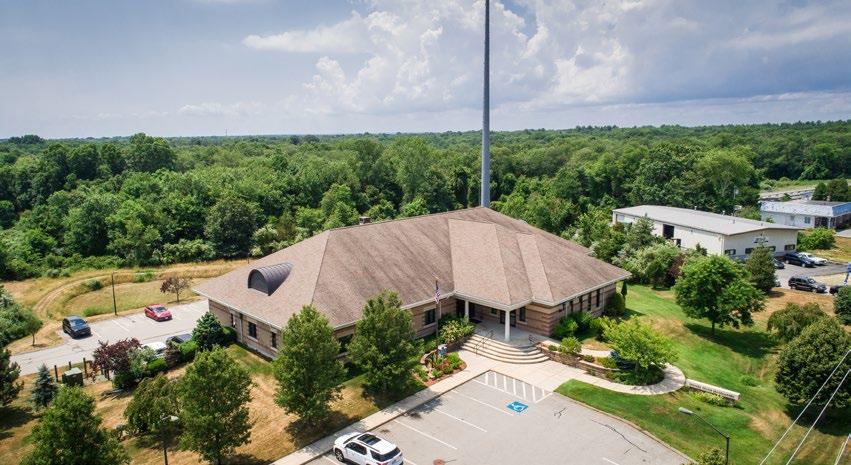
The Town of Swansea has a long history of philanthropy that contributes towards development, in service of the common good. The Town Hall and Library, two of Swansea’s iconic buildings, were donated over 130 years ago. Additionally, Joseph Case Jr. High and High School are named after their benefactor. Building from this tradition, Swansea could explore developing a non-profit that raises funds for civic improvements in town. During the Comprehensive Planning process, 61% of survey respondents supported this avenue for fundraising. During public workshops, folks identified areas they value and would support allocating funds, such as:
• Fire station improvements
• Facility improvements (DPW, Town Hall)
• Critical water facility land and assets
• Increasing capacity for open space management
Developing a non-profit to assist with fundraising could provide those in town with an outlet to contribute, financially, to some of the aspects they most enjoy about Swansea and, while working towards pursuit a collective goal for the benefit of the town.
Photo 43. Swansea Police Station. Kevin Ham, SRPEDD.
Strategy 7.1-4 Explore cemetery expansion.
Performance Measures
Priority: Low
Year 1-2: Identify capacity and need for cemetery expansion.
Year 3 and on: Secure parcels for expansion.
Complementary Goals and Strategies
OSRP Goal 4
7.1-3 Develop a non-profit to fundraise for causes that could benefit the Town, including but not limited to improvements for the Fire Station, Town Hall, or DPW Facility.
Responsible Party
Planning Board, Select Board, Zoning Board of Appeals, Town Planner, and Town Administrator

Communities across the globe are confronting the challenges associated with a limitation of cemetery space. Denser populations and limitations on available land exacerbate this challenge in more urban locations – and many areas in the State of Massachusetts have identified this concern for some time (Boston Globe).
Like its neighbors throughout the Commonwealth, Swansea is grappling with how to maintain adequate burial space while balancing its other demands for development, natural resource preservation, and its need for other forms of open and recreative space. The Town currently maintains two burial locations: Mount Hope (located on Milford Road), which does not have availability for future burials and Vinnicum Woods (located on Vinnicum Road), which has a limited and dwindling capacity.
In 2023, the Board of Selectmen identified cemetery space planning as a goal to address this issue.
To support this consideration, SRPEDD issued a survey question to better understand project cemetery usage in town, asking if current residents had a plan to utilize either of the two existing cemetery spaces. 17% of respondents indicated they would like to utilize the Town’s burial locations, with 48% indicating they would not, and 35% who were not sure how they would utilize the Town’s burial spaces. Given the amount of uncertainty many respondents expressed towards their utilization of cemetery space, it may be beneficial for the Town to study this issue in more detail to pinpoint the anticipated date where it the Town will need to acquire space.
Photo 44. A Cemetery in Swansea. Kevin Ham, SRPEDD.

Goal 7.2 Create new channels for local engagement and reinforce Swansea's community identity.
To take full advantage of the type of capacity Goal 7.1 seeks to expand, the Town staff will need to reach out to as many people as possible. Goal 7.2 explores strategies related to outreach and engagement that can ensure those in Swansea are up to date on all the ways the Town is working assist those who live, work, or spend time in Swansea.
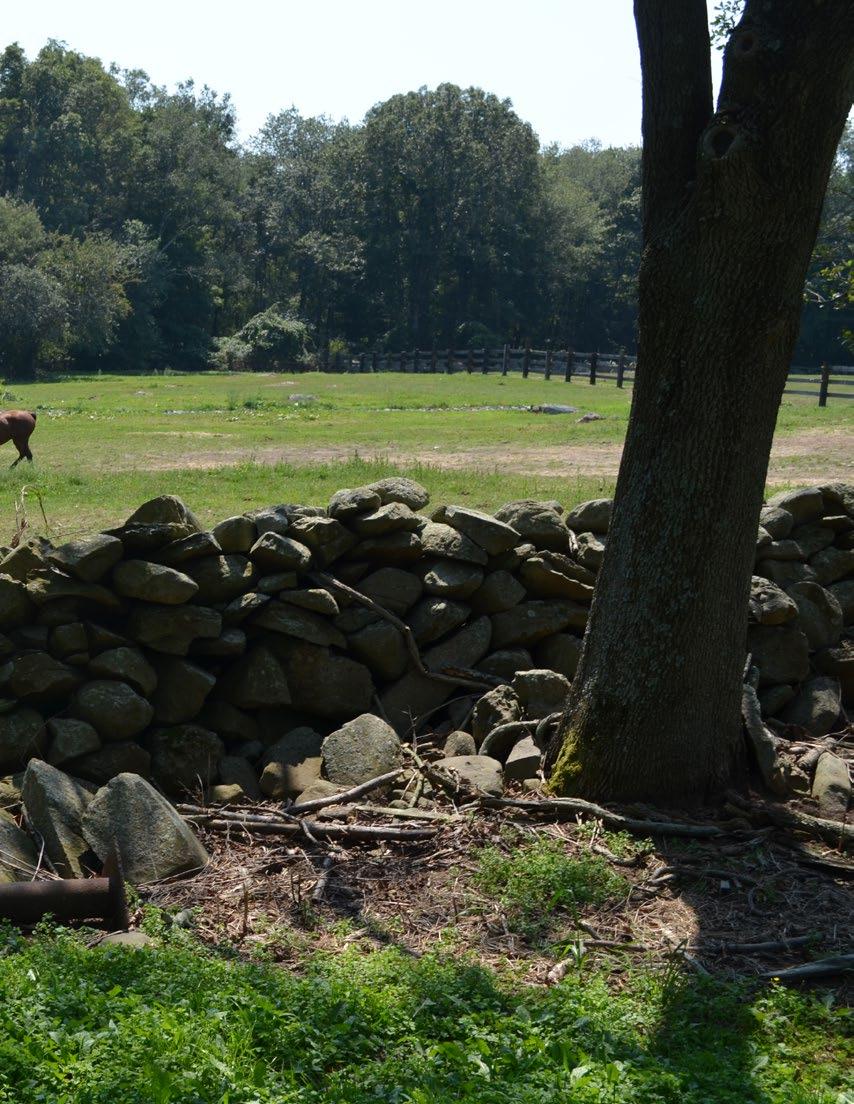
Photo 45. A Horse Farm in Rehoboth, MA. Massachusetts Office of Travel and Tourism.
Strategy 7.2-1
Increase the publicity and number of cultural and community events in town, including pop-ups, food trucks, seasonal lights, etc.
Performance Measures
Priority: Medium
Year 1: Identify potential program partners, preliminary schedule of dates for a small ‘Placemaking’ events program.
Year 2: Advertise and execute a pilot program for community events.
Year 3 and on: Expand program as necessary, implement permanent improvements to public spaces as appropriate.
Complementary Goals and Strategies
3.2-3 Create a formal organization for local small business owners.
3.3-3 Update and publicize Swansea's user-friendly Development and Permitting Guide to facilitate business development.
7.2-2 Refine, update, and promote a monthly email / newsletter to provide updates on town initiatives, events, etc.
Responsible Party
Planning Board, Town Planner, Police and Fire, and Town Administrator
Many of the strategies in this Comprehensive Plan address long-range, often infrastructure-intensive, and grantdependent goals and strategies that, while necessary for Swansea’s success, can require a lot of time and coordination. During the Comprehensive Planning process, the question of ‘what are some things we can achieve right away?’ arose frequently. Hosting community-centered events requires relatively little in the way of capital funding; the Town can achieve this primarily via partnerships with local businesses and organizations. While this type of more flexible
placemaking is a long-established strategy, many communities realized its achievability and potential benefits during the years of 2020-2022, when it was necessary to provide outdoor activities and dining options. Communities who developed placemaking programs, such as outside dining, often developed these types of initiatives into permanent aspects of day-to-day life.
Many participants in surveys and workshops expressed interest in seeing cultural and community events in town. In a public survey, respondents identified several activities

Photo 46. Washington, D.C.'s Downtown Holiday Market. City of Washington, D.C.
of which they would like to see more in Swansea. The most popular activities (those that 60% or more of respondents would like to see in town) included:
• Holiday Markets (80%)
• Recurring food truck events (69%)
• Town-wide vendor fairs (69%)
• Summer restaurant day or week (66%)
• Musical Performances (60%)
The Town could begin organizing an event series of this type by creating a program of current / planned community events in Swansea. Utilizing the data from the survey, a representative could contact local partners and businesses to see if they would like to participate, generating a list of low-cost capital purchases necessary to host events, and identifying host sites for events. Next the Town could create a schedule of events (i.e. food trucks every other Thursday evening between April and September), and advertise the dates.
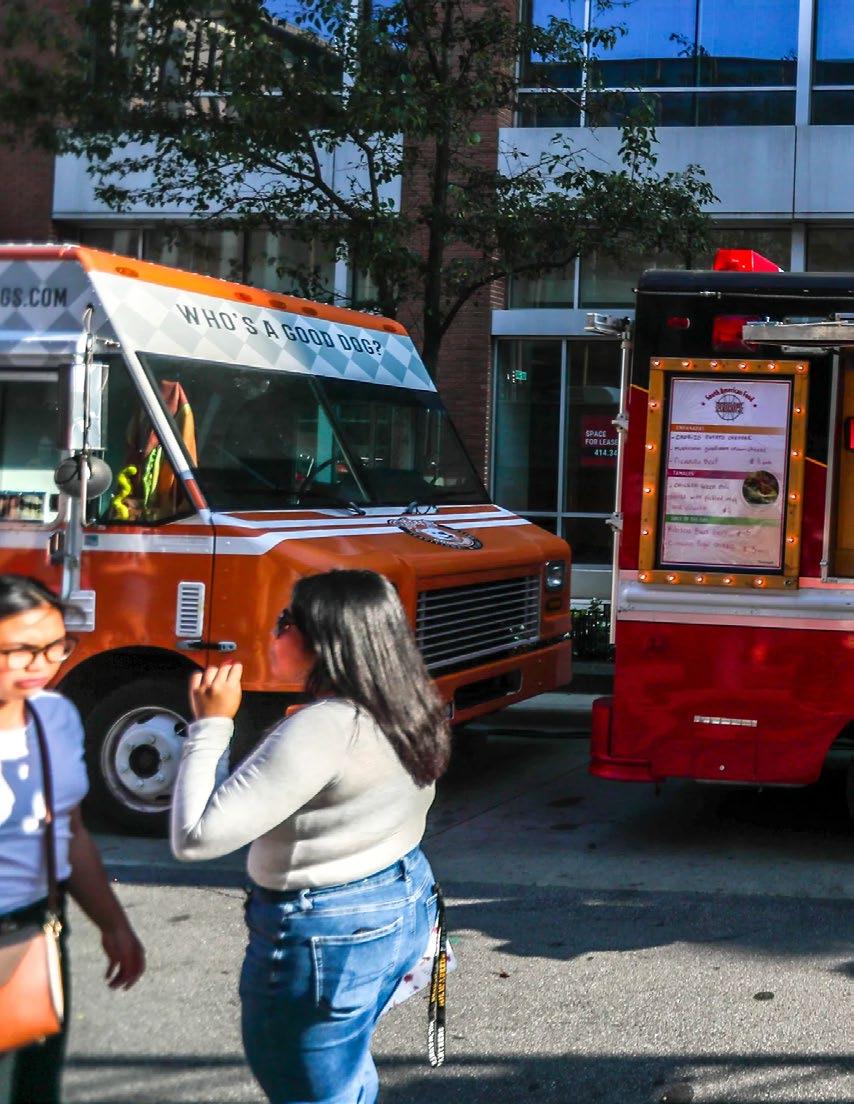
As the program gains popularity, it can help the Town identify which events and locations are the most popular. This can serve as an ‘incubator’ to understand latent demand for small businesses in the area. Additionally, if temporary solutions prove to be successful in public spaces throughout town, this can lead to more permanent interventions and help notify Swansea of the type of community spaces that would be successful (prior to making significant, more permanent capital investments).

Photo 47. A Food Truck Vendor in Milwaukee, Wisconsin. Ebony Cox, Milwaukee Journal Sentinel.
Strategy 7.2-2 Refine, update, and promote a monthly email / newsletter to provide updates on town initiatives, events, etc.
Performance Measures
Priority: High
Year 1: Finalize and release newsletter.
Year 2 and on: Continue to refine newsletter to ensure its success.
Complementary Goals and Strategies
6.1-1 Ensure vulnerable populations, including older adults/senior residents, have access to air conditioning during heat events.
6.1-3 Increase awareness of local evacuation routes, emergency shelters, and Town resources.
7.2-1 Increase the publicity and number of cultural and community events in town, including pop-ups, food trucks, seasonal lights, etc.
Responsible Party
Town Planner, Council on Aging, Library Directors, and Swansea Cable Access
Figure 12. Survey Results - "How can the town improve the delivery of services and information to you?"
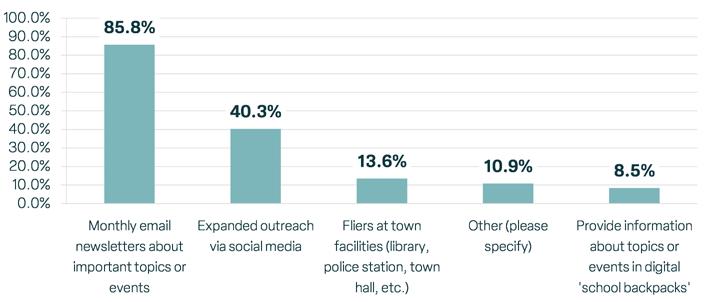
When asked how the Town could improve the delivery of services and information, 86% of respondents identified Monthly Email Newsletters as their preferred method to receive these communications from the Town.
As a result of this feedback the Town began work, during the Comprehensive Planning process, to craft a monthly newsletter that will outline local events; initiatives the Town is planning to undertake, such as regulation changes or planning implementations; and other Town business. As Swansea continues to issue this newsletter, it will be important to make sure it is providing valuable information to its readers. Ensuring this might include refinement to the content, identifying an appropriate frequency of production, or promoting the newsletter to make sure all of those who are interested are able to access the newsletter.
This newsletter can utilize the Town’s suite of digital tools, such as its website and social media presence to help contribute to help further disseminate important local information. Additionally, the Town could consider developing a cell phone application to enhance the exchange of information. Technology features should explore a conversant method of interaction that allows folks in town to both receive information about town meetings and initiatives and also to provide feedback and inform staff about issues such as potholes, damaged signs, downed or dangerous trees, and so on.
This newsletter will help provide a more direct method of interaction between the Town staff and those who are invested in what is going on in the Town of Swansea.
Strategy 7.2-3 Create a Digital Equity Plan and explore funding resources to ensure internet access and digital literacy for key populations.
Performance Measures
Priority: High
Year 1: Apply for grant and begin action plan.
Year 2: Complete MBI Action Plan and pursue funding for implementation.
Year 3-6: Implement highest priority broadband projects.
Complementary Goals and Strategies
1.1-4 Implement key zoning amendments to create new housing opportunities for first time homebuyers, older adults wishing to downsize, and those with moderate or fixed incomes.
2.2-2 Pursue partnerships and funding resources to provide direct assistance to help preserve housing for vulnerable communities, including senior residents.
7.1-1 Explore the feasibility of upgrading Town-owned properties such as the Council on Aging, and the Town Annex to enable use of its facilities.
Responsible Party
Planning Board, Town Planner, and Swansea Cable Access
While access to the internet may seem ubiquitous, for many of Southeastern Massachusetts’ more vulnerable populations, this is not always the case. Many vulnerable populations, including Swansea’s seniors need both affordable access to the internet, as well as training. Additionally, there are areas where it will be critical, as they see growth and change, that digital equity serve as a core component. These areas include Route 6, where the Town is likely to see the inclusion of sewer infrastructure and any necessary broadband utility work should be coordinated with these upgrades. Additionally, Route 103 and the Ocean Grove neighborhood at large, serves an area of need for broadband equity, particularly due to the Council on Aging, which is in this area.
The Town has already begun planning, alongside SRPEDD, with the creation of a digital equity plan through the Massachusetts Broadband Institute’s (MBI) Municipal Digital
Equity Planning Program. This program allows communities across the state to complete Municipal Digital Equity Plans at no local cost. These plans analyze the current state of internet use, access, services, and supporting programs in a community. Based on its findings the plan, identifies activities and projects to expand and improve broadband service in a community, while improving community members’ ability to participate in online activities.
Completing a plan will prepare communities to implement digital equity initiatives with future funding that will become available. In addition to the digital equity plan, the AARP provides grants to assist with Digital Equity connections. While it is an often-overlooked component of infrastructure planning and community outreach, digital equity plays a critical role in providing access to key services in any town.
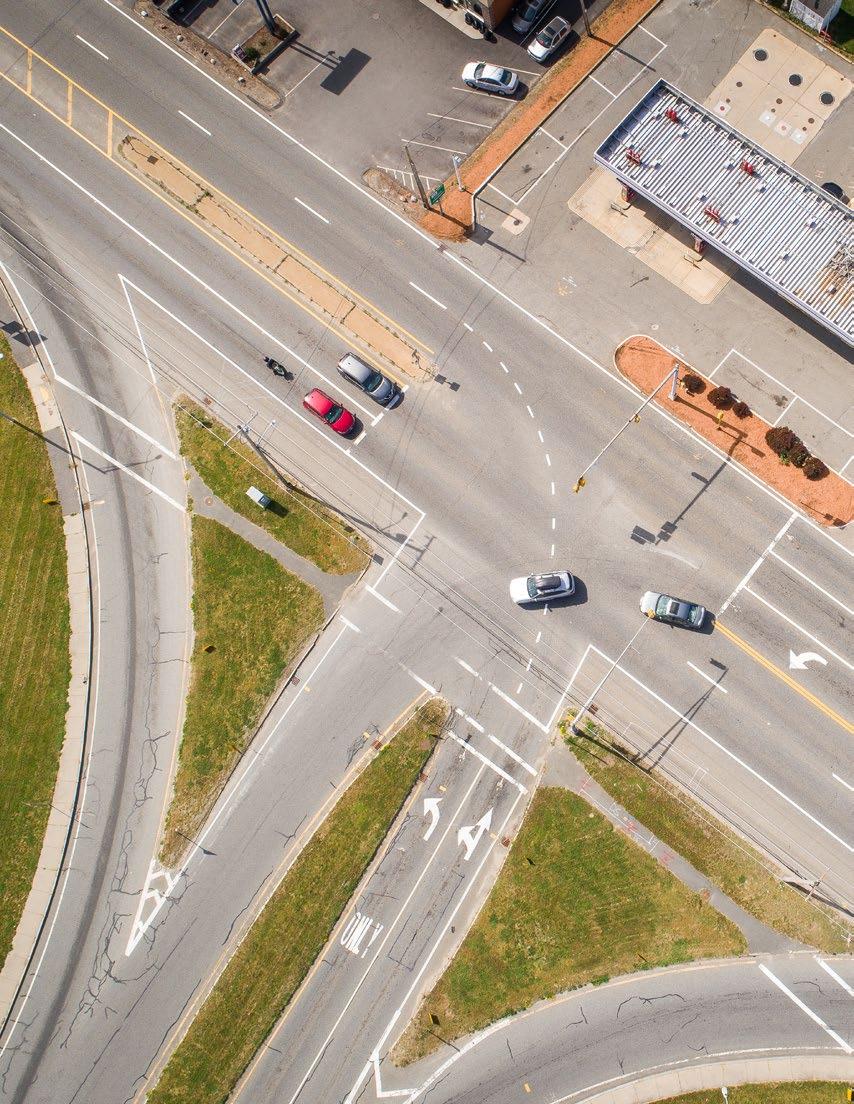
Element 8: Transportation & Circulation
Photo 48. The Intersection of Route 118 and Route 6. Kevin Ham, SRPEDD.

In Summary: Transportation & Circulation
Most residents and visitors in Swansea travel by car. However, during the Comprehensive Planning process, participants identified the potential for roads in town to do much more. Community feedback not only acknowledged the opportunity to incorporate non-motorized transportation in Swansea, but highlighted the potential for the town’s street network to provide recreative opportunities, catalyze economic development, and enhance quality of life.
The goals and strategies in this chapter will seek to capture this feedback. Some of these strategies include straightforward solutions, such as enhancing the Town’s most dangerous intersections along Routes 6 and 118, while creating systems to ensure the Town can identify and address dangerous intersections. Other strategies focus on increasing accessibility by providing nonmotorized transportation options and bus access. A handful of strategies build from the foundation these first two provide to highlight transformative opportunities that streets like Route 103 could provide.
Ultimately, the goals and strategies in this chapter provide a list of concepts that can work together to help create a system of transportation that supports a walkability and accessibility for commuters; ensures safe, efficient travel; and supports the livability and economy of Swansea.
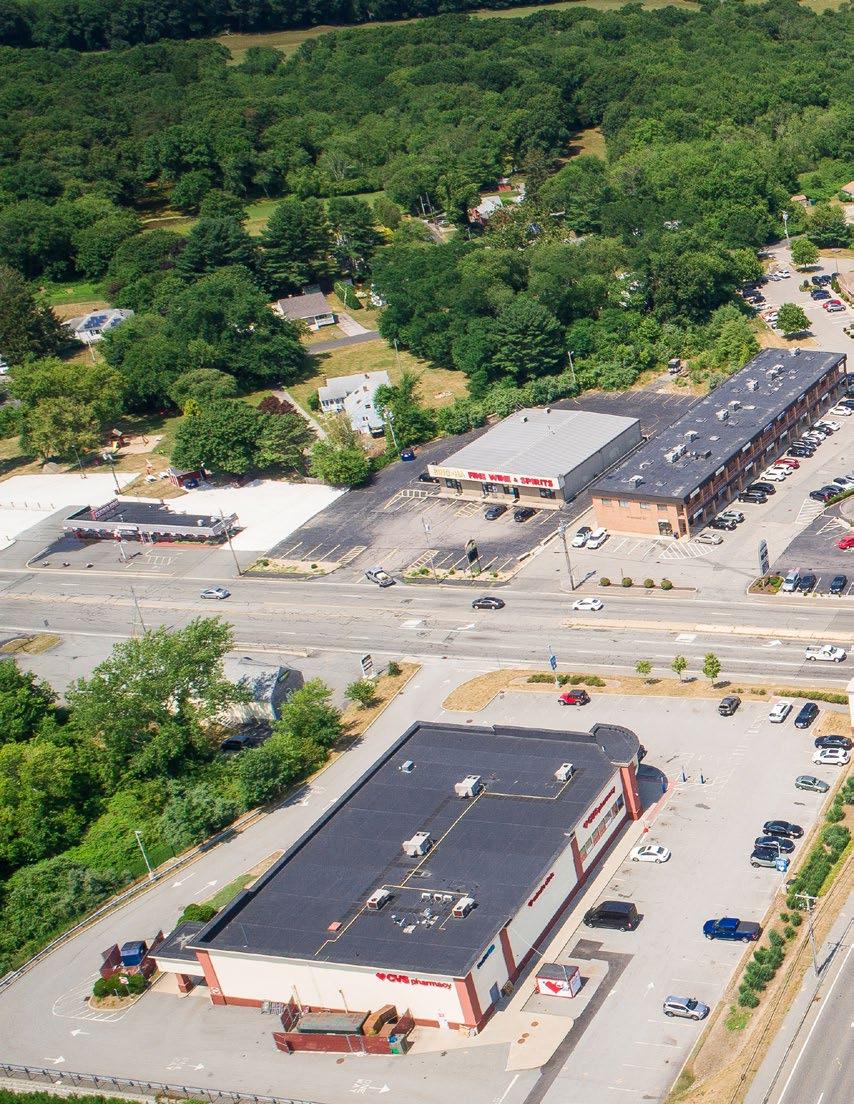
Goal 8.1 Improve pedestrian access and safety.
Swansea is home to 4 (Route 6 + 136, Route 6 + 118, Route 6 + Maple Avenue, and Route 6 + Gardner’s Neck Road) of Southeastern Massachusetts’ 100 most dangerous intersections, including the region’s most dangerous intersection (Route 6 + 136). While some of these locations already have sidewalks and safety improvements or are undergoing significant safety upgrades; it is important for Swansea to continue to prioritize these advancements throughout Town.
Swansea has several active plans for the next phase of transportation improvements, including its Complete Streets Plan, studies for Route 6 and Route 118, and several smaller traffic improvement plans. These plans work in concert to create a safe transportation network that provides options for those who wish to walk, bike, and drive throughout town. These Transportation & Circulation strategies build on Swansea’s existing plans and recommend next steps to implement recommendations to create safer and more accessible streets in all areas throughout town.
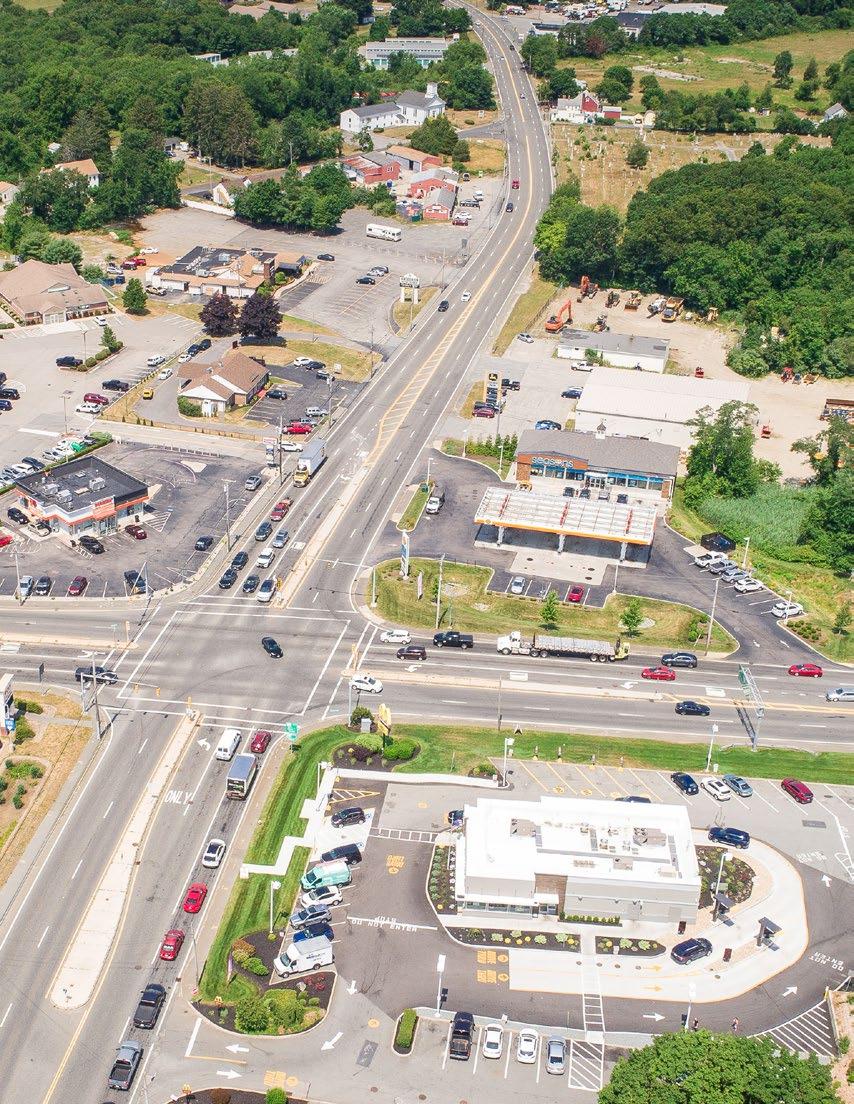
Photo 49. The Intersection of Route 6 and Route 136. Kevin Ham, SRPEDD.
Strategy 8.1-1 Expand SRTA access throughout town and install new supportive infrastructure, including signage and bus shelters.
Performance Measures
Priority: High
Year 1-2: Communicate with SRTA about Town needs; address areas of need for access; and inventory potential high use locations for bus shelters and other infrastructure/amenities.
Year 2-3: Pursue funding, alongside SRTA and SRPEDD for infrastructure improvements (utilizing current State transportation improvements, grants via SRTA, and sources such as CDBG).
Year 4 and on: Implement route and infrastructure upgrades.
Complementary Goals and Strategies
Goal 3.1 Explore new development opportunities along Route 6.
8.1-2 Expand Town-facilitated ride services for older adults and individuals with disabilities.
8.2-1 Pursue electric and hybrid options for town vehicle fleets and install additional electric vehicle charging stations along high-traffic routes.
8.3-2 Implement findings from Route 118 and Route 6 Studies.
Responsible Party
Town Planner, Town Administrator, and Highway Department/Public Works
When asked about getting around town, 100% of survey participants identified car as their primary means of transportation, while 0% of these respondents regularly utilize any bus system. The Southeastern Regional Transit Authority (SRTA) maintains a route (14) on its Fall River Line which runs from the Route 118 / Swansea Mall site, along Route 6, then through Somerset and Fall River, where it connects to the Fall River / New Bedford Intercity connection.
With a limited access network to Swansea, it is difficult for many in town to utilize the SRTA system. Additionally, without significant bus infrastructure, such as signage, shelters, and markings along the route, it may be difficult for those in town, who may otherwise ride the SRTA, to know how and when to use this resource, or feel comfortable enough to take the bus regularly.
With significant potential change along Route 6 for a mix of uses that could generate significant capacity for public transportation
(Goal 3.1), there is a great opportunity to synchronize future SRTA routes with major access points. This should take the form of an expansion of service further into Swansea via its existing Route 6 connection. In support of this, the Town should consider the development of bus infrastructure along Routes 6 and 118 to make the SRTA more visually noticeable and to provide shelter for those who utilize SRTA. Additionally, it will be important to provide transportation access for older adults and individuals with disabilities. SRTA can achieve this by coordinating with Swansea’s current Townfacilitated ride services to ensure that expansion of both these offerings provides maximum access for those who rely on public transportation (8.1-2). While these present a lot of considerations for a transit agency, they also define significant opportunities to expand the bus system’s service to those in need.
Strategy 8.1-2 Expand Town-facilitated ride services for older adults and
individuals with disabilities.
Performance Measures
Priority: High
Year 1-2: Conduct a study to understand the need for Town-facilitated ride services, as well as gaps in SRTA’s service that the Town can pick up. Coordinate ride assistance with proposals for potential future COA location.
Year 2-3: Pursue funding sources to provide resources towards expanding Town-facilitated ride services.
Year 3-4: Implementation of service expansion.
Complementary Goals and Strategies
Goal 2.2 Produce housing options for older adults to support aging in place and for adults with disabilities and/or chronic illnesses.
8.1-1 Expand SRTA access throughout town and install new supportive infrastructure, including signage and bus shelters.
Responsible Party
Town Planner, Town Administrator, and Council on Aging
Additional Reading
MassDOT Community Transit Grant Program
MassDOT MArtap Helping Hand Mini Grant
The Town currently offers free transportation to seniors and those with disabilities for a range of services, such as medical appointments and grocery shopping. The current service requires an appointment with 24 hours of advanced notice. As Swansea’s population (alongside the rest of the Commonwealth’s) continues to age, and the Town explores the relocation of its Council on Aging, it will be important to revisit these transportation services.
Some steps the Town could take to better understand future need for ride services include:
• Conducting a study to understand the demand for Town-facilitated ride services.
• Coordinating these services with SRTA’s current or future services (8.1-1)
• Exploring potential dedicated routes in alignment with current or future highvolume sites in town.
Integration of these ride services could go a long way to provide the necessary infrastructure for those in Swansea who wish to age in place – this integration should occur alongside the town’s overall growth and development. To support this initiative, the Town could consider several grant programs, including the Community Transit Grant Program and the Helping Hand mini grants to assist with transportation and senior services.
Strategy 8.1-3 Establish a Traffic Safety
Committee to receive traffic feedback from residents, identify safety issues in town, and suggest improvements.
Performance Measures
Priority: Medium
Year 1: Solicit interest for participating in a Traffic Safety Committee.
Year 2: Create a by-law establishing rules, purpose, and organizational principles for Traffic Safety Committee.
Complementary Goals and Strategies
8.1-4 Work with MassDOT to conduct Road Safety Audits (RSAs) on stateowned roadways and intersections with a high number of crashes and safety concerns; implement items previously identified through RSAs.
8.1-5 Continue to construct high priority “Complete Streets” improvements in Partnership with MassDOT.
Responsible Party
Town Planner, Highway Department/Public Works, Planning Board, and Select Board
In addition to Swansea’s most dangerous intersections (Route 6 + 136, Route 6 + 118, Route 6 + Maple Avenue, and Route 6 + Gardner’s Neck Road, several of which are already benefiting from traffic and safety improvements), participants in the Comprehensive Plan’s feedback process identified several additional locations that feel dangerous due to speeding, confusing signage, unsuccessful traffic signals, difficulty turning, or crashes / close calls. The most cited dangerous-feeling streets include:
• Route 103 and Gardner’s Neck Road (63% of responses),
• Route 103 or Route 6 in general (22% and 30% respectively)
• Bark Street and Marvel Street (12%),
• Sharps Lot Road and Baker Road (10%),
• Route 118 and Wood Street (frequent write-in).
The Town should consider organizing a Traffic Safety Committee to help prioritize how to best continue addressing this issue, particularly as it completes safety improvements for its most crash-heavy intersections and begins to address traffic safety in a more preventative context. The goal of a Traffic Safety Committee is to track suggestions, synthesize feedback, and make recommendations to Town officials about improvements. It can do so through alterations to the Complete Streets program; suggesting traffic safety and improvement studies for key locations; or by prioritizing design, engineering, and construction services for particular thoroughfares.
Strategy 8.1-4 Work with MassDOT to conduct Road Safety Audits (RSAs) on state-owned roadways and intersections with a high number of crashes and safety concerns; implement items previously identified through RSAs.
Performance Measures
Priority: High
Year 1: Utilize feedback from Comprehensive Plan and SRPEDD crash data to establish list of Communities for Road Safety Audits.
Year 2 and on: Coordinate with MassDOT to conduct Road Safety Audits.
Complementary Goals and Strategies
Goal 3.1 Explore new development opportunities along Route 6.
8.1-3 Establish a Traffic Safety Committee to receive traffic feedback from residents, identify safety issues in town, and suggest improvements.
8.1-5 Continue to construct high priority “Complete Streets” improvements in Partnership with MassDOT.
Goal 8.3 Develop key routes to support economic development and improve quality of life.
Responsible Party
Town Planner, Highway Department/Public Works, and Planning Board
Swansea is home to some of the Commonwealth’s most dangerous intersections. The Town has been extremely proactive in working, alongside MassDOT, to ameliorate the pressure in its highestcrash locations along Routes 6, 103, and 118. While most of the intersections highlighted in the 2017-2019 data identify roads that are already undergoing safety improvements, current and forthcoming datasets alongside public feedback identified in Strategy 8.13 will be very helpful in identifying future locations for roadway improvements. Given the Town of Swansea’s ongoing work towards addressing the Town’s high-crash locations, Road Safety Audits will provide a useful mechanism to monitor the impact of these improvements while identifying locations in town that are still high-risk locations for crashes.
The Town should consider developing a list to conduct Road Safety Audits/Assessments (through a SRPEDD request or through a hired consultant) to identify safety issues and opportunities for safety improvements. The Town could then use this list to suggest improvements that would be funded through the Transportation Improvement Program (TIP), where 80% of funding comes from the Federal Highway Administration (FHWA) and 20% from MassDOT.
Case Study: Town of Weston Road Safety Audit
In 2020, the Town of Weston hired Toole Design to conduct a road safety audit for the intersection of Route 20 and Love Lane. Travelers on the road experienced frequent crashes, typically during rush hour. While conducting the audit, the Team identified potential safety enhancements relating to:
• Intersection Geometry;
• Pavement Markings and Signage;
• Intersection Control;
• Lighting;
• Pedestrian and Bicycle;
• Accommodations; and
• Access Control.
The Team then proposed solutions by timeframe, cost, and safety payout –including identifying which jurisdiction would also be responsible for the implementation of any solutions. These included:
• Exploring signalization;
• Conversion to a roundabout; and
• Geometry improvements for sight lines.
Strategy 8.1-5 Continue to construct high priority “Complete Streets” improvements in Partnership with MassDOT.
Performance Measures
Priority: High
Year 1-3: Continue to implement highest priority projects that are currently identified in the complete streets plan.
Year 4 and on: Regularly work with Town staff to the public to update the plan by identifying future projects that enhance safety and provide a variety of transportation methods.
Complementary Goals and Strategies
8.1-3 Establish a Traffic Safety Committee to receive traffic feedback from residents, identify safety issues in town, and suggest improvements.
8.1-4 Work with MassDOT to conduct Road Safety Audits (RSAs) on stateowned roadways and intersections with a high number of crashes and safety concerns; implement items previously identified through RSAs.
8.2-2 Consider adjustments to the South Coast Bikeway to route through Ocean Grove.
Goal 8.3 Develop key routes to support economic development and improve quality of life.
Responsible Party
Town Planner, Town Administrator, Parks and Recreation, Highway Department/Public Works, and Planning Boa
In 2021, Swansea (working alongside Fuss & O’Neill and SRPEDD) began the process to create an inventory of Swansea’s streets and created a prioritization plan to upgrade bike and pedestrian facilities throughout the Town, completing a Prioritization Plan in 2022. The Complete Streets plan prioritized potential projects, based on livability and sustainability, connectivity, safety, trip generators, traffic volume, and project readiness. High priority streets include those close with a significant crash rate along Routes 6, 118, Gardner’s Neck Road, and Route 103. The plan also prioritizes locations along Steven’s Road, Bark Street, surrounding schools, and along major routes connecting different parts of town.
The Town completed Tiers 1 and 2 have, and recently began improvements on some high-priority sites in 2023, most recently
conducting public workshops for the future of Swansea Mall Drive, in collaboration with Fuss & O’Neill. As Swansea completes projects included in the Complete Streets Prioritization Plan, it is beneficial to evaluate whether priorities have shifted in the time that has passed since writing the original document. For example, most of the prioritized projects exist along the Center of Town and in Ocean Grove – as other areas in Swansea experience growth, or if the Town identifies important and desirable connections to open and natural spaces (see strategy 8.2-3), it is possible, with proactive planning, to appropriately update the Prioritization Plan.
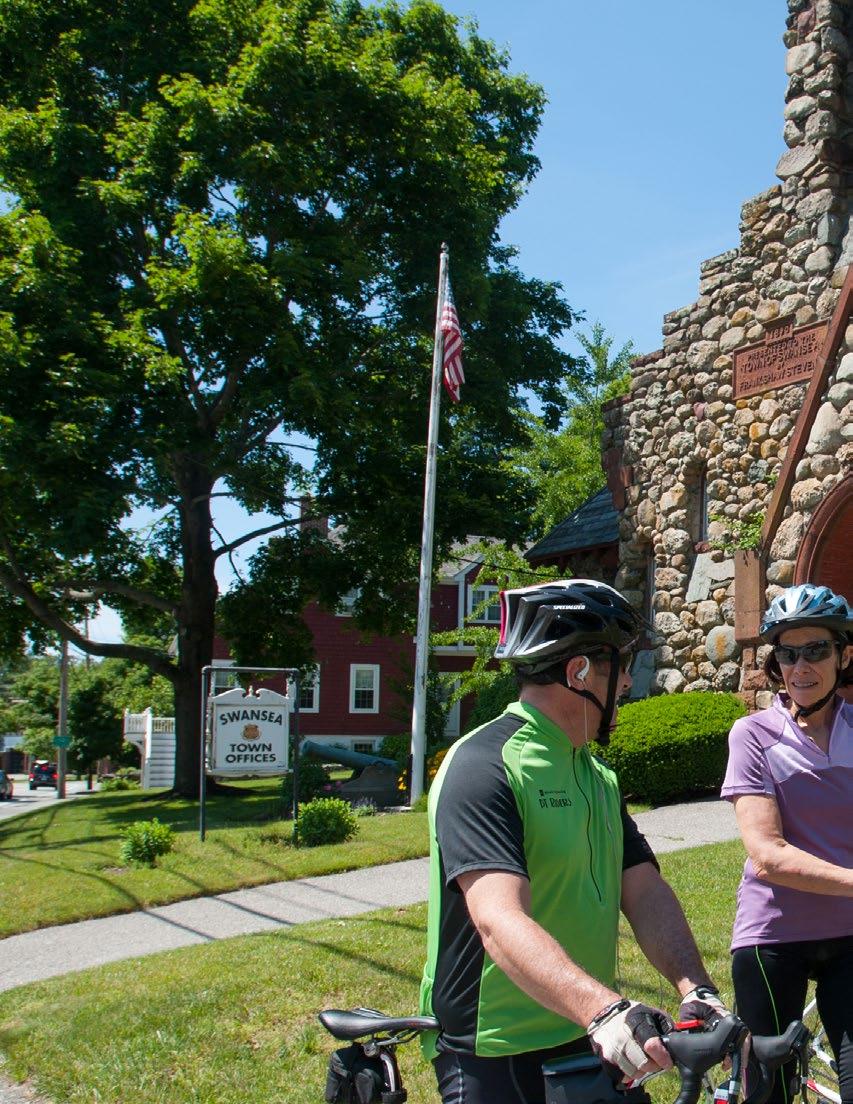
Goal 8.2 Explore new transportation opportunities throughout town.
This goal builds from Goal 8.1’s recommendations to improve safety and accessibility throughout town. While the previous goal focused on improving the more fundamental elements of transportation, our day-to-day interactions with transportation network include more than moving from place to place safely and efficiently. Goal 8.2 addresses the ways we can utilize our transportation infrastructure to integrate, protect, and explore new transportation opportunities related to Swansea’s abundant natural resources.

Photo 50. Bikers outside of Swansea Town Hall. Massachusetts Office of Travel and Tourism.
Strategy 8.2-1 Pursue electric and hybrid options for town vehicle fleets and install additional electric vehicle charging stations along hightraffic routes.
Performance Measures
Priority: Low
Year 1: Pursue grant opportunities to expand EV fleet and provide EV charging in Town.
Year 2-4: Enable pilot program to explore electrifying portion of the Town’s vehicle fleet.
Year 5 and on: Continue to convert Town vehicle fleet to electric, while providing EV charging throughout Swansea.
Complementary Goals and Strategies
3.3-2 Promote the PACE Program to allow for clean energy improvements on commercial properties to be privately financed and paid back through betterments on the town's tax bills.
7.1-3 Develop a non-profit to fundraise for causes that could benefit the Town, including but not limited to improvements for the Fire Station, Town Hall, or DPW Facility.
Responsible Party
Town Administrator, Town Planner, Highway Department/Public Works, Building Commissioner, Planning Board, and Select Board
Many communities are currently converting significant portions of their Town-owned vehicle fleets to hybrid or electric as older vehicles age out of use. From Green Communities to the Massachusetts EVIP program, communities across the Commonwealth have been successful in leveraging funding to expedite this transition. Building from the Town’s recent and successful implementation of electric vehicle charging stations (EV) at the Hoyle School, Joseph Case, and several locations along Route 6, Swansea should pursue further investment in electric vehicle technology through energy efficient Town vehicles and the installation of additional charging stations in key locations – particularly in areas of economic growth along Route 6, Route 118, in Ocean Grove, at Town buildings, and along other highly trafficked locations.
Case Study: Town of Dighton Green Communities Success
The Town of Dighton became a Designated Green Community in 2018. Through the program, Dighton received $143,636 in December 2018 and $68,513 in July 2022 to fund the installation of EV charging stations at town facilities, among other energy conservation measures.
The initial award from Green Communities, as well as National Grid rebates, funded two new EV charging stations at Town Hall and Old Town Hall, offering a total of 4 pumps. The Highway Department and Building Commissioner worked together to prepare the locations for installation, with the Select Board coordinating with Voltrek, the contracted charging station company.

Photo 51. EV Chargers at Old Town Hall. Town of Dighton.
Strategy 8.2-2 Consider adjustments to the South Coast Bikeway to route through Ocean Grove.
Performance Measures
Priority: Medium
Year 1-2: Work with advocacy groups and perform public outreach to explore alternatives to the current proposed configuration of the South Coast Bikeway.
Year 2-3: Modify any necessary documents (i.e. Complete Streets) to reflect any changes.
Year 4 and on: Secure funding for and conduct implementation of South Coast Bikeway sections.
Complementary Goals and Strategies
1.2-2 Implement Design Guidelines or Standards at key locations in town, such as Route 103.
8.2-3 Explore non-motorized transportation access to natural, cultural, and coastal resources in town, including the creation of new walking, biking, and hiking trails.
8.3-1 Conduct a mobility and land-use study on Route Wilbur Ave / Route 103 to explore creating a walkable, neighborhood center for Ocean Grove.
Responsible Party
Town Planner, Town Administrator, Parks and Recreation, and Planning Board
The South Coast Bikeway will be a 50mile continuous system of bike paths, multi-use paths and bike lanes connecting existing routes in Rhode Island to Cape Cod, running through Swansea, Somerset, Fall River, Westport, Dartmouth, New Bedford, Fairhaven, Mattapoisett, Marion, and Wareham. While some portions of the bikeway are currently built, others are proposed for the future.
The current configuration of Swansea’s portion of the South Coast Bikeway utilizes on-road sharrows and signage to connect from the Rhode Island border; continuing with sharrows on Old Warren Road as the route heads north/south along Maple Street and further along Wood Street to connect to bike lanes and off-road paths along Swansea Mall Drive. It then heads east / west along Milford Road’s off-road bike path. From this point, the path transitions back to on-street sharrows to connect to a proposed, future bike lane on Read Street and Brayton Avenue in Somerset.
While the current configuration does an excellent job of leveraging existing bike infrastructure, it relies heavily on sharrows,
and additionally on a significant north/south jog on Maple Street, and then several jogs throughout town to utilize the bridge on Grand Army Highway for successful crossing to Fall River. With some careful planning and coordination, the Bikeway could traverse through the Ocean Grove neighborhood, utilizing two scenic bridges along Route 103/ Wilbur Ave. Additionally, this would connect Swansea’s non-motorized infrastructure to future potential plans to local shopping (see goal 8.3-1) and natural resources (see goal 8.2-3). Additionally, this road would provide a non-motorized transportation linkage to support to Somerset’s Slade’s Ferry area, which hosts scenic views of the water, and has zoning capacity to serve as an additional neighborhood hub with integrated open spaces and natural views of the Taunton River.
Exploring this connection would require some nimble, integrated planning, as well as renewed cooperation between Swansea and Somerset; however, it if implemented it could provide a scenic route, providing access to the region’s rich coastal resources, while also connecting to potential economic resources across both towns.
Strategy 8.2-3 Explore non-motorized transportation access to natural, cultural, and coastal resources in town, including the creation of new walking, biking, and hiking trails.
Performance Measures
Priority: Medium
Year 1: Explore feasibility of and prioritize projects identified through public feedback.
Year 2-6: Secure funding for (Consider programs such as PARC grants or Land Management Agreements) and implement high priority projects.
Complementary Goals and Strategies
6.2-4 Create new passive recreation opportunities in tandem with green infrastructure preservation.
8.1-5 Continue to construct high priority “Complete Streets” improvements in Partnership with MassDOT.
8.2-2 Consider adjustments to the South Coast Bikeway to route through Ocean Grove.
Responsible Party
Town Planner, Town Administrator, Parks and Recreation, Conservation Agent, and Planning Board
Swansea is a community rich with natural, cultural, and coastal resources. With resources located throughout town, there exist opportunities to provide individuals and families in all corners of Swansea with access to natural features by providing walking and biking access – activities which many Swansea residents already enjoy. 83% of survey respondents identified walking as a regular recreative activity with 41% biking regularly, and 38% hiking regularly.
When asked, during public feedback sessions and through survey responses, which locations would benefit from additional amenities (such as bike racks), or from better access (bike lanes, improved pedestrian amenities) respondents commonly suggested:
• The Town Beach
• Cole’s River Bridge
• Wilber Park
• Milford Road (Kayak Launch)
• Hiking behind Town Hall
• Village Park
• Swansea Memorial Park
• Abram’s Rock Trails
• Bike Lanes along Warren Ave and Route 103
• Bike racks at all Town buildings
• Hiking / Bike Trails at power lines if applicable
As Swansea continues to implement and revisit its Complete Streets program (8.1-5), consider various non-motorized transportation routes (8.2-2), or explore new open space possibilities (6.2-4), or simply explore opportunities to add amenities to the Town’s most successful open and natural spaces, there exist substantial opportunities to encourage walkability and bikeability for recreative purposes.

Goal 8.3 Develop key routes to support economic development and improve quality of life.
In addition to safe, accessible, and resilient networks, our transportation infrastructure has the potential to support and encourage economic development by creating walkable neighborhoods and corridors that support the growth of local retail and dining. While Swansea has commercial corridors along Routes 6, 118, and 103, the scale and lower density style of business development in these locations has produced a vehicular-dependent spaces, with a commercial character that does not align with the desires of Swansea residents. While previous chapters focus on strategies to attract various forms of economic development, providing transportation enhancements along some of the Swansea’s critical corridors will complement these initiatives by generating the type of streetscape conditions that encourage this type of economic activity.
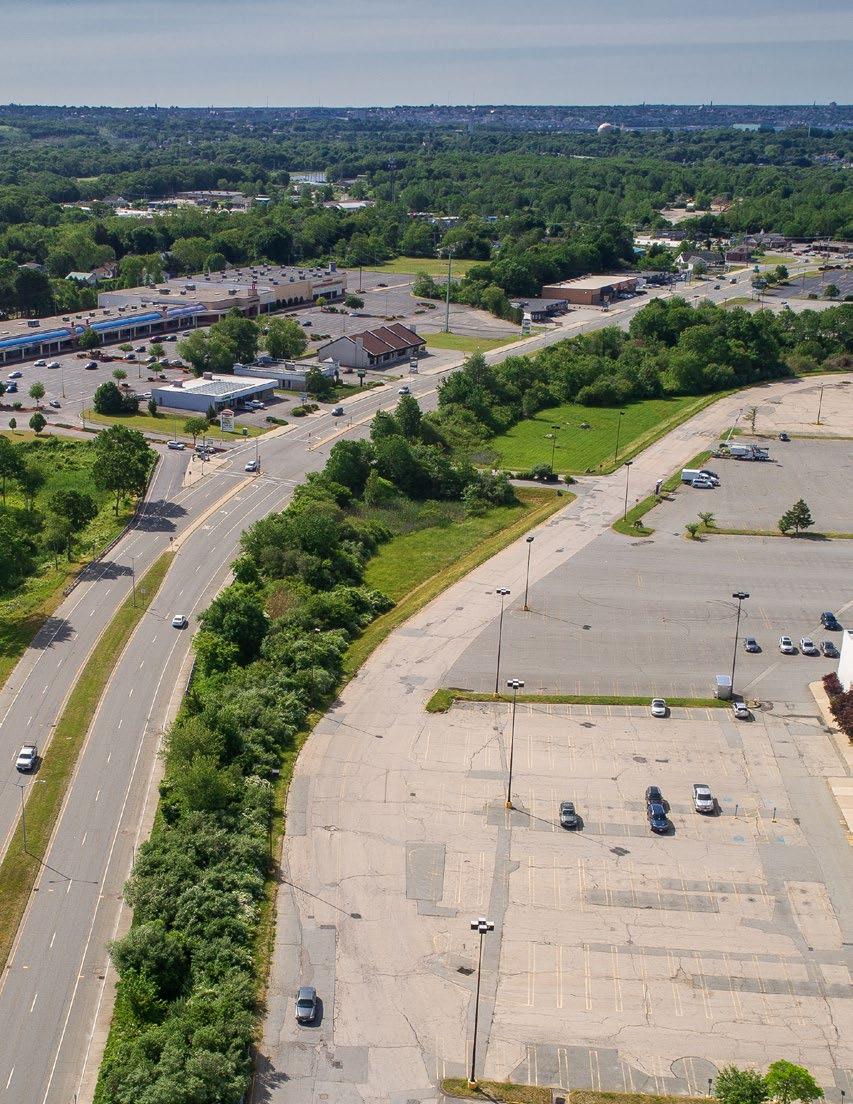
Photo 52. Route 118. Kevin Ham, SRPEDD.
Strategy 8.3-1 Conduct a mobility and land-use study on Route Wilbur Ave / Route 103 to explore creating a walkable, neighborhood center for Ocean Grove.
Performance Measures
Priority: High
Year 1-3: Conduct study of Route 103, exploring transportation / mobility, housing, and economic development.
Year 4 and on: Implement the findings of the Route 103 Study.
Complementary Goals and Strategies
1.2-2 Implement Design Guidelines or Standards at key locations in town, such as Route 103.
Goal 3.2 Support the continued growth of new and existing local businesses at key locations in town.
7.1-1 Explore the feasibility of upgrading Town-owned properties such as the Council on Aging, and the Town Annex to enable use of its facilities.
8.1-4 Work with MassDOT to conduct Road Safety Audits (RSAs) on stateowned roadways and intersections with a high number of crashes and safety concerns; implement items previously identified through RSAs.
8.1-5 Continue to construct high priority “Complete Streets” improvements in Partnership with MassDOT.
Responsible Party
Planning Board and Town Planner
Wilbur Avenue / Route 103 is a nearly 5-mile long east-west highway that runs from Warren Rhode Island, through Swansea, and into Somerset. The Swansea portion serves as a commercial thoroughfare through the Ocean Grove neighborhood before connecting, through Somerset, to Slade’s Ferry and terminating at Route 6.
The road has significant regional potential as a connector of economic hubs in each community it traverses. However, much of the economic development and public realm potential along Route 103 remains yet to be realized, particularly in the Ocean Grove neighborhood. Buildings in Ocean Grove have sizable front setbacks, with large amounts of land dedicated to underutilized parking; frequent and large curb cuts providing entry into these parking lots, beyond what is necessary for a typical right- or left-hand vehicular turn; limited pedestrian amenities to enhance the public realm; and a significant portion of the road dedicated to an oversized and generally unused paved shoulder, which encourages higher speeds than are appropriate for the thoroughfare. While some of these obstacles may seem challenging, they also present significant opportunities to encourage small-scale commercial business development and a vibrant public realm in one of Swansea’s most beloved neighborhoods.
To better understand the thoroughfare’s potential for change, the Comprehensive Planning process included an exercise to get a sense of community preference. When presented with three schemes, survey respondents preferred a pedestrianized Route 103 in Ocean Grove, with widened sidewalks, pedestrian amenities, and enhanced plantings. This scheme aligned with town-wide feedback to identify and develop areas to support small-scale locally owned businesses.
Given Route 103’s potential and community sentiment for enhanced pedestrianization and local business development, Swansea should pursue an in-depth study for Route 103. This study can examine the potential for development along the corridor, exploring the scale, form, and style of buildings that could make this street a local destination. Additionally, the study should explore the types of public realm enhancements that can improve quality of life and support existing and future small businesses. It can also explore the east and west of Ocean Grove to look at bike lanes and other non-motorized transportation options to provide connections between more regional destinations, such as downtown Warren and Slade’s Ferry.
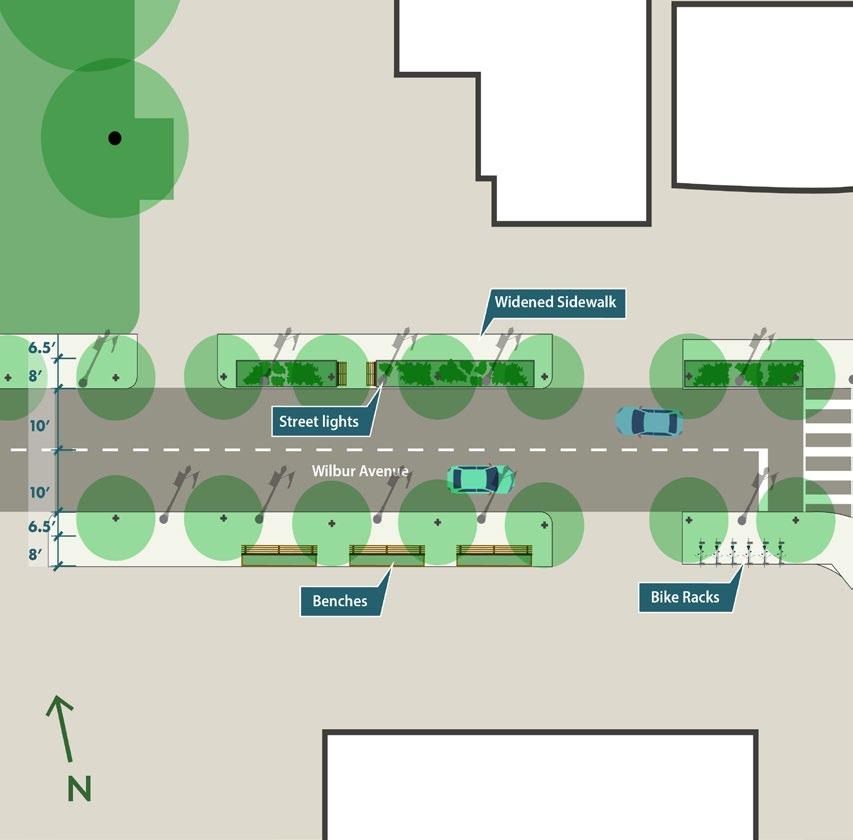
A Look at a Pedestrian-Oriented Route 103
Participants, through the public feedback process, expressed a desire to see the Town prioritize strategies that develop streetscape schemes, respondents and attendees from the Comprehensive Plan’s transportation workshop preferred create a ‘main street’ style destination for portions of Route 103.

develop Swansea’s economy with a focus on local dining, shopping, and walkability. When presented with various preferred for the above concept, which reflects these values and emphasizes pedestrian and public realm improvements to
Strategy 8.3-2 Implement findings from Route 118 and Route 6 Studies.
Performance Measures
Priority: High
Year 1: Complete studies for Routes 118 and Route 6.
Year 2-3: Work alongside State Agencies to coordinate implementation alongside other critical potential improvements, such as sewer implementation.
Year 4 and on: Conduct roadway improvements.
Complementary Goals and Strategies
1.1-3 Explore zoning changes to allow mixed-use, commercial development, and accessory commercial use, by-right, in key neighborhood centers such as Ocean Grove, Main Street, and portions of Route 6.
1.1-5 Pursue zoning changes or development proposals in concert with the findings on the Route 6 Study.
1.2-1 Explore implementing zoning mechanisms to preserve open space and natural resources in town, such as a Transfer of Development Rights By-law or an amended Open Space Residential Design By-law.
Goal 3.1 Explore new development opportunities along Route 6.
8.1-5 Continue to construct high priority “Complete Streets” improvements in Partnership with MassDOT.
Responsible Party
Planning Board, Town Planner, and Highway Department/Public Works
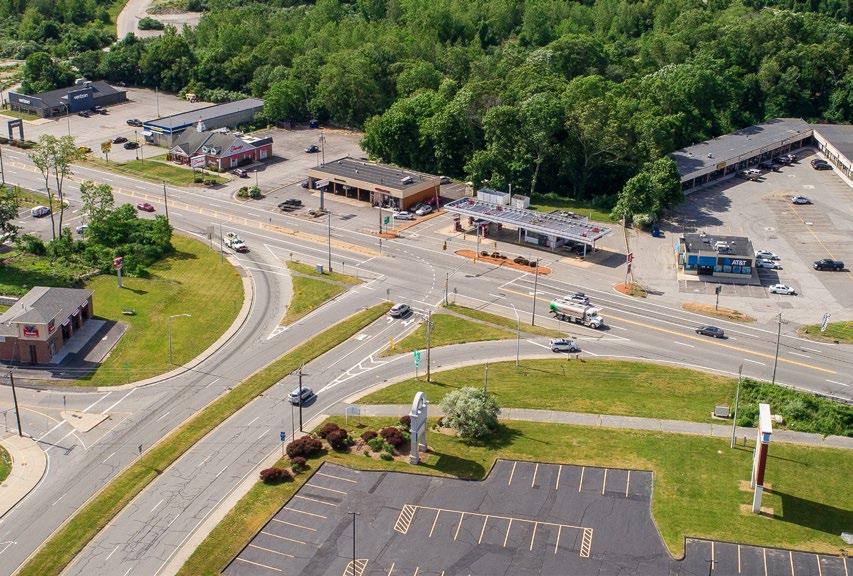
While previous goals and strategies covered the land use and economic development aspects of Swansea’s ongoing studies for Route 6 and Route 118, their findings will have significant transportation implications. Findings for both studies will take into consideration the current character and challenges for each thoroughfare, ongoing and proposed construction improvements related to safety and traffic, and public feedback.
Implementation of these studies’ findings will need to coordinate closely with, and
may influence or alter ongoing planning initiatives, such as the Town’s Complete Streets program. Additionally, the Town can utilize any design and engineering work associated with street redesigns to leverage and prioritize grant funding.
During feedback from open house events, participants identified the challenging nature they felt the town faces in retrofitting the streetscape of these roads. It will likely take several years for the future of both Route 6 and 118 to take shape; however, these studies provide the DNA to realize this future.
Photo 53. The Intersection of Route 118 and Route 6. Kevin Ham, SRPEDD.
Element 9: Implementation
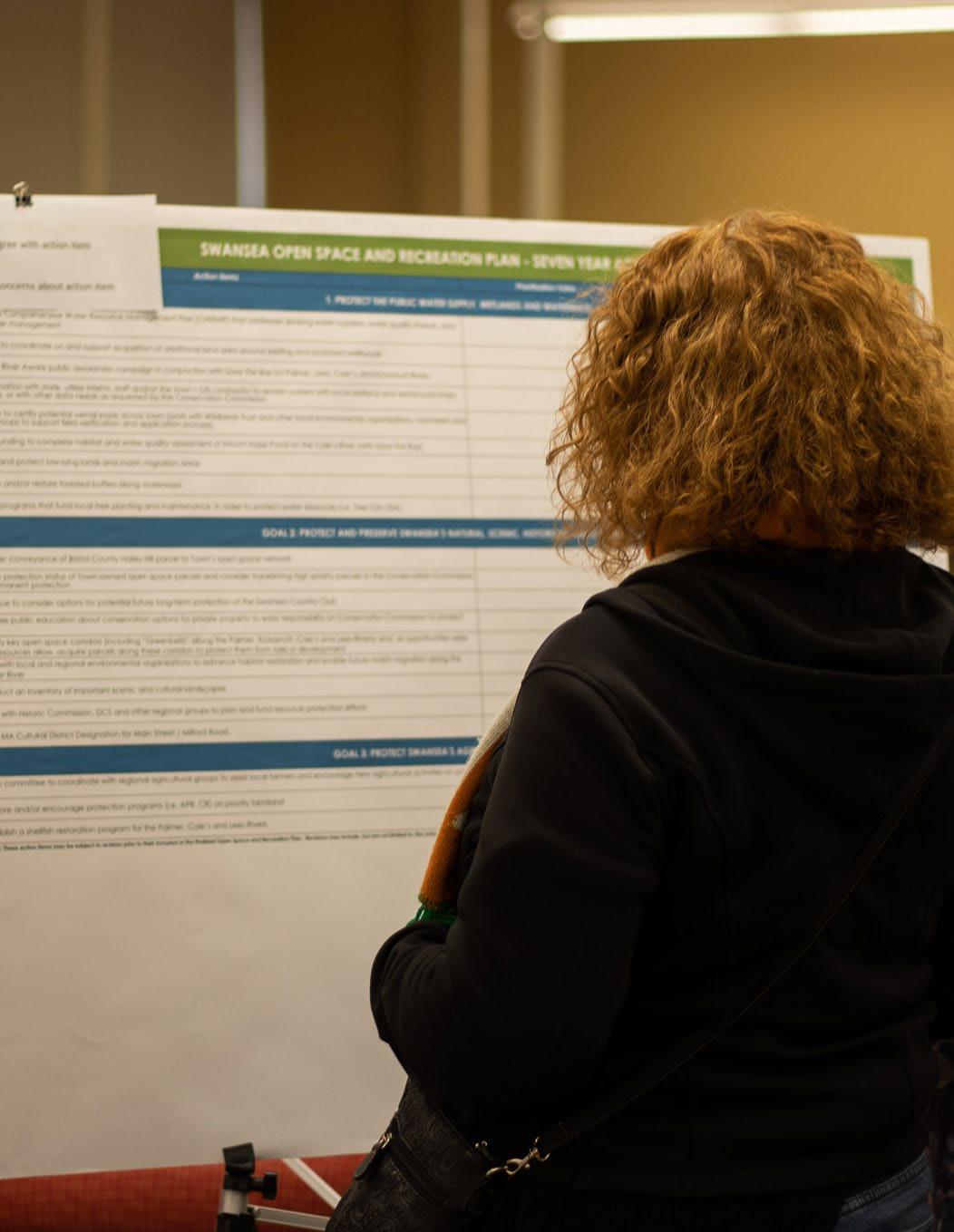
Photo 54. Workshop attendees at the Land Use, Housing, and Economic Development Workshop. Danyel Kenis, SRPEDD.

In Summary: Implementation
This Plan recommends numerous actions across many different plan elements. Making these recommendations a reality depends largely on the Town’s capacity to dedicate resources to the work and the capabilities needed to complete the recommendations. Many of these recommendations call on the same Town positions (as well as Boards and Commissions ) to implement the plan in addition to their other, day-to-day responsibilities. Additionally, in some cases, the Town may lack certain expertise to fulfill a recommendation without assistance from a partner agency or consultant. In order to fully implement this Comprehensive Plan, the Town should look at options to boost its capacity and capabilities, such as increasing staffing, hiring consultants where appropriate, and partnerships with stakeholders.
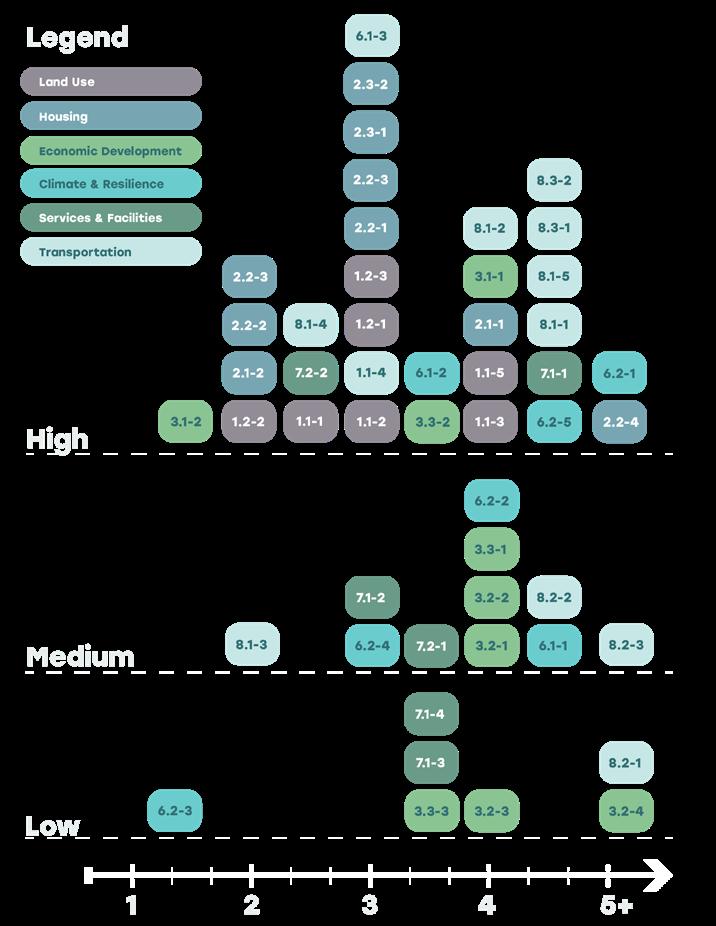
Prioritizing Strategies in the Plan
Like all municipalities, Swansea is constrained by its resources and staff capacity. This chart illustrates how the Comprehensive Plan's stakeholders have prioritized each action item described throughout the course of the document. The table organizes each task or strategy along an axis of 1 to 5 years of expected time for implementation. Each strategy also received a high, medium, or low designation. While these priorities will likely shift, in order of importance or time
to implement, during the lifecycle of this plan, this organizational matrix provides a framework and hierarchy for those responsible with implementing these goals and strategies.
This chart is intended to be printed to serve as a guide for municipal staff. Each strategy is also linked to the corresponding page for easy interaction.

Photo 55. Workshop attendees and Swansea Swansea Town Staff at the Transportation, Services, and Facilities Workshop. Taylor Perez, SRPEDD.
Goal 1.1: Review zoning by-laws to improve clarity and focus development in key areas of
1.1-1 Create path for the rectification of split-zoned lots and rezoning of lots with non-conforming uses. 1.1-3, 3.2-1, 3.3-3
1.1-2: Allow the sub-division of nonconforming lots in Ocean Grove to generate more developable parcels. 1.1-4, 1.2-2, 3.2-1, 8.3-1
1.1-3: Explore zoning changes to allow mixed-use, commercial development, and accessory commercial use, by-right, in key neighborhood centers such as Ocean Grove, Main Street, and portions of Route 6. 1.1-1, 1.2-2, 3.1, 3.2-1, 8.3
1.1-4: Implement key zoning amendments to create new housing opportunities for first time homebuyers, older adults wishing to downsize, and those with moderate or fixed incomes.
1.1-5: Pursue zoning changes or development proposals in concert with the findings on the Route 6 Study. 3.1, 8.3-2
Planning
Responsible Parties Main Steps
of town Board, Town Planner, Board of Appeals
Board, Town Planner, Board of Appeals
Board and Town Planner
Year 1: Town identifies instances of split-zoned proper ties in Swansea.
Year 2: Town leadership identifies remedies for split-zoned properties and proposes appropriate amendments to the zoning bylaw.
Year 2-3: Town passes necessary amendments to the zoning bylaw
Year 1: Town identifies parcels that could be affected by allowing subdivision of lots in Ocean Grove.
Year 2: Planner and associated staff identify the feasibility of and mechanisms for providing subdivisions to lots over 10,000 square feet in Ocean Grove.
Year 2-3: Draft and presentation of appropriate amendments to the zoning by-law.
Year 3: Adoption of zoning by-law amendments
Year 1-2: Conduct detailed analyses of key areas to identify potential district locations for mixed-use commercial areas.
Year 3: Develop draft regulations and design guidelines for appropriate district(s)
Year 4: Adopt mixed-use by-law and guidelines
Board, Town Planner, and Board
Year 1-3: Evaluate the above measures and implement alongside or as par t of other complementary goals in this Plan, as well as ongoing town-wide initiatives.
Board, Town Planner, and Board of Appeals
Year 1: Review findings and prioritize relevant parcels according to their development potential to identify those that are most actionable.
Year 1-2: Pursue development agreements for development-ready locations.
Year 3-4: Pursue any appropriate zoning changes
1.2: Create zoning mechanisms to preserve critical environmental and historic features.
1.2-1: Explore implementing zoning mechanisms to preserve open space and natural resources in town, such as a Transfer of Development Rights By-law or an Open Space Residential Design By-law.
Goal 3.1, OSRP Goal 2
1.2-2: Implement Design Guidelines or Standards at key locations in town, such as Route 103. 1.1-1, 3.1, 3.2-1, 8.3
1.2-3: Create a Demolition Delay By law for historic properties.
OSRP Objective 2C
High Town Planner, Redevelopment
Planning Board, Zoning Board
2.1: Continue to produce SHI-eligible units to achieve the Commonwealth’s required amount
2.1-1: Collaborate on “friendly 40Bs” in partnership with developers to produce affordable housing units.
2.1-2, 2.2-2
2.1-2: Pursue partnerships leading to development that is affordable to those with low, moderate, and fixed incomes. 2.1-1, 2.2-2
Planning Board, Board of Appeals,
Planning Board, Town Planner
Planner, Town Administrator, Redevelopment Authority
Board and Town Planner
Year 1: Begin an education campaign to explain the benefits of a TDR and evaluate the feasibility of the process.
Year 2: Begin public review process to establish TDR sending (preservation) and receiving (development) areas. Align this work with the town’s 2023 PDAs and PPAs.
Year 3: Approve TDR bylaw by simple majority. Establish an intermediary “land bank” held by a conservation agency to streamline “swaps.”
Board, Town Planner, and Board of Appeals
Year 1-2: Align the development of design guidelines or standards with any zoning by-law changes / implementation of overlay zones and develop a set of visual recommendations to support t the goals of each by-law change.
Year 1: The Town will determine if it is appropriate to pursue a demolition delay bylaw and present it to the Planning Board.
Year 2: The Town will draft and present the implications of a Demolition Delay Bylaw.
Year 2-3: The Town will carry out an educational campaign to share information about the Demolition Delay Bylaw to residents.
Year 3: The Town will present the Demolition Delay Bylaw at Fall Town Meeting by 2026
amount and to support communities in need.
Year 1: The Town will have determined an eligible parcel to undergo the RFP process through LIP.
Year 2: The Town will have released an RFP for the eligible parcel.
Board, Select Board, Zoning Appeals, and Town Planner
Year 2-3: The Town will have selected a developer to partner with through the RFP process.
Year 4: The Town and partnered developer will have applied for a Comprehensive Permit through LIP
Board, Select Board, and Planner
Year 1: The Town will have inventoried all town-owned parcels and evaluated their eligibility for housing development.
Year 2: The Town will work with a local non-profit partner or developer to produce small-scale affordable housing on a town owned site.
2.2: Produce housing options for older adults to support aging in place and for adults with
2.2-1: Amend Town Accessory Apartment By-law to encourage its intended uses.
2.2-2: Pursue partnerships and funding resources to provide direct assistance to help preserve housing for vulnerable communities, including senior residents.
2.2-3: Create new zoning by-laws that support aging in place, such as an Adult Retirement Community By-law.
2.2-4: Begin a Housing Rehabilitation and Repair Program
2.3-2
Board, Town Planner
Planner, Redevelopment
Board, Town Administrator
2.3: Pursue funding and professional support to implement new housing strategies.
2.3-1: Consider hiring a consultant to assist in implementing the strategies within the Housing Production Plan.
2.3-2: Create a Municipal Affordable Housing Trust.
2.3-3: Explore the feasibility of becoming a Housing Choice Designated community.
with disabilities and/or chronic illnesses.
Year 1: Work with a consultant to review the Accessory Apartment By-law.
Board, Select Board, and Planner
Planner, Town Administrator, and Redevelopment Authority
Board, Select Board, and Planner
Year 2: Present draft amendments to the By-law to the relevant boards and the public.
Year 3: Incorporate stakeholder feedback and present the By-law for adoption at Town Meeting.
Year 1: Inventory current funding streams and evaluate gaps.
Year 2: Apply for relevant funding opportunities, including the Commonwealth's CDBG grant round.
Year 1: The Town will have evaluated comparable ARC bylaws.
Year 2: The Town will have written a draft ARC bylaw.
Year 3: The Town will have brought the new ARC bylaw to Town Meeting for resident vote
Year 1: Explore funding and programmatic opportunities through CDBG, CPA, and the GATHC.
Board, Town Planner, and Administrator
Year 2: Work with regional partners to tap into existing funds or pursue new funds for a Home Rehab and Repair Program.
Year 3-4 (if creating a new program): Establish criteria for applications using local precedents as references.
Year 5 and on: Open the program for applications.
Board, Select Board, Town and Town Administrator
Board, Town Planner, and Administrator
Year 1: Solicit opportunities to hire a consultant.
Year 2: Hire a consultant to assist the Town with implementing the findings of the Comprehensive Plan and Housing Production Plan.
Year 3 and on: Evaluate ongoing progress with implementing the Plans and hire consultants as needed
Year 1: Attend statewide training conducted by agencies such as MHP on establishing a Municipal Affordable Housing Trust.
Year 2: Review the opportunity to establish a Trust with relevant boards and the public.
Year 3: Incorporate stakeholder feedback and present the proposal for adoption at Town Meeting.
Board, Select Board, and Planner
Year 1: The Town will have evaluated their housing production determine if they are eligible for Housing Choice Designation.
Year 2: If eligible, the Town will have applied for Housing Choice Designation, either with or without Housing Best Practices.
3.1: Explore new development opportunities along Route 6.
3.1-1: Build on the 2021 Wastewater Service IMA with Somerset and the 20232024 Route 6/Route 118 Study to Foster Economic and Community Development.
3.1-2: Work with the Swansea Redevelopment Authority to pursue an Urban Renewal Plan and detailed proposals for the former Swansea Mall site.
3.1-2 High Department Planner, and
3.1-1; Goal 3.2; 8.3-2 High Redevelopment Planner, and
3.2: Support the continued growth of new and existing local businesses at key locations
3.2-1: Identify constraints that are limiting the development of small businesses and inventory locations in town where they may thrive while connecting these businesses to funding sources.
Goal 1.1; 3.1-1; 3.2-3; 3.3-1; 3.3-3 Medium Planning Board, Clerk, and
3.2-2: Explore public realm opportunities - such as public space improvements and plantings - to enhance Swansea’s sense of place.
3.2-3: Create a formal organization for local small business owners.
3.2-3; 6.2-4; 7.2-1; 8.1-5; 8.2-3; 8.3-1; 8.3-2 Medium Planning Board
Goal 3.1; 3.2-1; 3.2-2; 8.3-1 Low Town Planner
3.2-4: Support new Agritourism opportunities in Swansea.
3.2-1; 3.2-3; OSRP Objective 2C; OSRP Objective 3A Low
Planning Board, Clerk, and
Department of Public Works, Town and Town Administrator
Redevelopment Authority, Town and Town Administrator
locations in town.
Board, Town Planner, Town Select Board
Year 1: Maintain ongoing, constructive conversations with Somerset, MassDOT, EOED, and U.S. EDA.
Year 2: Complete the Route 6/Route 118 Corridor Study. Ensure that the plan and resulting public-private partnerships identify both mixed-use and commercial/industrial sites and result in private sector commitments for investment and growth.
Year 3-4: Pursue U.S. EDA- or Commonwealth-funded design and engineering and construction awards for wastewater infrastructure.
Year 1-2: Complete an Urban Renewal Plan and obtain approval from the Commonwealth
Board and Town Planner
Year 1: Consider approach options including a stand-alone study, or integration of exploration regarding small business constraints into existing or proposed studies.
Year 2: Explore funding through Commonwealth programs to fund necessary study(s).
Year 3: Completion of work and summarization of findings.
Year 4 and on: Implementation of findings in Town zoning and business practices
Year 1-2: Identify potential public realm projects and improvements. Pursue high priority, and / or easy to implement projects.
Year 3: Identify scopes of work, secure funding, and conduct analysis with appropriate consultants for more intensive projects.
Year 4 and on: Implement high-priority, larger-scale improvements.
Year 1: Explore the creation of, and derive format for a formal small business organization
Year 2-3: Develop charter(s) and legally establish the appropriate organization(s) to represent small businesses.
Year 4 and on: Support initiatives from small business organizations
Board, Town Planner, Town Zoning Board of Appeals
Year 1-2: Conduct detailed public feedback related to town sentiment for agritourism (locations, properties, strategies, etc.).
Year 3-4: Assist with securing funding for targeted farm locations.
Year 5 and on: Support implementation of agritourism businesses.
Planner and Select Board
3.3: Simplify the permitting process to make development more accessible.
3.3-1: Implement a new e-permitting process for all departments in town.
3.2-1; 3.3-3
3.3-2: Promote the PACE Program to allow for clean energy improvements on commercial properties to be privately financed and paid back through betterments on the town’s tax bills. Goal 1.1; 2.1-5; 6.2-1
Medium Town Planner
3.3-3: Update and publicize Swansea’s user-friendly Development and Permitting Guide to facilitate business development
6.1: Develop Town facilities and infrastructure to increase climate resilience.
6.1-1: Ensure vulnerable populations, including older adults/senior residents, have access to air conditioning during heat events
6.1-2; 6.1-4; 7.1-1
Medium
Town Planner, Conservation,
6.1-2: Continue to explore opportunities to expand Swansea’s water capacity through infrastructure improvements and new IMAs with neighboring RI communities and Somerset OSRP Goal 1, 6.1-4 High Town Planner, Public Works
6.1-3: Increase awareness of local evacuation routes, emergency shelters, and Town resources.
6.1-1, 7.2-2
High Town Planner, Fire Department, and Building
and Town Clerk
Board, Town Planner, and Department
Year 1-2: Hire any necessary consultants to integrate e-permitting infrastructure
Year 3: Conduct trials with businesses in town to ensure e-permitting process is navigable.
Year 4: Implement new e-permitting.
Year 1-2: Create promotional materials/implement information about PACE Program into existing Town outreach formats.
Year 3 and on: Work with businesses to increase participation in PACE Program
Year 1: Increase awareness of Town permitting guide and procedures through existing outreach mechanisms.
Board, Town Planner, Town Zoning Board of Appeals
Planner, Planning Board, Conservation, and Building Dept
Year 2: Identify and make any necessary substantial changes to the permitting guide. Pursue funding through Community Compact Cabinet if necessary.
Year 3 and on: Expand and adapt guide as necessary
Planner, Town Administrator, and Works
Year 1: Identify current/potential locations for cooling stations and determine the feasibility of applying for Green Communities Designation.
Year 1-2: Identify changes necessary for Designation OR Apply for Green Communities Designation if all criteria are met.
Year 2-3: Ensure that Town is providing adequate cooling at these locations. If eligible, apply for a Green Communities grant.
Year 4 and on: Expand and adapt por tfolio of cooling stations as necessary. If eligible, continue applying for Green Communities competitive grants.
Year 1-2: Evaluate town needs for water moving forward. → Year 2-3: Conduct a study to align estimated capacity requirements with potential water sources and establish financing strategies that can support water capacity expansion.
Year 3 and on: Engage with municipal par tners to expand water capacity in Swansea as necessary
Planner, Highway Department, Department, Police Department, Building Department
Year 1: Identify critical evacuation routes and ensure that current list is compatible with projected sea level rise and development patterns. The Town can explore the MVP 2.0 Grant Program for potential funding options to update prioritization from the Town’s 2018 Plan.
Year 2: Conduct community outreach to raise awareness about storm and hazard preparedness.
Year 3: Secure funds and implement signage along evacuation routes.
Planner
6.2: Increase coastal resilience through new programs and adaptation strategies.
6.2-1: Allow compact, climate resilient adaptations, including raised houses and vertical additions.
6.2-2: Explore participation in FEMA’s Community Rating Service program to bolster flood mitigation town-wide while also reducing flood insurance premiums
Goal 6.1, 6.2-2, 6.2-3, 6.2-4, 6.2-5 High
Planning Board, Commission, Building Inspector,
Goal 6.1; 6.2-1; 6.2-3; 6.2-4; 6.2-5 Medium
Planning Board, Commission, Town Planner
6.2-3: Evaluate the severity of coastal erosion and improve coastal buffers.
OSRP Goal 1, OSRP Goal 2, OSRP Goal 3 Low Conservation Conservation
6.2-5: Produce a Town-wide Climate Action Plan.
6.1-1, 6.1-3 High
Planning Board, Conservation Commission
Board, Conservation Commission, Conservation Agent, and Town Planner
Year 1-2: Identify locations in town and sections of by-law that may need increase flexibility to respond to potential flooding.
Year 3-4: Pass necessary amendments to Zoning By-laws.
Year 5 and on: Administer financial and informational resources for those who may need to retrofit their proper ty.
Board, Conservation Commission, Conservation Agent, and
Year 1: Evaluate if Swansea meets the criteria for reduction in insurance premium reduction through par ticipation in the Community Rating Service Program.
Year 2: Apply for eligibility and pursue any practice areas to earn additional credits.
Year 3: Continue to pursue practice areas to increase insurance discount
Conservation Commission and Conservation Agent
Board, Town Planner, Conservation Agent, and Conservation Commission
Year 1 and on: Continue to monitor the threat of coastal erosion and take proactive steps where necessary
Year 1: Pursue Coastal Zone Management (CZM) Plan funding or similar funding source, depending on the scope and limits of the Town’s climate action goals.
Year 2-3: Conduct planning analysis and public outreach.
Year 4 and on: Utilize plan to pursue funding for implementation projects.
7.1: Improve town-wide accessibility and services.
7.1-1: Explore the feasibility of moving the Council on Aging to Town Hall
7.1-2: Identify and implement appropriate modifications from the ADA Self-Evaluation & Transition Plan, with particular concern for seniors and individuals with disabilities at Town-owned facilities.
7.1-3: Develop a non-profit to fundraise for causes that could benefit the Town, including but not limited to improvements for the Fire Station, Town Hall, or DPW Facility
8.3-1
Planning Board, Administrator,
7.1-1, 7.2-2, 7.1-4, 7.2-1, 8.1-2
7.1-4: Explore cemetery expansion. OSRP Goal 4; 7.1-3
Planning Board, Board of Appeals, Town Administrator
Goal 7.2: Create new channels for local engagement and reinforce Swansea's community
7.2-1: Increase the publicity and number of cultural and community events in town, including pop-ups, food trucks, seasonal lights, etc.
7.2-2: Implement, refine, and promote a monthly email / newsletter to provide updates on town initiatives, events, etc.
3.3-3; 7.2-2
6.1-3; 7.2-1
Town Planner, Swansea Cable
Board, Town Planner, Town Administrator, Building Department
Department, Planning Board, Planner
Year 1-2: Complete design and engineering studies. Hold public outreach about proposed design for Council on Aging and Town Hall
Year 3: Hold Town vote on construction of Town facilities and secure additional funding when available.
Year 4 and on: Begin construction
Year 1: Review existing ADA Transition Plan for high priority and implementable projects at existing Town facilities.
Year 2-3: Secure funding for and implement high priority ADA projects at Town facilities
Administrator and Select Board
Board, Select Board, Zoning Appeals, Town Planner, and Administrator
community identity.
Board, Town Planner, Police and Town Administrator
Year 1-2: Explore mechanisms, requirements, and legal framework for developing a nonprofit for fundraising in Town.
Year 2-3: Pursue the filing for and development of non-profit.
Year 3 and on: Identify key areas for fundraising and begin accepting donations.
Year 1-2: Identify capacity and need for cemetery expansion.
Year 3 and on: Secure parcels for expansion.
Year 1: Identify potential program par tners, preliminary schedule of dates for a small ‘Placemaking’ events program.
Year 2: Adver tise and execute a pilot program for community events.
Year 3 and on: Expand program as necessary, implement permanent improvements to public spaces as appropriate.
Planner, Town Administrator, and Cable Access
Year 1: Finalize and release newsletter.
Year 2 and on: Continue to refine newsletter to ensure its success
Goal 8.1: Improve pedestrian access and safety.
8.1-1: Expand SRTA access throughout town and install new supportive infrastructure, including signage and bus shelters Goal 3; 8.1-2; 8.2-1; 8.3-2 High
Town Planner, Highway Department/Public
8.1-2: Expand Town-facilitated ride services for older adults and individuals with disabilities.
2.2; 8.1-1; 8.2-1 High
8.1-3: Establish a Traffic Safety Committee to receive traffic feedback from residents, identify safety issues in town, and suggest improvements. Goal 8.1-4; 8.1-5 Medium
8.1-4: Work with MassDOT to conduct Road Safety Audits (RSAs) on state owned roadways and intersections with a high number of crashes and safety concerns; implement items previously identified through RSAs.
8.1-5: Continue to construct high priority “Complete Streets” improvements in Partnership with MassDOT.
8.1-3; 8.1-5; Goal 3.1; Goal 8.3
High
Town Planner, Public Works, Select Board
Town Planner, Public Works,
8.1-4; 8.1-3; 8.2-2;8.2-3; Goal 8.3 High
Town Planner, Parks and Recreation, Department/Public Planning Board
Town Planner, Council on
Planner, Town Administrator, and Department/Public Works
Year 1-2: Communicate with SRTA about Town needs; address areas of need for access; and inventory potential high use locations for bus shelters and other infrastructure/amenities.
Year 2-3: Pursue funding, alongside SRTA and SRPEDD for infrastructure improvements (utilizing current State transportation improvements, grants via SRTA, and sources such as CDBG).
Year 4 and on: Implement route and infrastructure upgrades
Planner, Town Administrator, and Aging
Year 1-2: Conduct a study to understand the need for Town facilitated ride services, as well as gaps in SRTA’s service that the Town can pick up. Coordinate ride assistance with proposals for potential future COA location.
Year 2-3: Pursue funding sources to provide resources towards expanding Town-facilitated ride services.
Year 3-4: Implementation of service expansion
Planner, Highway Department/ Works, Planning Board, and Board
Planner, Highway Department/ Works, and Planning Board
Year 1: Solicit interest for par ticipating in a Traffic Safety Committee.
Year 2: Create a by-law establishing rules, purpose, and organizational principles for Traffic Safety Committee.
Year 1: Utilize feedback from Comprehensive Plan and SRPEDD crash data to establish list of Communities for Road Safety Audits.
Year 2 and on: Coordinate with MassDOT to conduct Road Safety Audits
Planner, Town Administrator, Recreation, Highway Department/Public Works, and Board
Year 1-3: Continue to implement highest priority projects that are currently identified in the complete streets plan.
Year 4 and on: Regularly work with Town staff to the public to update the plan by identifying future projects that
8.2: Explore new transportation opportunities throughout town.
8.2-1: Pursue electric and hybrid options for town vehicle fleets and install additional electric vehicle charging stations along high-traffic routes 3.3-2; 6.1-4; 7.1-3 Low
Town Administrator, Highway Department/Public Building Commissioner, Board, and
8.2-2: Consider adjustments to the South Coast Bikeway to route through Ocean Grove. 1.1-3; 1.2-2; 3.2-2; 8.1-5; 8.2-3; 8.3-1 Medium
Town Planner, Parks and Recreation, Board
8.2-3: Explore non-motorized transportation access to natural, cultural, and coastal resources in town, including the creation of new walking, biking, and hiking trails 6.2-4; 8.1-5; 8.2.2 Medium
Town Planner, Parks and Recreation, Agent, and
8.3: Develop key routes to support economic development and improve quality of life.
8.3-1: Conduct a mobility and land use study on Route Wilbur Ave / Route 103 to explore creating a walkable, neighborhood center for Ocean Grove. 1.2-2; 3.2-1; 3.2-2; 3.2-3; 7.1-1; 8.1-4; 8.1-5
High
Planning Board
8.3-2: Implement findings from Route 118 and Route 6 Studies 1.1-3; 1.1-5; 1.2-1; Goal 3.1; 8.1-5 High
Planning Board, Highway Department/Public
Administrator, Town Planner, Department/Public Works, Commissioner, Planning and Select Board
Planner, Town Administrator, Recreation, and Planning
Year 1: Pursue grant oppor tunities to expand EV fleet and provide EV charging in Town.
Year 2-4: Enable pilot program to explore electrifying por tion of the Town’s vehicle fleet.
Year 5 and on: Continue to conver t Town vehicle fleet to electric, while providing EV charging throughout Swansea
Planner, Town Administrator, Recreation, Conservation and Planning Board
Year 1-2: Work with advocacy groups and perform public outreach to explore alternatives to the current proposed configuration of the South Coast Bikeway.
Year 2-3: Modify any necessary documents ( i.e. Complete Streets) to reflect any changes.
Year 4 and on: Secure funding for and conduct implementation of South Coast Bikeway sections.
Year 1: Explore feasibility of and prioritize projects identified through public feedback.
Year 2-6: Secure funding for (Consider programs such as PARC grants or Land Management Agreements) and implement high priority projects
Board and Town Planner
Board, Town Planner, and Department/Public Works
Year 1-3: Conduct study of Route 103, exploring transpor tation / mobility, housing, and economic development.
Year 4 and on: Implement the findings of the Route 103 Study
Year 1: Complete studies for Routes 118 and Route 6.
Year 2-3: Work alongside State Agencies to coordinate implementation alongside other critical potential improvements, such as sewer implementation.
Year 4 and on: Conduct roadway improvements
